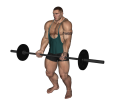 Barbell Curl - Basic
Barbell Curl - Basic
Benefits: This exercise works both heads of the biceps with a heavier weight than can typically be done with dumbbells. Moving the elbows out at the top of the movement ensures that the long head of the biceps (which crosses the shoulder joint) is also worked well.
Purpose: This exercise is used to target the biceps muscle to develop size, definition, strength, endurance and power.
Beginner Biceps Forearms Shoulders Strength Barbell Pull Gym
General Info: The biceps is a straight muscle with two heads. The long head of the biceps crosses both the elbow and the shoulder joint. It bends the elbow and raises the arm forward at the shoulder. The short head crosses the elbow joint and, in conjunction with the brachioradialis, supinates the hand.
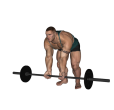 Barbell Curl - Bent Over
Barbell Curl - Bent Over
Benefits: This exercise is similar in effect to the Spider curl and does a good job of placing maximum tension on the biceps in the fully contracted position.
Purpose: This exercise works the biceps muscles but focuses also on the brachioradialis (a muscle that crosses the elbow joint and assists in rotating the forearm).
Beginner Biceps Forearms Shoulders Strength Barbell Pull Gym
General Info: The biceps is a straight muscle that has two heads. The long head crosses both the elbow and the shoulder joints. It bends the arm at the elbow and raises the arm forward at the shoulder. The short head crosses the elbow joint and, in conjunction with the brachioradialis, supinates the hand.
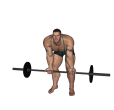 Barbell Curl - Bent Over Close Grip
Barbell Curl - Bent Over Close Grip
Benefits: This exercise is similar in effect to the Spider curl and does a good job of placing maximum tension on the biceps in the fully contracted position.
Purpose: This exercise works the biceps muscles but focuses also on the brachioradialis (a muscle that crosses the elbow joint and assists in rotating the forearm).
Beginner Biceps Forearms Shoulders Strength Barbell Pull Gym
General Info: The biceps is a straight muscle that has two heads. The long head crosses both the elbow and the shoulder joints. It bends the arm at the elbow and raises the arm forward at the shoulder. The short head crosses the elbow joint and, in conjunction with the brachioradialis, supinates the hand.
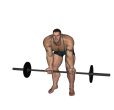 Barbell Curl - Bent Over Medium Grip
Barbell Curl - Bent Over Medium Grip
Benefits: This exercise is similar in effect to the Spider curl and does a good job of placing maximum tension on the biceps in the fully contracted position.
Purpose: This exercise works the biceps muscles but focuses also on the brachioradialis (a muscle that crosses the elbow joint and assists in rotating the forearm).
Beginner Biceps Forearms Shoulders Strength Barbell Pull Gym
General Info: The biceps is a straight muscle which has two heads. The long head crosses both the elbow and the shoulder joints. It bends the arm at the elbow and raises the arm forward at the shoulder. The short head crosses the elbow joint and, in conjunction with the brachioradialis, supinates the hand.
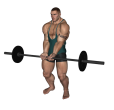 Barbell Curl - Close Grip Standing
Barbell Curl - Close Grip Standing
Benefits: This exercise works both heads of the biceps with a heavier weight than can typically be done with dumbbells. Using a close grip on the barbell gives you a different angle and feel for the exercise.
Purpose: This exercise is used to target the biceps muscle to develop size, definition, strength, endurance and power.
Beginner Biceps Forearms Strength Barbell Pull Gym
General Info: The biceps is a straight muscle with two heads. The long head of the biceps crosses both the elbow and the shoulder joint. It bends the elbow and raises the arm forward at the shoulder. The short head crosses the elbow joint and, in conjunction with the brachioradialis, supinates the hand.
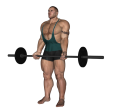 Barbell Curl - Drag
Barbell Curl - Drag
Benefits: This exercise works both heads of the biceps with a heavier weight than can typically be done with dumbbells. This exercise will go a long way toward eliminating anterior deltoid involvement as you curl, helping you isolate the working muscle in a way that the standard barbell may not.
Purpose: This exercise is used to target the biceps muscle to develop size, definition, strength, endurance and power.
Intermediate Biceps Forearms Shoulders Strength Barbell Pull Compound Gym
General Info: The biceps is a straight muscle with two heads. The long head of the biceps crosses both the elbow and the shoulder joint. It bends the elbow and raises the arm forward at the shoulder. The short head crosses the elbow joint and, in conjunction with the brachioradialis, supinates the hand.
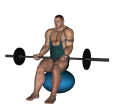 Barbell Curl - Fitness Ball
Barbell Curl - Fitness Ball
Benefits: This exercise isolates the biceps so that momentum does not come into play.
Purpose: This exercise strengthens the biceps.
Beginner Biceps Forearms Shoulders Traps Strength Barbell Fitness Ball Pull Gym
General Info: The biceps muscle is a straight muscle with 2 heads. The long head crosses both the elbow and shoulder joints and bends the elbow and raises the arm forward at the shoulder. The short head of the biceps crosses the elbow joint and, in conjunction with the brachioradialis, supinates the hand..
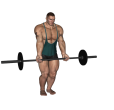 Barbell Curl - Narrow Stance
Barbell Curl - Narrow Stance
Benefits: This exercise works both heads of the biceps with a heavier weight than can typically be done with dumbbells. The narrow stance forces the stabilizing muscles to work harder in keeping the body upright.
Purpose: This exercise is used to target the biceps muscle to develop size, definition, strength, endurance and power.
Beginner Biceps Forearms Shoulders Strength Barbell Pull Gym
General Info: The biceps is a straight muscle with two heads. The long head of the biceps crosses both the elbow and the shoulder joint. It bends the elbow and raises the arm forward at the shoulder. The short head crosses the elbow joint and, in conjunction with the brachioradialis, supinates the hand.
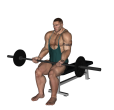 Barbell Curl - Seated
Barbell Curl - Seated
Benefits: This exercise isolates the biceps so that momentum does not come into play.
Purpose: This exercise strengthens the biceps.
Beginner Biceps Forearms Shoulders Traps Strength Barbell Flat Bench Pull Gym
General Info: The biceps muscle is a straight muscle with 2 heads. The long head crosses both the elbow and shoulder joints and bends the elbow and raises the arm forward at the shoulder. The short head of the biceps crosses the elbow joint and, in conjunction with the brachioradialis, supinates the hand..
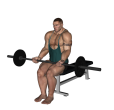 Barbell Curl - Seated Narrow Stance
Barbell Curl - Seated Narrow Stance
Benefits: This exercise isolates the biceps so that momentum does not come into play. the narrow stance forces the stabilizer muscles to assist in keeping the body upright.
Purpose: This exercise strengthens the biceps.
Beginner Biceps Forearms Shoulders Traps Strength Barbell Flat Bench Pull Gym
General Info: The biceps muscle is a straight muscle with 2 heads. The long head crosses both the elbow and shoulder joints and bends the elbow and raises the arm forward at the shoulder. The short head of the biceps crosses the elbow joint and, in conjunction with the brachioradialis, supinates the hand..
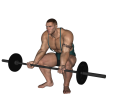 Barbell Curl - Squat
Barbell Curl - Squat
Benefits: This exercise isolates the biceps so that momentum does not come into play.
Purpose: This exercise strengthens the biceps.
Intermediate Biceps Forearms Shoulders Traps Strength Barbell Pull Gym
General Info: The biceps muscle is a straight muscle with 2 heads. The long head crosses both the elbow and shoulder joints and bends the elbow and raises the arm forward at the shoulder. The short head of the biceps crosses the elbow joint and, in conjunction with the brachioradialis, supinates the hand..
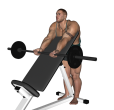 Barbell Curl - Standing Incline
Barbell Curl - Standing Incline
Benefits: This exercise works both heads of the biceps with a heavier weight than can typically be done with dumbbells. Placing the triceps on the incline bench makes the exercise similar to a preacher curl, which isolated the biceps.
Purpose: This exercise is used to target the biceps muscle to develop size, definition, strength, endurance and power.
Beginner Biceps Forearms Shoulders Strength Barbell Incline Bench Pull Gym
General Info: The biceps is a straight muscle with two heads. The long head of the biceps crosses both the elbow and the shoulder joint. It bends the elbow and raises the arm forward at the shoulder. The short head crosses the elbow joint and, in conjunction with the brachioradialis, supinates the hand.
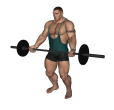 Barbell Curl - Wide Grip Standing
Barbell Curl - Wide Grip Standing
Benefits: This exercise works both heads of the biceps with a heavier weight than can typically be done with dumbbells. The wide grip gives you a different angle and feel to the exercise.
Purpose: This exercise is used to target the biceps muscle to develop size, definition, strength, endurance and power.
Beginner Biceps Forearms Shoulders Strength Barbell Pull Gym
General Info: The biceps is a straight muscle with two heads. The long head of the biceps crosses both the elbow and the shoulder joint. It bends the elbow and raises the arm forward at the shoulder. The short head crosses the elbow joint and, in conjunction with the brachioradialis, supinates the hand.
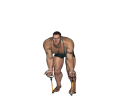 Biceps Curl - Bent Over Resistance Tube
Biceps Curl - Bent Over Resistance Tube
Benefits: This exercise is similar in effect to the Spider curl and does a good job of placing maximum tension on the biceps in the fully contracted position.
Purpose: This exercise works the biceps muscles but focuses also on the brachioradialis (a muscle that crosses the elbow joint and assists in rotating the forearm).
Beginner Biceps Forearms Shoulders Strength Resistance Tube Pull Gym Home
General Info: The biceps is a straight muscle which has two heads. The long head crosses both the elbow and the shoulder joints. It bends the arm at the elbow and raises the arm forward at the shoulder. The short head crosses the elbow joint and, in conjunction with the brachioradialis, supinates the hand.
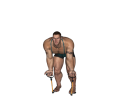 Biceps Curl - Bent Over Resistance Tube Alternate
Biceps Curl - Bent Over Resistance Tube Alternate
Benefits: This exercise is similar in effect to the Spider curl and does a good job of placing maximum tension on the biceps in the fully contracted position.
Purpose: This exercise works the biceps muscles but focuses also on the brachioradialis (a muscle that crosses the elbow joint and assists in rotating the forearm).
Beginner Biceps Forearms Shoulders Strength Resistance Tube Pull Gym Home
General Info: The biceps is a straight muscle which has two heads. The long head crosses both the elbow and the shoulder joints. It bends the arm at the elbow and raises the arm forward at the shoulder. The short head crosses the elbow joint and, in conjunction with the brachioradialis, supinates the hand.
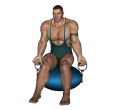 Biceps Curl - Resistance Tube Ball
Biceps Curl - Resistance Tube Ball
Benefits: This exercise isolates the biceps so that momentum does not come into play.
Purpose: This exercise strengthens the biceps.
Beginner Biceps Forearms Strength Fitness Ball Resistance Tube Pull Gym
General Info: The biceps muscle is a straight muscle with 2 heads. The long head crosses both the elbow and shoulder joints and bends the elbow and raises the arm forward at the shoulder. The short head of the biceps crosses the elbow joint and, in conjunction with the brachioradialis, supinates the hand..
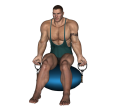 Biceps Curl - Resistance Tube Ball Alternate
Biceps Curl - Resistance Tube Ball Alternate
Benefits: This exercise isolates the biceps so that momentum does not come into play.
Purpose: This exercise strengthens the biceps.
Beginner Biceps Forearms Strength Fitness Ball Resistance Tube Pull Gym
General Info: The biceps muscle is a straight muscle with 2 heads. The long head crosses both the elbow and shoulder joints and bends the elbow and raises the arm forward at the shoulder. The short head of the biceps crosses the elbow joint and, in conjunction with the brachioradialis, supinates the hand..
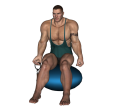 Biceps Curl - Resistance Tube Ball Single
Biceps Curl - Resistance Tube Ball Single
Benefits: This exercise isolates the biceps so that momentum does not come into play.
Purpose: This exercise strengthens the biceps.
Beginner Biceps Forearms Strength Fitness Ball Resistance Tube Pull Gym
General Info: The biceps muscle is a straight muscle with 2 heads. The long head crosses both the elbow and shoulder joints and bends the elbow and raises the arm forward at the shoulder. The short head of the biceps crosses the elbow joint and, in conjunction with the brachioradialis, supinates the hand..
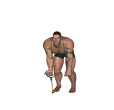 Biceps Curl - Resistance Tube Bent Over Single
Biceps Curl - Resistance Tube Bent Over Single
Benefits: This exercise isolates the biceps so that momentum does not come into play.
Purpose: This exercise strengthens the biceps.
Beginner Biceps Forearms Strength Resistance Tube Pull Gym Home
General Info: The biceps muscle is a straight muscle with 2 heads. The long head crosses both the elbow and shoulder joints and bends the elbow and raises the arm forward at the shoulder. The short head of the biceps crosses the elbow joint and, in conjunction with the brachioradialis, supinates the hand..
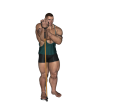 Biceps Curl - Resistance Tube Single
Biceps Curl - Resistance Tube Single
Benefits: This exercise works both heads of the biceps with a heavier weight than can typically be done with dumbbells.
Purpose: This exercise is used to target the biceps muscle to develop size, definition, strength, endurance and power.
Beginner Biceps Forearms Shoulders Strength Resistance Tube Pull Gym Home
General Info: The biceps is a straight muscle with two heads. The long head of the biceps crosses both the elbow and the shoulder joint. It bends the elbow and raises the arm forward at the shoulder. The short head crosses the elbow joint and, in conjunction with the brachioradialis, supinates the hand.
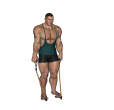 Biceps Curl - Resistance Tube Standing
Biceps Curl - Resistance Tube Standing
Benefits: This exercise works both heads of the biceps with a heavier weight than can typically be done with dumbbells.
Purpose: This exercise is used to target the biceps muscle to develop size, definition, strength, endurance and power.
Beginner Biceps Forearms Shoulders Strength Resistance Tube Pull Gym
General Info: The biceps is a straight muscle with two heads. The long head of the biceps crosses both the elbow and the shoulder joint. It bends the elbow and raises the arm forward at the shoulder. The short head crosses the elbow joint and, in conjunction with the brachioradialis, supinates the hand.
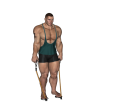 Biceps Curl - Resistance Tube Standing Alternate
Biceps Curl - Resistance Tube Standing Alternate
Benefits: This exercise works both heads of the biceps with a heavier weight than can typically be done with dumbbells.
Purpose: This exercise is used to target the biceps muscle to develop size, definition, strength, endurance and power.
Beginner Biceps Forearms Shoulders Strength Resistance Tube Pull Gym Home
General Info: The biceps is a straight muscle with two heads. The long head of the biceps crosses both the elbow and the shoulder joint. It bends the elbow and raises the arm forward at the shoulder. The short head crosses the elbow joint and, in conjunction with the brachioradialis, supinates the hand.
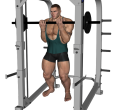 Biceps Curl - Smith Machine
Biceps Curl - Smith Machine
Benefits: This exercise works both heads of the biceps with a heavier weight than can typically be done with dumbbells.
Purpose: This exercise is used to target the biceps muscle to develop size, definition, strength, endurance and power.
Beginner Biceps Forearms Shoulders Strength Smith Machine Pull Gym
General Info: The biceps is a straight muscle with two heads. The long head of the biceps crosses both the elbow and the shoulder joint. It bends the elbow and raises the arm forward at the shoulder. The short head crosses the elbow joint and, in conjunction with the brachioradialis, supinates the hand.
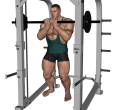 Biceps Curl - Smith Machine Close Grip
Biceps Curl - Smith Machine Close Grip
Benefits: This exercise works both heads of the biceps with a heavier weight than can typically be done with dumbbells.
Purpose: This exercise is used to target the biceps muscle to develop size, definition, strength, endurance and power.
Beginner Biceps Forearms Shoulders Strength Smith Machine Pull Gym
General Info: The biceps is a straight muscle with two heads. The long head of the biceps crosses both the elbow and the shoulder joint. It bends the elbow and raises the arm forward at the shoulder. The short head crosses the elbow joint and, in conjunction with the brachioradialis, supinates the hand.
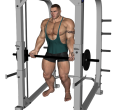 Biceps Curl - Smith Machine Wide Grip
Biceps Curl - Smith Machine Wide Grip
Benefits: This exercise works both heads of the biceps with a heavier weight than can typically be done with dumbbells.
Purpose: This exercise is used to target the biceps muscle to develop size, definition, strength, endurance and power.
Beginner Biceps Forearms Shoulders Strength Smith Machine Pull Gym
General Info: The biceps is a straight muscle with two heads. The long head of the biceps crosses both the elbow and the shoulder joint. It bends the elbow and raises the arm forward at the shoulder. The short head crosses the elbow joint and, in conjunction with the brachioradialis, supinates the hand.
 Biceps Curl - Squat Water Bottle
Biceps Curl - Squat Water Bottle
Benefits: This exercise isolates the biceps so that momentum does not come into play.
Purpose: This exercise strengthens the biceps.
Intermediate Biceps Forearms Shoulders Traps Strength Water Bottle Pull Home
General Info: The biceps muscle is a straight muscle with 2 heads. The long head crosses both the elbow and shoulder joints and bends the elbow and raises the arm forward at the shoulder. The short head of the biceps crosses the elbow joint and, in conjunction with the brachioradialis, supinates the hand..
 Biceps Curl - Squat Water Bottle Alternate
Biceps Curl - Squat Water Bottle Alternate
Benefits: This exercise isolates the biceps so that momentum does not come into play.
Purpose: This exercise strengthens the biceps.
Intermediate Biceps Forearms Shoulders Traps Strength Water Bottle Pull Home
General Info: The biceps muscle is a straight muscle with 2 heads. The long head crosses both the elbow and shoulder joints and bends the elbow and raises the arm forward at the shoulder. The short head of the biceps crosses the elbow joint and, in conjunction with the brachioradialis, supinates the hand..
 Biceps Curl - Squat Water Bottle Single
Biceps Curl - Squat Water Bottle Single
Benefits: This exercise isolates the biceps so that momentum does not come into play.
Purpose: This exercise strengthens the biceps.
Intermediate Biceps Forearms Shoulders Traps Strength Water Bottle Pull Home
General Info: The biceps muscle is a straight muscle with 2 heads. The long head crosses both the elbow and shoulder joints and bends the elbow and raises the arm forward at the shoulder. The short head of the biceps crosses the elbow joint and, in conjunction with the brachioradialis, supinates the hand..
 Biceps Curl - Squat Water Bottle Single Reverse
Biceps Curl - Squat Water Bottle Single Reverse
Benefits: This exercise isolates the biceps so that momentum does not come into play.
Purpose: This exercise strengthens the biceps.
Intermediate Biceps Forearms Shoulders Traps Strength Water Bottle Pull Home
General Info: The biceps muscle is a straight muscle with 2 heads. The long head crosses both the elbow and shoulder joints and bends the elbow and raises the arm forward at the shoulder. The short head of the biceps crosses the elbow joint and, in conjunction with the brachioradialis, supinates the hand..
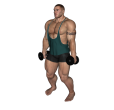 Biceps Curl - Standing Inner
Biceps Curl - Standing Inner
Benefits: This exercise works both heads of the biceps.
Purpose: This exercise is used to target the biceps muscle to develop size, definition, strength, endurance and power.
Beginner Biceps Forearms Shoulders Strength Dumbbell Pull Gym
General Info: The biceps is a straight muscle with two heads. The long head of the biceps crosses both the elbow and the shoulder joint. It bends the elbow and raises the arm forward at the shoulder. The short head crosses the elbow joint and, in conjunction with the brachioradialis, supinates the hand.
 Biceps Curl - Standing Water Bottle
Biceps Curl - Standing Water Bottle
Benefits: This exercise works both heads of the biceps with a heavier weight than can typically be done with dumbbells.
Purpose: This exercise is used to target the biceps muscle to develop size, definition, strength, endurance and power.
Beginner Biceps Forearms Shoulders Strength Water Bottle Pull Home
General Info: The biceps is a straight muscle with two heads. The long head of the biceps crosses both the elbow and the shoulder joint. It bends the elbow and raises the arm forward at the shoulder. The short head crosses the elbow joint and, in conjunction with the brachioradialis, supinates the hand.
 Biceps Curl - Standing Water Bottle Reverse Alternate
Biceps Curl - Standing Water Bottle Reverse Alternate
Benefits: This exercise works both heads of the biceps with a heavier weight than can typically be done with dumbbells.
Purpose: This exercise is used to target the biceps muscle to develop size, definition, strength, endurance and power.
Beginner Biceps Forearms Shoulders Strength Water Bottle Pull Home
General Info: The biceps is a straight muscle with two heads. The long head of the biceps crosses both the elbow and the shoulder joint. It bends the elbow and raises the arm forward at the shoulder. The short head crosses the elbow joint and, in conjunction with the brachioradialis, supinates the hand.
 Biceps Curl - Standing Water Bottle Single
Biceps Curl - Standing Water Bottle Single
Benefits: This exercise works both heads of the biceps with a heavier weight than can typically be done with dumbbells.
Purpose: This exercise is used to target the biceps muscle to develop size, definition, strength, endurance and power.
Beginner Biceps Forearms Shoulders Strength Water Bottle Pull Home
General Info: The biceps is a straight muscle with two heads. The long head of the biceps crosses both the elbow and the shoulder joint. It bends the elbow and raises the arm forward at the shoulder. The short head crosses the elbow joint and, in conjunction with the brachioradialis, supinates the hand.
 Biceps Curl - Suspended Chains
Biceps Curl - Suspended Chains
Benefits: This exercise is done with the addition of chains. The primary function of chains is to accommodate resistance. Chains are also a great means of weight loading (adding more weight to an exercise). Chains are also a great way for working the stabilizers.
Purpose: Benefits This exercise works both heads of the biceps and is great for working the stabilizers.
Beginner Biceps Forearms Shoulders Strength Chains Pull Gym
General Info: The biceps is a straight muscle with two heads. The long head of the biceps crosses both the elbow and the shoulder joint. It bends the elbow and raises the arm forward at the shoulder. The short head crosses the elbow joint and, in conjunction with the brachioradialis, supinates the hand.
 Biceps Curl - Water Bottle Alternate
Biceps Curl - Water Bottle Alternate
Benefits: This exercise works both heads of the biceps with a heavier weight than can typically be done with dumbbells.
Purpose: This exercise is used to target the biceps muscle to develop size, definition, strength, endurance and power.
Beginner Biceps Forearms Shoulders Strength Water Bottle Pull Home
General Info: The biceps is a straight muscle with two heads. The long head of the biceps crosses both the elbow and the shoulder joint. It bends the elbow and raises the arm forward at the shoulder. The short head crosses the elbow joint and, in conjunction with the brachioradialis, supinates the hand.
 Biceps Curl - Water Bottle Basic
Biceps Curl - Water Bottle Basic
Benefits: This exercise works both heads of the biceps.
Purpose: This exercise is used to target the biceps muscle to develop size, definition, strength, endurance and power.
Beginner Biceps Forearms Shoulders Strength Water Bottle Pull Home
General Info: The biceps is a straight muscle with two heads. The long head of the biceps crosses both the elbow and the shoulder joint. It bends the elbow and raises the arm forward at the shoulder. The short head crosses the elbow joint and, in conjunction with the brachioradialis, supinates the hand.
 Biceps Curl - Water Bottle Bent Over
Biceps Curl - Water Bottle Bent Over
Benefits: This exercise is similar in effect to the Spider curl and does a good job of placing maximum tension on the biceps in the fully contracted position.
Purpose: This exercise works the biceps muscles but focuses also on the brachioradialis (a muscle that crosses the elbow joint and assists in rotating the forearm).
Beginner Biceps Forearms Shoulders Strength Water Bottle Pull Home
General Info: The biceps is a straight muscle which has two heads. The long head crosses both the elbow and the shoulder joints. It bends the arm at the elbow and raises the arm forward at the shoulder. The short head crosses the elbow joint and, in conjunction with the brachioradialis, supinates the hand.
 Biceps Curl - Water Bottle Bent Over Alternate
Biceps Curl - Water Bottle Bent Over Alternate
Benefits: This exercise works both heads of the biceps with a heavier weight than can typically be done with dumbbells.
Purpose: This exercise is used to target the biceps muscle to develop size, definition, strength, endurance and power.
Beginner Biceps Forearms Shoulders Strength Water Bottle Pull Home
General Info: The biceps is a straight muscle with two heads. The long head of the biceps crosses both the elbow and the shoulder joint. It bends the elbow and raises the arm forward at the shoulder. The short head crosses the elbow joint and, in conjunction with the brachioradialis, supinates the hand.
 Biceps Curl - Water Bottle Bent Over Narrow
Biceps Curl - Water Bottle Bent Over Narrow
Benefits: This exercise is similar in effect to the Spider curl and does a good job of placing maximum tension on the biceps in the fully contracted position.
Purpose: This exercise works the biceps muscles but focuses also on the brachioradialis (a muscle that crosses the elbow joint and assists in rotating the forearm).
Beginner Biceps Forearms Shoulders Strength Water Bottle Pull Home
General Info: The biceps is a straight muscle which has two heads. The long head crosses both the elbow and the shoulder joints. It bends the arm at the elbow and raises the arm forward at the shoulder. The short head crosses the elbow joint and, in conjunction with the brachioradialis, supinates the hand.
 Biceps Curl - Water Bottle Seated
Biceps Curl - Water Bottle Seated
Benefits: This exercise isolates the biceps so that momentum does not come into play.
Purpose: This exercise strengthens the biceps.
Beginner Biceps Forearms Strength Water Bottle Chair Pull Home
General Info: The biceps muscle is a straight muscle with 2 heads. The long head crosses both the elbow and shoulder joints and bends the elbow and raises the arm forward at the shoulder. The short head of the biceps crosses the elbow joint and, in conjunction with the brachioradialis, supinates the hand..
 Biceps Curl - Water Bottle Seated Alternate
Biceps Curl - Water Bottle Seated Alternate
Benefits: This exercise isolates the biceps so that momentum does not come into play.
Purpose: This exercise strengthens the biceps.
Beginner Biceps Forearms Shoulders Traps Strength Water Bottle Chair Pull Home
General Info: The biceps muscle is a straight muscle with 2 heads. The long head crosses both the elbow and shoulder joints and bends the elbow and raises the arm forward at the shoulder. The short head of the biceps crosses the elbow joint and, in conjunction with the brachioradialis, supinates the hand..
 Biceps Curl - Water Bottle Seated Inner
Biceps Curl - Water Bottle Seated Inner
Benefits: This exercise isolates the biceps so that momentum does not come into play.
Purpose: This exercise strengthens the biceps.
Beginner Biceps Forearms Strength Water Bottle Chair Pull Home
General Info: The biceps muscle is a straight muscle with 2 heads. The long head crosses both the elbow and shoulder joints and bends the elbow and raises the arm forward at the shoulder. The short head of the biceps crosses the elbow joint and, in conjunction with the brachioradialis, supinates the hand..
 Biceps Curl - Water Bottle Seated Inner Alternate
Biceps Curl - Water Bottle Seated Inner Alternate
Benefits: This exercise isolates the biceps so that momentum does not come into play.
Purpose: This exercise strengthens the biceps.
Beginner Biceps Forearms Shoulders Traps Strength Water Bottle Chair Pull Home
General Info: The biceps muscle is a straight muscle with 2 heads. The long head crosses both the elbow and shoulder joints and bends the elbow and raises the arm forward at the shoulder. The short head of the biceps crosses the elbow joint and, in conjunction with the brachioradialis, supinates the hand..
 Biceps Curl - Water Bottle Seated Narrow Stance
Biceps Curl - Water Bottle Seated Narrow Stance
Benefits: This exercise isolates the biceps so that momentum does not come into play.
Purpose: This exercise strengthens the biceps.
Beginner Biceps Forearms Shoulders Traps Strength Water Bottle Chair Pull Home
General Info: The biceps muscle is a straight muscle with 2 heads. The long head crosses both the elbow and shoulder joints and bends the elbow and raises the arm forward at the shoulder. The short head of the biceps crosses the elbow joint and, in conjunction with the brachioradialis, supinates the hand..
 Biceps Curl - Water Bottle Seated Reverse
Biceps Curl - Water Bottle Seated Reverse
Benefits: This exercise isolates the biceps so that momentum does not come into play.
Purpose: This exercise strengthens the biceps.
Beginner Biceps Forearms Strength Water Bottle Chair Pull Home
General Info: The biceps muscle is a straight muscle with 2 heads. The long head crosses both the elbow and shoulder joints and bends the elbow and raises the arm forward at the shoulder. The short head of the biceps crosses the elbow joint and, in conjunction with the brachioradialis, supinates the hand..
 Biceps Curl - Water Bottle Seated Reverse Alternate
Biceps Curl - Water Bottle Seated Reverse Alternate
Benefits: This exercise isolates the biceps so that momentum does not come into play.
Purpose: This exercise strengthens the biceps.
Beginner Biceps Forearms Shoulders Traps Strength Water Bottle Chair Pull Home
General Info: The biceps muscle is a straight muscle with 2 heads. The long head crosses both the elbow and shoulder joints and bends the elbow and raises the arm forward at the shoulder. The short head of the biceps crosses the elbow joint and, in conjunction with the brachioradialis, supinates the hand..
 Biceps Curl - Water Bottle Seated Reverse Narrow
Biceps Curl - Water Bottle Seated Reverse Narrow
Benefits: This exercise isolates the biceps so that momentum does not come into play.
Purpose: This exercise strengthens the biceps.
Beginner Biceps Forearms Strength Water Bottle Chair Pull Home
General Info: The biceps muscle is a straight muscle with 2 heads. The long head crosses both the elbow and shoulder joints and bends the elbow and raises the arm forward at the shoulder. The short head of the biceps crosses the elbow joint and, in conjunction with the brachioradialis, supinates the hand..
 Biceps Curl - Water Bottle Seated Single
Biceps Curl - Water Bottle Seated Single
Benefits: This exercise isolates the biceps so that momentum does not come into play.
Purpose: This exercise strengthens the biceps.
Beginner Biceps Forearms Shoulders Traps Strength Water Bottle Chair Pull Home
General Info: The biceps muscle is a straight muscle with 2 heads. The long head crosses both the elbow and shoulder joints and bends the elbow and raises the arm forward at the shoulder. The short head of the biceps crosses the elbow joint and, in conjunction with the brachioradialis, supinates the hand..
 Biceps Curl - Water Bottle Seated Single Narrow
Biceps Curl - Water Bottle Seated Single Narrow
Benefits: This exercise isolates the biceps so that momentum does not come into play.
Purpose: This exercise strengthens the biceps.
Beginner Biceps Forearms Shoulders Traps Strength Water Bottle Chair Pull Home
General Info: The biceps muscle is a straight muscle with 2 heads. The long head crosses both the elbow and shoulder joints and bends the elbow and raises the arm forward at the shoulder. The short head of the biceps crosses the elbow joint and, in conjunction with the brachioradialis, supinates the hand..
 Biceps Curl - Water Bottle Seated Straight
Biceps Curl - Water Bottle Seated Straight
Benefits: This exercise isolates the biceps so that momentum does not come into play.
Purpose: This exercise strengthens the biceps.
Beginner Biceps Forearms Shoulders Traps Strength Water Bottle Chair Pull Home
General Info: The biceps muscle is a straight muscle with 2 heads. The long head crosses both the elbow and shoulder joints and bends the elbow and raises the arm forward at the shoulder. The short head of the biceps crosses the elbow joint and, in conjunction with the brachioradialis, supinates the hand..
 Biceps Curl - Water Bottle Seated Straight Alternate
Biceps Curl - Water Bottle Seated Straight Alternate
Benefits: This exercise isolates the biceps so that momentum does not come into play.
Purpose: This exercise strengthens the biceps.
Beginner Biceps Forearms Shoulders Traps Strength Water Bottle Chair Pull Home
General Info: The biceps muscle is a straight muscle with 2 heads. The long head crosses both the elbow and shoulder joints and bends the elbow and raises the arm forward at the shoulder. The short head of the biceps crosses the elbow joint and, in conjunction with the brachioradialis, supinates the hand.
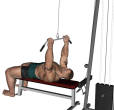 Cable Curl - High Pulley
Cable Curl - High Pulley
Benefits: This exercise isolates the biceps so that momentum does not come into play.
Purpose: This exercise strengthens the biceps.
Beginner Biceps Forearms Shoulders Traps Strength High Low Cable Machine Pull Gym
General Info: The biceps muscle is a straight muscle with 2 heads. The long head crosses both the elbow and shoulder joints and bends the elbow and raises the arm forward at the shoulder. The short head of the biceps crosses the elbow joint and, in conjunction with the brachioradialis, supinates the hand.
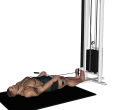 Cable Curl - Lying
Cable Curl - Lying
Benefits: This exercise also works the triceps, due to the constant tension on the cable in both position and negative reps.
Purpose: This exercise strengthens the biceps.
Intermediate Biceps Triceps Forearms Strength High Low Cable Machine Pull Gym
General Info: The biceps muscle is a straight muscle with 2 heads. The long head crosses both the elbow and shoulder joints and bends the elbow and raises the arm forward at the shoulder. The short head of the biceps crosses the elbow joint and, in conjunction with the brachioradialis, supinates the hand..
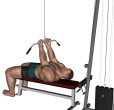 Cable Curl - Lying Close Grip On High Pulley
Cable Curl - Lying Close Grip On High Pulley
Benefits: This exercise also works the triceps, due to the constant tension on the cable in both position and negative reps.
Purpose: This exercise strengthens the biceps.
Beginner Biceps Triceps Forearms Strength High Low Cable Machine Flat Bench Pull Gym
General Info: The biceps muscle is a straight muscle with 2 heads. The long head crosses both the elbow and shoulder joints and bends the elbow and raises the arm forward at the shoulder. The short head of the biceps crosses the elbow joint and, in conjunction with the brachioradialis, supinates the hand..
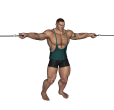 Cable Curl - Overhead
Cable Curl - Overhead
Benefits: This exercise works both heads of the biceps.
Purpose: This exercise is used to target the biceps muscle to develop size, definition, strength, endurance and power.
Intermediate Biceps Forearms Shoulders Strength High Low Cable Machine Pull Gym
General Info: The biceps is a straight muscle with two heads. The long head of the biceps crosses both the elbow and the shoulder joint. It bends the elbow and raises the arm forward at the shoulder. The short head crosses the elbow joint and, in conjunction with the brachioradialis, supinates the hand.
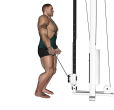 Cable Curl - Standing
Cable Curl - Standing
Benefits: This exercise works both heads of the biceps with a constant tension from the cable.
Purpose: This exercise is used to target the biceps muscle to develop size, definition, strength, endurance and power.
Beginner Biceps Forearms Shoulders Strength Cable Machine Pull Gym
General Info: The biceps is a straight muscle with two heads. The long head of the biceps crosses both the elbow and the shoulder joint. It bends the elbow and raises the arm forward at the shoulder. The short head crosses the elbow joint and, in conjunction with the brachioradialis, supinates the hand.
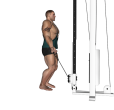 Cable Curl - Standing Single
Cable Curl - Standing Single
Benefits: This exercise works both heads of the biceps with a heavier weight than can typically be done with dumbbells.
Purpose: This exercise is used to target the biceps muscle to develop size, definition, strength, endurance and power.
Beginner Biceps Forearms Shoulders Strength Cable Machine Pull Gym
General Info: The biceps is a straight muscle with two heads. The long head of the biceps crosses both the elbow and the shoulder joint. It bends the elbow and raises the arm forward at the shoulder. The short head crosses the elbow joint and, in conjunction with the brachioradialis, supinates the hand.
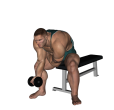 Concentration Curl - Dumbbell
Concentration Curl - Dumbbell
Benefits: This exercise isolates the biceps so that momentum does not come into play.
Purpose: This exercise strengthens the biceps.
Beginner Biceps Forearms Shoulders Traps Strength Dumbbell Flat Bench Pull Gym
General Info: The biceps muscle is a straight muscle with 2 heads. The long head crosses both the elbow and shoulder joints and bends the elbow and raises the arm forward at the shoulder. The short head of the biceps crosses the elbow joint and, in conjunction with the brachioradialis, supinates the hand..
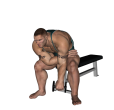 Concentration Curl - Reverse
Concentration Curl - Reverse
Benefits: This exercise isolates the biceps so that momentum does not come into play.
Purpose: This exercise strengthens the biceps.
Beginner Biceps Forearms Shoulders Traps Strength Dumbbell Flat Bench Pull Gym
General Info: The biceps muscle is a straight muscle with 2 heads. The long head crosses both the elbow and shoulder joints and bends the elbow and raises the arm forward at the shoulder. The short head of the biceps crosses the elbow joint and, in conjunction with the brachioradialis, supinates the hand..
 Concentration Curl - Water Bottle
Concentration Curl - Water Bottle
Benefits: This exercise isolates the biceps so that momentum does not come into play.
Purpose: This exercise strengthens the biceps.
Beginner Biceps Forearms Shoulders Traps Strength Water Bottle Chair Pull Home
General Info: The biceps muscle is a straight muscle with 2 heads. The long head crosses both the elbow and shoulder joints and bends the elbow and raises the arm forward at the shoulder. The short head of the biceps crosses the elbow joint and, in conjunction with the brachioradialis, supinates the hand..
 Concentration Curl - Water Bottle Reverse
Concentration Curl - Water Bottle Reverse
Benefits: This exercise isolates the biceps so that momentum does not come into play.
Purpose: This exercise strengthens the biceps.
Beginner Biceps Forearms Shoulders Traps Strength Water Bottle Chair Pull Home
General Info: The biceps muscle is a straight muscle with 2 heads. The long head crosses both the elbow and shoulder joints and bends the elbow and raises the arm forward at the shoulder. The short head of the biceps crosses the elbow joint and, in conjunction with the brachioradialis, supinates the hand..
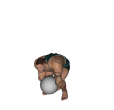 Deadlift - Atlas Stone
Deadlift - Atlas Stone
Benefits: This exercise involves many other muscles.
Purpose: This exercise builds overall strength in the lower body.
Lower Back Glutes Hamstrings Calves Quads Forearms Lats Middle Back Traps Strength Atlas Stone Pull Compound Gym
General Info: The muscles of the lower back straighten the spine. They work together with the abdominals to keep the spine upright. The Barbell Deadlift is considered to be the king of exercises. No other exercise will work your body so much.
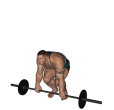 Deadlift - Axle
Deadlift - Axle
Benefits: This exercise involves many other muscles.
Purpose: This exercise builds overall strength in the lower body.
Intermediate Lower Back Glutes Hamstrings Calves Quads Forearms Lats Middle Back Traps Strength Axle Pull Compound Gym
General Info: The muscles of the lower back straighten the spine. They work together with the abdominals to keep the spine upright. The Barbell Deadlift is considered to be the king of exercises. No other exercise will work your body so much.
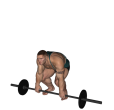 Deadlift - Barbell
Deadlift - Barbell
Benefits: This exercise involves many other muscles.
Purpose: This exercise builds overall strength in the lower body.
Intermediate Lower Back Glutes Hamstrings Calves Quads Forearms Lats Middle Back Traps Strength Barbell Pull Compound Gym
General Info: The muscles of the lower back straighten the spine. They work together with the abdominals to keep the spine upright. The Barbell Deadlift is considered to be the king of exercises. No other exercise will work your body so much.
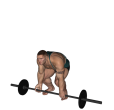 Deadlift - Barbell Mixed Grip
Deadlift - Barbell Mixed Grip
Benefits: This exercise involves many other muscles. The mixed grip allows you to lift heavier weights without worrying about the bar rolling out of your hands.
Purpose: This exercise builds overall strength in the lower body.
Intermediate Lower Back Glutes Hamstrings Calves Quads Forearms Lats Middle Back Traps Strength Barbell Pull Compound Gym
General Info: The muscles of the lower back straighten the spine. They work together with the abdominals to keep the spine upright. The Barbell Deadlift is considered to be the king of exercises. No other exercise will work your body so much.
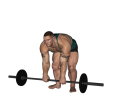 Deadlift - Barbell Straight Leg
Deadlift - Barbell Straight Leg
Benefits: This exercise involves many other muscles.
Purpose: This exercise builds overall strength in the lower body.
Lower Back Glutes Hamstrings Calves Quads Forearms Lats Middle Back Traps Strength Barbell Pull Compound Gym
General Info: The muscles of the lower back straighten the spine. They work together with the abdominals to keep the spine upright. The Barbell Deadlift is considered to be the king of exercises. No other exercise will work your body so much.
 Deadlift - Car
Deadlift - Car
Benefits: This exercise involves many other muscles.
Purpose: This exercise builds overall strength in the lower body.
Lower Back Glutes Hamstrings Calves Quads Forearms Lats Middle Back Traps Strength Car Apparatus Pull Compound Gym
General Info: The muscles of the lower back straighten the spine. They work together with the abdominals to keep the spine upright. The Barbell Deadlift is considered to be the king of exercises. No other exercise will work your body so much.
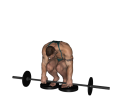 Deadlift - Deficit
Deadlift - Deficit
Benefits: This exercise involves many other muscles.
Purpose: This exercise builds overall strength in the lower body.
Lower Back Glutes Hamstrings Calves Quads Forearms Lats Middle Back Traps Strength Barbell Pull Compound Gym
General Info: The muscles of the lower back straighten the spine. They work together with the abdominals to keep the spine upright. The Barbell Deadlift is considered to be the king of exercises. No other exercise will work your body so much.
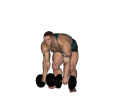 Deadlift - Dumbbell
Deadlift - Dumbbell
Benefits: This exercise involves many other muscles.
Purpose: This exercise builds overall strength in the lower body.
Intermediate Lower Back Glutes Hamstrings Calves Quads Forearms Lats Middle Back Traps Strength Dumbbell Pull Compound Gym
General Info: The muscles of the lower back straighten the spine. They work together with the abdominals to keep the spine upright. The Barbell Deadlift is considered to be the king of exercises. No other exercise will work your body so much.
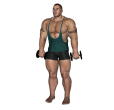 Deadlift - Dumbbell Straight Leg
Deadlift - Dumbbell Straight Leg
Benefits: This exercise involves many other muscles.
Purpose: This exercise builds overall strength in the lower body.
Lower Back Glutes Hamstrings Calves Quads Forearms Lats Middle Back Traps Strength Dumbbell Pull Compound Gym
General Info: The muscles of the lower back straighten the spine. They work together with the abdominals to keep the spine upright. The Barbell Deadlift is considered to be the king of exercises. No other exercise will work your body so much.
 Deadlift - Farmers Walk
Deadlift - Farmers Walk
Benefits: This exercise involves many other muscles.
Purpose: This exercise builds overall strength in the lower body.
Lower Back Glutes Hamstrings Calves Quads Forearms Lats Middle Back Traps Strength Dumbbell Pull Compound Gym
General Info: The muscles of the lower back straighten the spine. They work together with the abdominals to keep the spine upright. The Barbell Deadlift is considered to be the king of exercises. No other exercise will work your body so much.
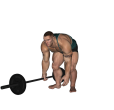 Deadlift - One Arm Side
Deadlift - One Arm Side
Benefits: This exercise involves many other muscles.
Purpose: This exercise builds overall strength in the lower body.
Intermediate Lower Back Glutes Hamstrings Calves Quads Forearms Lats Middle Back Traps Strength Barbell Pull Compound Gym
General Info: The muscles of the lower back straighten the spine. They work together with the abdominals to keep the spine upright. The Barbell Deadlift is considered to be the king of exercises. No other exercise will work your body so much.
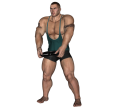 Deadlift - Plate
Deadlift - Plate
Benefits: This exercise involves many other muscles.
Purpose: This exercise builds overall strength in the lower body.
Intermediate Lower Back Glutes Hamstrings Calves Quads Forearms Lats Middle Back Traps Strength Plate Pull Compound Gym
General Info: The muscles of the lower back straighten the spine. They work together with the abdominals to keep the spine upright. The Barbell Deadlift is considered to be the king of exercises. No other exercise will work your body so much.
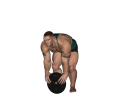 Deadlift - Plate Straight Leg
Deadlift - Plate Straight Leg
Benefits: This exercise involves many other muscles.
Purpose: This exercise builds overall strength in the lower body.
Lower Back Glutes Hamstrings Calves Quads Forearms Lats Middle Back Traps Strength Plate Pull Compound Gym
General Info: The muscles of the lower back straighten the spine. They work together with the abdominals to keep the spine upright. The Barbell Deadlift is considered to be the king of exercises. No other exercise will work your body so much.
 Deadlift - Power Stairs
Deadlift - Power Stairs
Benefits: This exercise involves many other muscles.
Purpose: This exercise builds overall strength in the lower body.
Lower Back Glutes Hamstrings Calves Quads Forearms Lats Middle Back Traps Strength Dumbbell Pull Compound Gym
General Info: The muscles of the lower back straighten the spine. They work together with the abdominals to keep the spine upright. The Barbell Deadlift is considered to be the king of exercises. No other exercise will work your body so much.
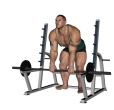 Deadlift - Rack Pull
Deadlift - Rack Pull
Benefits: This exercise involves many other muscles.
Purpose: This exercise builds overall strength in the lower body.
Intermediate Lower Back Glutes Hamstrings Calves Quads Forearms Lats Middle Back Traps Strength Power Rack Barbell Pull Compound Gym
General Info: The muscles of the lower back straighten the spine. They work together with the abdominals to keep the spine upright. The Barbell Deadlift is considered to be the king of exercises. No other exercise will work your body so much.
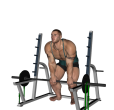 Deadlift - Rack Pull With Bands
Deadlift - Rack Pull With Bands
Benefits: This exercise involves many other muscles.
Purpose: This exercise builds overall strength in the lower body.
Intermediate Lower Back Glutes Hamstrings Calves Quads Forearms Lats Middle Back Traps Strength Power Rack Barbell Band Pull Compound Gym
General Info: The muscles of the lower back straighten the spine. They work together with the abdominals to keep the spine upright. The Barbell Deadlift is considered to be the king of exercises. No other exercise will work your body so much.
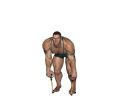 Deadlift - Resistance Tube Straight Leg
Deadlift - Resistance Tube Straight Leg
Benefits: This exercise involves many other muscles.
Purpose: This exercise builds overall strength in the lower body.
Beginner Lower Back Glutes Hamstrings Calves Quads Forearms Lats Middle Back Traps Strength Resistance Tube Pull Compound Gym
General Info: The muscles of the lower back straighten the spine. They work together with the abdominals to keep the spine upright. The Barbell Deadlift is considered to be the king of exercises. No other exercise will work your body so much.
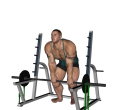 Deadlift - Reverse Band
Deadlift - Reverse Band
Benefits: This exercise involves many other muscles.
Purpose: This exercise builds overall strength in the lower body.
Intermediate Lower Back Glutes Hamstrings Calves Quads Forearms Lats Middle Back Traps Strength Power Rack Barbell Band Pull Compound Gym
General Info: The muscles of the lower back straighten the spine. They work together with the abdominals to keep the spine upright. The Barbell Deadlift is considered to be the king of exercises. No other exercise will work your body so much.
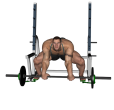 Deadlift - Reverse Band Sumo
Deadlift - Reverse Band Sumo
Benefits: This exercise involves many other muscles.
Purpose: This exercise builds overall strength in the lower body.
Intermediate Lower Back Glutes Hamstrings Calves Quads Forearms Lats Middle Back Traps Strength Power Rack Barbell Band Pull Compound Gym
General Info: The muscles of the lower back straighten the spine. They work together with the abdominals to keep the spine upright. The Barbell Deadlift is considered to be the king of exercises. No other exercise will work your body so much.
 Deadlift - Rickshaw
Deadlift - Rickshaw
Benefits: This exercise involves many other muscles.
Purpose: This exercise builds overall strength in the lower body.
Lower Back Glutes Hamstrings Calves Quads Forearms Lats Middle Back Traps Strength Rickshaw Apparatus Pull Compound Gym
General Info: The muscles of the lower back straighten the spine. They work together with the abdominals to keep the spine upright. The Barbell Deadlift is considered to be the king of exercises. No other exercise will work your body so much.
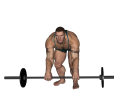 Deadlift - Romanian
Deadlift - Romanian
Benefits: This exercise involves many other muscles.
Purpose: This exercise builds overall strength in the lower body.
Lower Back Glutes Hamstrings Calves Quads Forearms Lats Middle Back Traps Strength Barbell Pull Compound Gym
General Info: The muscles of the lower back straighten the spine. They work together with the abdominals to keep the spine upright. The Barbell Deadlift is considered to be the king of exercises. No other exercise will work your body so much.
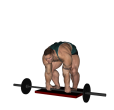 Deadlift - Romanian From Deficit
Deadlift - Romanian From Deficit
Benefits: This exercise involves many other muscles.
Purpose: This exercise builds overall strength in the lower body.
Lower Back Glutes Hamstrings Calves Quads Forearms Lats Middle Back Traps Strength Barbell Pull Compound Gym
General Info: The muscles of the lower back straighten the spine. They work together with the abdominals to keep the spine upright. The Barbell Deadlift is considered to be the king of exercises. No other exercise will work your body so much.
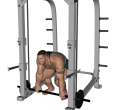 Deadlift - Smith Machine
Deadlift - Smith Machine
Benefits: This exercise involves many other muscles.
Purpose: This exercise builds overall strength in the lower body.
Intermediate Lower Back Glutes Hamstrings Calves Quads Forearms Lats Middle Back Traps Strength Smith Machine Pull Compound Gym
General Info: The muscles of the lower back straighten the spine. They work together with the abdominals to keep the spine upright. The Barbell Deadlift is considered to be the king of exercises. No other exercise will work your body so much.
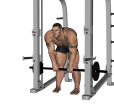 Deadlift - Smith Machine Stiff Legged
Deadlift - Smith Machine Stiff Legged
Benefits: This exercise involves many other muscles.
Purpose: This exercise builds overall strength in the lower body.
Lower Back Glutes Hamstrings Calves Quads Forearms Lats Middle Back Traps Strength Smith Machine Pull Compound Gym
General Info: The muscles of the lower back straighten the spine. They work together with the abdominals to keep the spine upright. The Barbell Deadlift is considered to be the king of exercises. No other exercise will work your body so much.
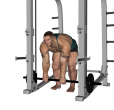 Deadlift - Smith Machine Straight Leg
Deadlift - Smith Machine Straight Leg
Benefits: This exercise involves many other muscles.
Purpose: This exercise builds overall strength in the lower body.
Lower Back Glutes Hamstrings Calves Quads Forearms Lats Middle Back Traps Strength Smith Machine Pull Compound Gym
General Info: The muscles of the lower back straighten the spine. They work together with the abdominals to keep the spine upright. The Barbell Deadlift is considered to be the king of exercises. No other exercise will work your body so much.
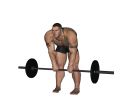 Deadlift - Stiff Legged Barbell
Deadlift - Stiff Legged Barbell
Benefits: This exercise involves many other muscles.
Purpose: This exercise builds overall strength in the lower body.
Lower Back Glutes Hamstrings Calves Quads Forearms Lats Middle Back Traps Strength Barbell Pull Compound Gym
General Info: The muscles of the lower back straighten the spine. They work together with the abdominals to keep the spine upright. The Barbell Deadlift is considered to be the king of exercises. No other exercise will work your body so much.
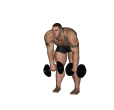 Deadlift - Stiff Legged Dumbbell
Deadlift - Stiff Legged Dumbbell
Benefits: This exercise involves many other muscles.
Purpose: This exercise builds overall strength in the lower body.
Lower Back Glutes Hamstrings Calves Quads Forearms Lats Middle Back Traps Strength Dumbbell Pull Compound Gym
General Info: The muscles of the lower back straighten the spine. They work together with the abdominals to keep the spine upright. The Barbell Deadlift is considered to be the king of exercises. No other exercise will work your body so much.
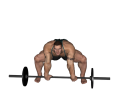 Deadlift - Sumo
Deadlift - Sumo
Benefits: This exercise involves many other muscles.
Purpose: This exercise builds overall strength in the lower body.
Intermediate Lower Back Glutes Hamstrings Calves Quads Forearms Lats Middle Back Traps Strength Barbell Pull Compound Gym
General Info: The muscles of the lower back straighten the spine. They work together with the abdominals to keep the spine upright. The Barbell Deadlift is considered to be the king of exercises. No other exercise will work your body so much.
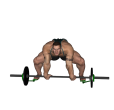 Deadlift - Sumo With Bands
Deadlift - Sumo With Bands
Benefits: This exercise involves many other muscles.
Purpose: This exercise builds overall strength in the lower body.
Intermediate Lower Back Glutes Hamstrings Calves Quads Forearms Lats Middle Back Traps Strength Barbell Band Pull Compound Gym
General Info: The muscles of the lower back straighten the spine. They work together with the abdominals to keep the spine upright. The Barbell Deadlift is considered to be the king of exercises. No other exercise will work your body so much.
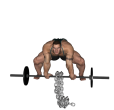 Deadlift - Sumo With Chains
Deadlift - Sumo With Chains
Benefits: This exercise is done with the addition of chains. The primary function of chains is to accommodate resistance. Chains are also a great means of weight loading (adding more weight to an exercise). Chains are also a great way for working the stabilizers.
Purpose: Benefits This exercise involves many other muscles.
Intermediate Lower Back Glutes Hamstrings Calves Quads Forearms Lats Middle Back Traps Strength Barbell Chains Pull Compound Gym
General Info: The muscles of the lower back straighten the spine. They work together with the abdominals to keep the spine upright. The Barbell Deadlift is considered to be the king of exercises. No other exercise will work your body so much.
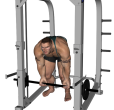 Drag Curl - Smith Machine Bent Over
Drag Curl - Smith Machine Bent Over
Benefits: This exercise works both heads of the biceps with a heavier weight than can typically be done with dumbbells.
Purpose: This exercise is used to target the biceps muscle to develop size, definition, strength, endurance and power.
Intermediate Biceps Forearms Shoulders Lower Back Strength Smith Machine Pull Compound Gym
General Info: The biceps is a straight muscle with two heads. The long head of the biceps crosses both the elbow and the shoulder joint. It bends the elbow and raises the arm forward at the shoulder. The short head crosses the elbow joint and, in conjunction with the brachioradialis, supinates the hand.
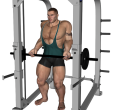 Drag Curl - Smith Machine Standing
Drag Curl - Smith Machine Standing
Benefits: This exercise works both heads of the biceps with a heavier weight than can typically be done with dumbbells.
Purpose: This exercise is used to target the biceps muscle to develop size, definition, strength, endurance and power.
Intermediate Biceps Forearms Shoulders Strength Smith Machine Pull Compound Gym
General Info: The biceps is a straight muscle with two heads. The long head of the biceps crosses both the elbow and the shoulder joint. It bends the elbow and raises the arm forward at the shoulder. The short head crosses the elbow joint and, in conjunction with the brachioradialis, supinates the hand.
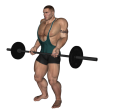 Drag Curl - Standing Barbell
Drag Curl - Standing Barbell
Benefits: This exercise works both heads of the biceps with a heavier weight than can typically be done with dumbbells.
Purpose: This exercise is used to target the biceps muscle to develop size, definition, strength, endurance and power.
Intermediate Biceps Forearms Shoulders Strength Barbell Pull Compound Gym
General Info: The biceps is a straight muscle with two heads. The long head of the biceps crosses both the elbow and the shoulder joint. It bends the elbow and raises the arm forward at the shoulder. The short head crosses the elbow joint and, in conjunction with the brachioradialis, supinates the hand.
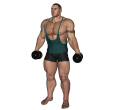 Dumbbell Curl - Alternate
Dumbbell Curl - Alternate
Benefits: This exercise works both heads of the biceps with a heavier weight than can typically be done with dumbbells.
Purpose: This exercise is used to target the biceps muscle to develop size, definition, strength, endurance and power.
Beginner Biceps Forearms Shoulders Strength Dumbbell Pull Gym
General Info: The biceps is a straight muscle with two heads. The long head of the biceps crosses both the elbow and the shoulder joint. It bends the elbow and raises the arm forward at the shoulder. The short head crosses the elbow joint and, in conjunction with the brachioradialis, supinates the hand.
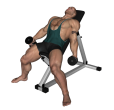 Dumbbell Curl - Alternate Incline
Dumbbell Curl - Alternate Incline
Benefits: The exercise eliminates cheating to isolate the biceps. The incline makes it more difficult to curl the dumbbells.
Purpose: This exercise works primarily the biceps with the front (anterior) shoulders and forearms acting as secondary muscles.
Beginner Biceps Forearms Anterior Shoulders Strength Dumbbell Incline Bench Pull Gym
General Info: The alternate incline dumbbell curl is an alternative exercise to the traditional seated or standing dumbbell curl. It is a favorite biceps builder among body builders.
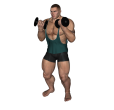 Dumbbell Curl - Basic
Dumbbell Curl - Basic
Benefits: This exercise works both heads of the biceps.
Purpose: This exercise is used to target the biceps muscle to develop size, definition, strength, endurance and power.
Beginner Biceps Forearms Shoulders Strength Dumbbell Pull Gym
General Info: The biceps is a straight muscle with two heads. The long head of the biceps crosses both the elbow and the shoulder joint. It bends the elbow and raises the arm forward at the shoulder. The short head crosses the elbow joint and, in conjunction with the brachioradialis, supinates the hand.
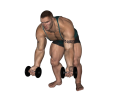 Dumbbell Curl - Bent Over
Dumbbell Curl - Bent Over
Benefits: This exercise is similar in effect to the Spider curl and does a good job of placing maximum tension on the biceps in the fully contracted position.
Purpose: This exercise works the biceps muscles but focuses also on the brachioradialis (a muscle that crosses the elbow joint and assists in rotating the forearm).
Beginner Biceps Forearms Shoulders Strength Dumbbell Pull Gym
General Info: The biceps is a straight muscle which has two heads. The long head crosses both the elbow and the shoulder joints. It bends the arm at the elbow and raises the arm forward at the shoulder. The short head crosses the elbow joint and, in conjunction with the brachioradialis, supinates the hand.
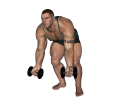 Dumbbell Curl - Bent Over Alternate
Dumbbell Curl - Bent Over Alternate
Benefits: This exercise works both heads of the biceps with a heavier weight than can typically be done with dumbbells.
Purpose: This exercise is used to target the biceps muscle to develop size, definition, strength, endurance and power.
Beginner Biceps Forearms Shoulders Strength Dumbbell Pull Gym
General Info: The biceps is a straight muscle with two heads. The long head of the biceps crosses both the elbow and the shoulder joint. It bends the elbow and raises the arm forward at the shoulder. The short head crosses the elbow joint and, in conjunction with the brachioradialis, supinates the hand.
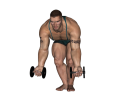 Dumbbell Curl - Bent Over Narrow
Dumbbell Curl - Bent Over Narrow
Benefits: This exercise is similar in effect to the Spider curl and does a good job of placing maximum tension on the biceps in the fully contracted position.
Purpose: This exercise works the biceps muscles but focuses also on the brachioradialis (a muscle that crosses the elbow joint and assists in rotating the forearm).
Beginner Biceps Forearms Shoulders Strength Dumbbell Pull Gym
General Info: The biceps is a straight muscle which has two heads. The long head crosses both the elbow and the shoulder joints. It bends the arm at the elbow and raises the arm forward at the shoulder. The short head crosses the elbow joint and, in conjunction with the brachioradialis, supinates the hand.
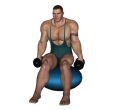 Dumbbell Curl - Fitness Ball
Dumbbell Curl - Fitness Ball
Benefits: This exercise isolates the biceps so that momentum does not come into play.
Purpose: This exercise strengthens the biceps.
Beginner Biceps Forearms Strength Dumbbell Fitness Ball Pull Gym
General Info: The biceps muscle is a straight muscle with 2 heads. The long head crosses both the elbow and shoulder joints and bends the elbow and raises the arm forward at the shoulder. The short head of the biceps crosses the elbow joint and, in conjunction with the brachioradialis, supinates the hand..
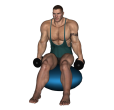 Dumbbell Curl - Fitness Ball Alternate
Dumbbell Curl - Fitness Ball Alternate
Benefits: This exercise isolates the biceps so that momentum does not come into play.
Purpose: This exercise strengthens the biceps.
Beginner Biceps Forearms Shoulders Traps Strength Dumbbell Fitness Ball Pull Gym
General Info: The biceps muscle is a straight muscle with 2 heads. The long head crosses both the elbow and shoulder joints and bends the elbow and raises the arm forward at the shoulder. The short head of the biceps crosses the elbow joint and, in conjunction with the brachioradialis, supinates the hand.
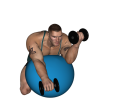 Dumbbell Curl - Fitness Ball Preacher Zottman Alternate
Dumbbell Curl - Fitness Ball Preacher Zottman Alternate
Benefits: This exercise isolates the biceps so that momentum does not come into play.
Purpose: This exercise strengthens the biceps.
Beginner Biceps Forearms Shoulders Traps Strength Dumbbell Fitness Ball Pull Gym
General Info: The biceps muscle is a straight muscle with 2 heads. The long head crosses both the elbow and shoulder joints and bends the elbow and raises the arm forward at the shoulder. The short head of the biceps crosses the elbow joint and, in conjunction with the brachioradialis, supinates the hand.
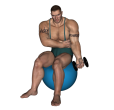 Dumbbell Curl - Fitness Ball Single
Dumbbell Curl - Fitness Ball Single
Benefits: This exercise isolates the biceps so that momentum does not come into play.
Purpose: This exercise strengthens the biceps.
Beginner Biceps Forearms Strength Dumbbell Fitness Ball Pull Gym
General Info: The biceps muscle is a straight muscle with 2 heads. The long head crosses both the elbow and shoulder joints and bends the elbow and raises the arm forward at the shoulder. The short head of the biceps crosses the elbow joint and, in conjunction with the brachioradialis, supinates the hand..
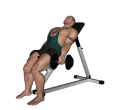 Dumbbell Curl - Flexor Incline
Dumbbell Curl - Flexor Incline
Benefits: The exercise eliminates cheating to isolate the biceps. The incline makes it more difficult to curl the dumbbells.
Purpose: This exercise works primarily the biceps with the front (anterior) shoulders and forearms acting as secondary muscles.
Beginner Biceps Forearms Anterior Shoulders Strength Dumbbell Incline Bench Pull Gym
General Info: The biceps muscle is a straight muscle with 2 heads. The long head crosses both the elbow and shoulder joints and bends the elbow and raises the arm forward at the shoulder. The short head of the biceps crosses the elbow joint and, in conjunction with the brachioradialis, supinates the hand.
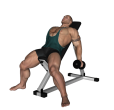 Dumbbell Curl - Incline
Dumbbell Curl - Incline
Benefits: The exercise eliminates cheating to isolate the biceps. The incline makes it more difficult to curl the dumbbells.
Purpose: This exercise works primarily the biceps with the front (anterior) shoulders and forearms acting as secondary muscles.
Beginner Biceps Forearms Anterior Shoulders Strength Dumbbell Incline Bench Pull Gym
General Info: The biceps muscle is a straight muscle with 2 heads. The long head crosses both the elbow and shoulder joints and bends the elbow and raises the arm forward at the shoulder. The short head of the biceps crosses the elbow joint and, in conjunction with the brachioradialis, supinates the hand.
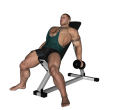 Dumbbell Curl - Incline Alternate
Dumbbell Curl - Incline Alternate
Benefits: The exercise eliminates cheating to isolate the biceps. The incline makes it more difficult to curl the dumbbells.
Purpose: This exercise works primarily the biceps with the front (anterior) shoulders and forearms acting as secondary muscles.
Beginner Biceps Forearms Anterior Shoulders Strength Dumbbell Incline Bench Pull Gym
General Info: The biceps muscle is a straight muscle with 2 heads. The long head crosses both the elbow and shoulder joints and bends the elbow and raises the arm forward at the shoulder. The short head of the biceps crosses the elbow joint and, in conjunction with the brachioradialis, supinates the hand.
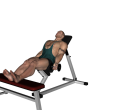 Dumbbell Curl - Incline Feet Up
Dumbbell Curl - Incline Feet Up
Benefits: The exercise eliminates cheating to isolate the biceps. The incline makes it more difficult to curl the dumbbells.
Purpose: This exercise works primarily the biceps with the front (anterior) shoulders and forearms acting as secondary muscles.
Beginner Biceps Forearms Anterior Shoulders Strength Dumbbell Incline Bench Pull Gym
General Info: The biceps muscle is a straight muscle with 2 heads. The long head crosses both the elbow and shoulder joints and bends the elbow and raises the arm forward at the shoulder. The short head of the biceps crosses the elbow joint and, in conjunction with the brachioradialis, supinates the hand.
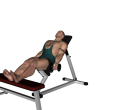 Dumbbell Curl - Incline Feet Up Alternate
Dumbbell Curl - Incline Feet Up Alternate
Benefits: The exercise eliminates cheating to isolate the biceps. The incline makes it more difficult to curl the dumbbells.
Purpose: This exercise works primarily the biceps with the front (anterior) shoulders and forearms acting as secondary muscles.
Beginner Biceps Forearms Anterior Shoulders Strength Dumbbell Incline Bench Pull Gym
General Info: The biceps muscle is a straight muscle with 2 heads. The long head crosses both the elbow and shoulder joints and bends the elbow and raises the arm forward at the shoulder. The short head of the biceps crosses the elbow joint and, in conjunction with the brachioradialis, supinates the hand.
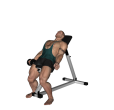 Dumbbell Curl - Incline Single
Dumbbell Curl - Incline Single
Benefits: This exercise works both heads of the biceps with a heavier weight than can typically be done with dumbbells.
Purpose: This exercise is used to target the biceps muscle to develop size, definition, strength, endurance and power.
Beginner Biceps Forearms Shoulders Strength Dumbbell Incline Bench Pull Gym
General Info: The biceps is a straight muscle with two heads. The long head of the biceps crosses both the elbow and the shoulder joint. It bends the elbow and raises the arm forward at the shoulder. The short head crosses the elbow joint and, in conjunction with the brachioradialis, supinates the hand.
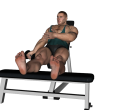 Dumbbell Curl - Incline Single Feet Up
Dumbbell Curl - Incline Single Feet Up
Benefits: This exercise works both heads of the biceps with a heavier weight than can typically be done with dumbbells.
Purpose: This exercise is used to target the biceps muscle to develop size, definition, strength, endurance and power.
Beginner Biceps Forearms Shoulders Strength Dumbbell Incline Bench Pull Gym
General Info: The biceps is a straight muscle with two heads. The long head of the biceps crosses both the elbow and the shoulder joint. It bends the elbow and raises the arm forward at the shoulder. The short head crosses the elbow joint and, in conjunction with the brachioradialis, supinates the hand.
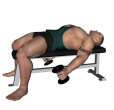 Dumbbell Curl - Lying Supine
Dumbbell Curl - Lying Supine
Benefits: This exercise isolates both heads of the biceps.
Purpose: This exercise is used to target the biceps muscle to develop size, definition, strength, endurance and power.
Beginner Biceps Forearms Strength Dumbbell Flat Bench Pull Gym
General Info: The biceps is a straight muscle with two heads. The long head of the biceps crosses both the elbow and the shoulder joint. It bends the elbow and raises the arm forward at the shoulder. The short head crosses the elbow joint and, in conjunction with the brachioradialis, supinates the hand.
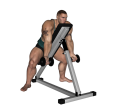 Dumbbell Curl - Prone Incline
Dumbbell Curl - Prone Incline
Benefits: This exercise works both heads of the biceps with a heavier weight than can typically be done with dumbbells.
Purpose: This exercise is used to target the biceps muscle to develop size, definition, strength, endurance and power.
Beginner Biceps Forearms Shoulders Strength Dumbbell Incline Bench Pull Gym
General Info: The biceps is a straight muscle with two heads. The long head of the biceps crosses both the elbow and the shoulder joint. It bends the elbow and raises the arm forward at the shoulder. The short head crosses the elbow joint and, in conjunction with the brachioradialis, supinates the hand.
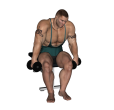 Dumbbell Curl - Seated
Dumbbell Curl - Seated
Benefits: This exercise isolates the biceps so that momentum does not come into play.
Purpose: This exercise strengthens the biceps.
Beginner Biceps Forearms Strength Dumbbell Flat Bench Pull Gym
General Info: The biceps muscle is a straight muscle with 2 heads. The long head crosses both the elbow and shoulder joints and bends the elbow and raises the arm forward at the shoulder. The short head of the biceps crosses the elbow joint and, in conjunction with the brachioradialis, supinates the hand..
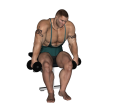 Dumbbell Curl - Seated Alternate
Dumbbell Curl - Seated Alternate
Benefits: This exercise isolates the biceps so that momentum does not come into play.
Purpose: This exercise strengthens the biceps.
Beginner Biceps Forearms Shoulders Traps Strength Dumbbell Flat Bench Pull Gym
General Info: The biceps muscle is a straight muscle with 2 heads. The long head crosses both the elbow and shoulder joints and bends the elbow and raises the arm forward at the shoulder. The short head of the biceps crosses the elbow joint and, in conjunction with the brachioradialis, supinates the hand..
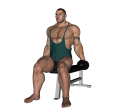 Dumbbell Curl - Seated Inner
Dumbbell Curl - Seated Inner
Benefits: This exercise isolates the biceps so that momentum does not come into play.
Purpose: This exercise strengthens the biceps.
Beginner Biceps Forearms Strength Dumbbell Flat Bench Pull Gym
General Info: The biceps muscle is a straight muscle with 2 heads. The long head crosses both the elbow and shoulder joints and bends the elbow and raises the arm forward at the shoulder. The short head of the biceps crosses the elbow joint and, in conjunction with the brachioradialis, supinates the hand..
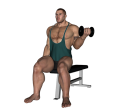 Dumbbell Curl - Seated Inner Alternate
Dumbbell Curl - Seated Inner Alternate
Benefits: This exercise isolates the biceps so that momentum does not come into play.
Purpose: This exercise strengthens the biceps.
Beginner Biceps Forearms Shoulders Traps Strength Dumbbell Flat Bench Pull Gym
General Info: The biceps muscle is a straight muscle with 2 heads. The long head crosses both the elbow and shoulder joints and bends the elbow and raises the arm forward at the shoulder. The short head of the biceps crosses the elbow joint and, in conjunction with the brachioradialis, supinates the hand..
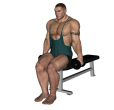 Dumbbell Curl - Seated Narrow Stance
Dumbbell Curl - Seated Narrow Stance
Benefits: This exercise isolates the biceps so that momentum does not come into play.
Purpose: This exercise strengthens the biceps.
Beginner Biceps Forearms Shoulders Traps Strength Dumbbell Flat Bench Pull Gym
General Info: The biceps muscle is a straight muscle with 2 heads. The long head crosses both the elbow and shoulder joints and bends the elbow and raises the arm forward at the shoulder. The short head of the biceps crosses the elbow joint and, in conjunction with the brachioradialis, supinates the hand..
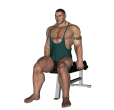 Dumbbell Curl - Seated Reverse
Dumbbell Curl - Seated Reverse
Benefits: This exercise isolates the biceps so that momentum does not come into play.
Purpose: This exercise strengthens the biceps.
Beginner Biceps Forearms Strength Dumbbell Flat Bench Pull Gym
General Info: The biceps muscle is a straight muscle with 2 heads. The long head crosses both the elbow and shoulder joints and bends the elbow and raises the arm forward at the shoulder. The short head of the biceps crosses the elbow joint and, in conjunction with the brachioradialis, supinates the hand..
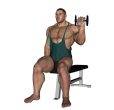 Dumbbell Curl - Seated Reverse Alternate
Dumbbell Curl - Seated Reverse Alternate
Benefits: This exercise isolates the biceps so that momentum does not come into play.
Purpose: This exercise strengthens the biceps.
Beginner Biceps Forearms Shoulders Traps Strength Dumbbell Flat Bench Pull Gym
General Info: The biceps muscle is a straight muscle with 2 heads. The long head crosses both the elbow and shoulder joints and bends the elbow and raises the arm forward at the shoulder. The short head of the biceps crosses the elbow joint and, in conjunction with the brachioradialis, supinates the hand..
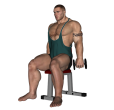 Dumbbell Curl - Seated Reverse Narrow Stance
Dumbbell Curl - Seated Reverse Narrow Stance
Benefits: This exercise isolates the biceps so that momentum does not come into play.
Purpose: This exercise strengthens the biceps.
Beginner Biceps Forearms Strength Dumbbell Flat Bench Pull Gym
General Info: The biceps muscle is a straight muscle with 2 heads. The long head crosses both the elbow and shoulder joints and bends the elbow and raises the arm forward at the shoulder. The short head of the biceps crosses the elbow joint and, in conjunction with the brachioradialis, supinates the hand..
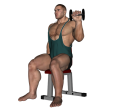 Dumbbell Curl - Seated Reverse Narrow Stance Alternate
Dumbbell Curl - Seated Reverse Narrow Stance Alternate
Benefits: This exercise isolates the biceps so that momentum does not come into play.
Purpose: This exercise strengthens the biceps.
Beginner Biceps Forearms Shoulders Traps Strength Dumbbell Flat Bench Pull Gym
General Info: The biceps muscle is a straight muscle with 2 heads. The long head crosses both the elbow and shoulder joints and bends the elbow and raises the arm forward at the shoulder. The short head of the biceps crosses the elbow joint and, in conjunction with the brachioradialis, supinates the hand..
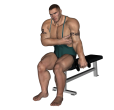 Dumbbell Curl - Seated Single
Dumbbell Curl - Seated Single
Benefits: This exercise isolates the biceps so that momentum does not come into play.
Purpose: This exercise strengthens the biceps.
Beginner Biceps Forearms Shoulders Traps Strength Dumbbell Flat Bench Pull Gym
General Info: The biceps muscle is a straight muscle with 2 heads. The long head crosses both the elbow and shoulder joints and bends the elbow and raises the arm forward at the shoulder. The short head of the biceps crosses the elbow joint and, in conjunction with the brachioradialis, supinates the hand..
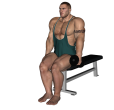 Dumbbell Curl - Seated Single Narrow
Dumbbell Curl - Seated Single Narrow
Benefits: This exercise isolates the biceps so that momentum does not come into play.
Purpose: This exercise strengthens the biceps.
Beginner Biceps Forearms Shoulders Traps Strength Dumbbell Flat Bench Pull Gym
General Info: The biceps muscle is a straight muscle with 2 heads. The long head crosses both the elbow and shoulder joints and bends the elbow and raises the arm forward at the shoulder. The short head of the biceps crosses the elbow joint and, in conjunction with the brachioradialis, supinates the hand..
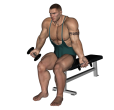 Dumbbell Curl - Seated Straight
Dumbbell Curl - Seated Straight
Benefits: This exercise isolates the biceps so that momentum does not come into play.
Purpose: This exercise strengthens the biceps.
Beginner Biceps Forearms Shoulders Traps Strength Dumbbell Flat Bench Pull Gym
General Info: The biceps muscle is a straight muscle with 2 heads. The long head crosses both the elbow and shoulder joints and bends the elbow and raises the arm forward at the shoulder. The short head of the biceps crosses the elbow joint and, in conjunction with the brachioradialis, supinates the hand..
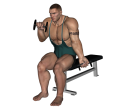 Dumbbell Curl - Seated Straight Alternate
Dumbbell Curl - Seated Straight Alternate
Benefits: This exercise isolates the biceps so that momentum does not come into play.
Purpose: This exercise strengthens the biceps.
Beginner Biceps Forearms Shoulders Traps Strength Dumbbell Flat Bench Pull Gym
General Info: The biceps muscle is a straight muscle with 2 heads. The long head crosses both the elbow and shoulder joints and bends the elbow and raises the arm forward at the shoulder. The short head of the biceps crosses the elbow joint and, in conjunction with the brachioradialis, supinates the hand.
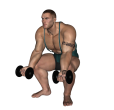 Dumbbell Curl - Squat
Dumbbell Curl - Squat
Benefits: This exercise isolates the biceps so that momentum does not come into play.
Purpose: This exercise strengthens the biceps.
Intermediate Biceps Forearms Shoulders Traps Strength Dumbbell Pull Gym
General Info: The biceps muscle is a straight muscle with 2 heads. The long head crosses both the elbow and shoulder joints and bends the elbow and raises the arm forward at the shoulder. The short head of the biceps crosses the elbow joint and, in conjunction with the brachioradialis, supinates the hand..
 Dumbbell Curl - Squat Alternate
Dumbbell Curl - Squat Alternate
Benefits: This exercise isolates the biceps so that momentum does not come into play.
Purpose: This exercise strengthens the biceps.
Intermediate Biceps Forearms Shoulders Traps Strength Dumbbell Pull Gym
General Info: The biceps muscle is a straight muscle with 2 heads. The long head crosses both the elbow and shoulder joints and bends the elbow and raises the arm forward at the shoulder. The short head of the biceps crosses the elbow joint and, in conjunction with the brachioradialis, supinates the hand..
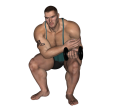 Dumbbell Curl - Squat Single
Dumbbell Curl - Squat Single
Benefits: This exercise isolates the biceps so that momentum does not come into play.
Purpose: This exercise strengthens the biceps.
Intermediate Biceps Forearms Shoulders Traps Strength Dumbbell Pull Gym
General Info: The biceps muscle is a straight muscle with 2 heads. The long head crosses both the elbow and shoulder joints and bends the elbow and raises the arm forward at the shoulder. The short head of the biceps crosses the elbow joint and, in conjunction with the brachioradialis, supinates the hand..
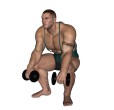 Dumbbell Curl - Squat Single Reverse
Dumbbell Curl - Squat Single Reverse
Benefits: This exercise isolates the biceps so that momentum does not come into play.
Purpose: This exercise strengthens the biceps.
Intermediate Biceps Forearms Shoulders Traps Strength Dumbbell Pull Gym
General Info: The biceps muscle is a straight muscle with 2 heads. The long head crosses both the elbow and shoulder joints and bends the elbow and raises the arm forward at the shoulder. The short head of the biceps crosses the elbow joint and, in conjunction with the brachioradialis, supinates the hand..
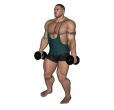 Dumbbell Curl - Standing
Dumbbell Curl - Standing
Benefits: This exercise works both heads of the biceps and isolates the biceps so that momentum does not come into play.
Purpose: This exercise is used to target the biceps muscle to develop size, definition, strength, endurance and power.
Beginner Biceps Forearms Shoulders Strength Dumbbell Pull Gym
General Info: The biceps is a straight muscle with two heads. The long head of the biceps crosses both the elbow and the shoulder joint. It bends the elbow and raises the arm forward at the shoulder. The short head crosses the elbow joint and, in conjunction with the brachioradialis, supinates the hand.
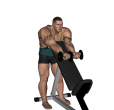 Dumbbell Curl - Standing Incline
Dumbbell Curl - Standing Incline
Benefits: This exercise works both heads of the biceps very similarly as the preacher curl.
Purpose: This exercise is used to target the biceps muscle to develop size, definition, strength, endurance and power.
Beginner Biceps Forearms Shoulders Strength Dumbbell Incline Bench Pull Gym
General Info: The biceps is a straight muscle with two heads. The long head of the biceps crosses both the elbow and the shoulder joint. It bends the elbow and raises the arm forward at the shoulder. The short head crosses the elbow joint and, in conjunction with the brachioradialis, supinates the hand.
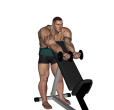 Dumbbell Curl - Standing Incline Alternate
Dumbbell Curl - Standing Incline Alternate
Benefits: This exercise works both heads of the biceps very similarly as the preacher curl.
Purpose: This exercise is used to target the biceps muscle to develop size, definition, strength, endurance and power.
Beginner Biceps Forearms Shoulders Strength Dumbbell Incline Bench Pull Gym
General Info: The biceps is a straight muscle with two heads. The long head of the biceps crosses both the elbow and the shoulder joint. It bends the elbow and raises the arm forward at the shoulder. The short head crosses the elbow joint and, in conjunction with the brachioradialis, supinates the hand.
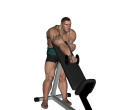 Dumbbell Curl - Standing Incline One Arm
Dumbbell Curl - Standing Incline One Arm
Benefits: This exercise works both heads of the biceps very similarly as the preacher curl.
Purpose: This exercise is used to target the biceps muscle to develop size, definition, strength, endurance and power.
Beginner Biceps Forearms Shoulders Strength Dumbbell Incline Bench Pull Gym
General Info: The biceps is a straight muscle with two heads. The long head of the biceps crosses both the elbow and the shoulder joint. It bends the elbow and raises the arm forward at the shoulder. The short head crosses the elbow joint and, in conjunction with the brachioradialis, supinates the hand.
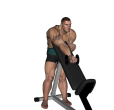 Dumbbell Curl - Standing Incline Single
Dumbbell Curl - Standing Incline Single
Benefits: This exercise works both heads of the biceps with a heavier weight than can typically be done with dumbbells.
Purpose: This exercise is used to target the biceps muscle to develop size, definition, strength, endurance and power.
Beginner Biceps Forearms Shoulders Strength Dumbbell Incline Bench Pull Gym
General Info: The biceps is a straight muscle with two heads. The long head of the biceps crosses both the elbow and the shoulder joint. It bends the elbow and raises the arm forward at the shoulder. The short head crosses the elbow joint and, in conjunction with the brachioradialis, supinates the hand.
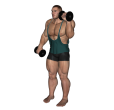 Dumbbell Curl - Standing Reverse Alternate
Dumbbell Curl - Standing Reverse Alternate
Benefits: This exercise works both heads of the biceps with a heavier weight than can typically be done with dumbbells.
Purpose: This exercise is used to target the biceps muscle to develop size, definition, strength, endurance and power.
Beginner Biceps Forearms Shoulders Strength Dumbbell Pull Gym
General Info: The biceps is a straight muscle with two heads. The long head of the biceps crosses both the elbow and the shoulder joint. It bends the elbow and raises the arm forward at the shoulder. The short head crosses the elbow joint and, in conjunction with the brachioradialis, supinates the hand.
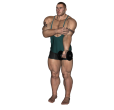 Dumbbell Curl - Standing Single
Dumbbell Curl - Standing Single
Benefits: This exercise works both heads of the biceps and isolates the biceps so that momentum does not come into play.
Purpose: This exercise is used to target the biceps muscle to develop size, definition, strength, endurance and power.
Beginner Biceps Forearms Shoulders Strength Dumbbell Pull Gym
General Info: The biceps is a straight muscle with two heads. The long head of the biceps crosses both the elbow and the shoulder joint. It bends the elbow and raises the arm forward at the shoulder. The short head crosses the elbow joint and, in conjunction with the brachioradialis, supinates the hand.
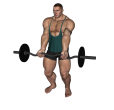 EZ Bar Curl - Basic
EZ Bar Curl - Basic
Benefits: This exercise puts the forearms in a stronger position, allowing you to lift heavier weights. The EZ Bar puts the hands in a very strong position.
Purpose: This exercise is used to target the biceps muscle to develop size, definition, strength, endurance and power.
Beginner Biceps Forearms Shoulders Strength EZ Bar Pull Gym
General Info: The biceps is a straight muscle with two heads. The long head of the biceps crosses both the elbow and the shoulder joint. It bends the elbow and raises the arm forward at the shoulder. The short head crosses the elbow joint and, in conjunction with the brachioradialis, supinates the hand.
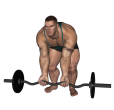 EZ Bar Curl - Bent Over
EZ Bar Curl - Bent Over
Benefits: This exercise is similar in effect to the Spider curl and does a good job of placing maximum tension on the biceps in the fully contracted position.
Purpose: This exercise works the biceps muscles but focuses also on the brachioradialis (a muscle that crosses the elbow joint and assists in rotating the forearm).
Beginner Biceps Forearms Shoulders Strength EZ Bar Pull Gym
General Info: The biceps is a straight muscle which has two heads. The long head crosses both the elbow and the shoulder joints. It bends the arm at the elbow and raises the arm forward at the shoulder. The short head crosses the elbow joint and, in conjunction with the brachioradialis, supinates the hand.
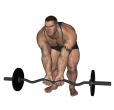 EZ Bar Curl - Bent Over Close Grip
EZ Bar Curl - Bent Over Close Grip
Benefits: This exercise is similar in effect to the Spider curl and does a good job of placing maximum tension on the biceps in the fully contracted position.
Purpose: This exercise works the biceps muscles but focuses also on the brachioradialis (a muscle that crosses the elbow joint and assists in rotating the forearm).
Beginner Biceps Forearms Shoulders Strength EZ Bar Pull Gym
General Info: The biceps is a straight muscle which has two heads. The long head crosses both the elbow and the shoulder joints. It bends the arm at the elbow and raises the arm forward at the shoulder. The short head crosses the elbow joint and, in conjunction with the brachioradialis, supinates the hand.
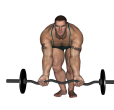 EZ Bar Curl - Bent Over Narrow Stance
EZ Bar Curl - Bent Over Narrow Stance
Benefits: This exercise is similar in effect to the Spider curl and does a good job of placing maximum tension on the biceps in the fully contracted position.
Purpose: This exercise works the biceps muscles but focuses also on the brachioradialis (a muscle that crosses the elbow joint and assists in rotating the forearm).
Beginner Biceps Forearms Shoulders Strength EZ Bar Pull Gym
General Info: The biceps is a straight muscle which has two heads. The long head crosses both the elbow and the shoulder joints. It bends the arm at the elbow and raises the arm forward at the shoulder. The short head crosses the elbow joint and, in conjunction with the brachioradialis, supinates the hand.
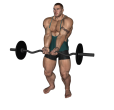 EZ Bar Curl - Close Grip
EZ Bar Curl - Close Grip
Benefits: This exercise works both heads of the biceps. The EZ Bar puts the hands in a very strong position.
Purpose: This exercise is used to target the biceps muscle to develop size, definition, strength, endurance and power.
Beginner Biceps Forearms Strength EZ Bar Pull Gym
General Info: The biceps is a straight muscle with two heads. The long head of the biceps crosses both the elbow and the shoulder joint. It bends the elbow and raises the arm forward at the shoulder. The short head crosses the elbow joint and, in conjunction with the brachioradialis, supinates the hand.
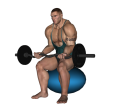 EZ Bar Curl - Fitness Ball
EZ Bar Curl - Fitness Ball
Benefits: This exercise puts the forearms in a stronger position, allowing you to lift heavier weights.
Purpose: This exercise is used to target the biceps muscle to develop size, definition, strength, endurance and power.
Beginner Biceps Forearms Shoulders Strength EZ Bar Fitness Ball Pull Gym
General Info: The biceps is a straight muscle with two heads. The long head of the biceps crosses both the elbow and the shoulder joint. It bends the elbow and raises the arm forward at the shoulder. The short head crosses the elbow joint and, in conjunction with the brachioradialis, supinates the hand.
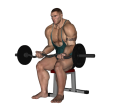 EZ Bar Curl - Seated
EZ Bar Curl - Seated
Benefits: This exercise isolates the biceps so that momentum does not come into play.
Purpose: This exercise strengthens the biceps.
Beginner Biceps Forearms Shoulders Traps Strength EZ Bar Flat Bench Pull Gym
General Info: The biceps muscle is a straight muscle with 2 heads. The long head crosses both the elbow and shoulder joints and bends the elbow and raises the arm forward at the shoulder. The short head of the biceps crosses the elbow joint and, in conjunction with the brachioradialis, supinates the hand..
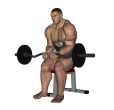 EZ Bar Curl - Seated Close Grip
EZ Bar Curl - Seated Close Grip
Benefits: This exercise isolates the biceps so that momentum does not come into play.
Purpose: This exercise strengthens the biceps.
Beginner Biceps Forearms Shoulders Traps Strength EZ Bar Flat Bench Pull Gym
General Info: The biceps muscle is a straight muscle with 2 heads. The long head crosses both the elbow and shoulder joints and bends the elbow and raises the arm forward at the shoulder. The short head of the biceps crosses the elbow joint and, in conjunction with the brachioradialis, supinates the hand..
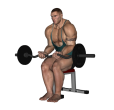 EZ Bar Curl - Seated Close Narrow
EZ Bar Curl - Seated Close Narrow
Benefits: This exercise isolates the biceps so that momentum does not come into play.
Purpose: This exercise strengthens the biceps.
Beginner Biceps Forearms Shoulders Traps Strength EZ Bar Flat Bench Pull Gym
General Info: The biceps muscle is a straight muscle with 2 heads. The long head crosses both the elbow and shoulder joints and bends the elbow and raises the arm forward at the shoulder. The short head of the biceps crosses the elbow joint and, in conjunction with the brachioradialis, supinates the hand..
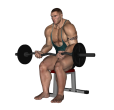 EZ Bar Curl - Seated Feet Up
EZ Bar Curl - Seated Feet Up
Benefits: This exercise isolates the biceps so that momentum does not come into play.
Purpose: This exercise strengthens the biceps.
Beginner Biceps Forearms Shoulders Traps Strength EZ Bar Flat Bench Pull Gym
General Info: The biceps muscle is a straight muscle with 2 heads. The long head crosses both the elbow and shoulder joints and bends the elbow and raises the arm forward at the shoulder. The short head of the biceps crosses the elbow joint and, in conjunction with the brachioradialis, supinates the hand..
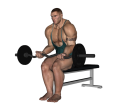 EZ Bar Curl - Seated Narrow Stance
EZ Bar Curl - Seated Narrow Stance
Benefits: This exercise isolates the biceps so that momentum does not come into play.
Purpose: This exercise strengthens the biceps.
Beginner Biceps Forearms Shoulders Traps Strength EZ Bar Flat Bench Pull Gym
General Info: The biceps muscle is a straight muscle with 2 heads. The long head crosses both the elbow and shoulder joints and bends the elbow and raises the arm forward at the shoulder. The short head of the biceps crosses the elbow joint and, in conjunction with the brachioradialis, supinates the hand..
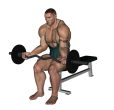 EZ Bar Curl - Seated Wide Grip
EZ Bar Curl - Seated Wide Grip
Benefits: This exercise isolates the biceps so that momentum does not come into play. The EZ Bar puts the hands in a very strong position.
Purpose: This exercise strengthens the biceps.
Beginner Biceps Forearms Shoulders Traps Strength EZ Bar Flat Bench Pull Gym
General Info: The biceps muscle is a straight muscle with 2 heads. The long head crosses both the elbow and shoulder joints and bends the elbow and raises the arm forward at the shoulder. The short head of the biceps crosses the elbow joint and, in conjunction with the brachioradialis, supinates the hand..
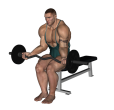 EZ Bar Curl - Seated Wide Narrow
EZ Bar Curl - Seated Wide Narrow
Benefits: This exercise isolates the biceps so that momentum does not come into play.
Purpose: This exercise strengthens the biceps.
Beginner Biceps Forearms Shoulders Traps Strength EZ Bar Flat Bench Pull Gym
General Info: The biceps muscle is a straight muscle with 2 heads. The long head crosses both the elbow and shoulder joints and bends the elbow and raises the arm forward at the shoulder. The short head of the biceps crosses the elbow joint and, in conjunction with the brachioradialis, supinates the hand..
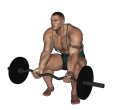 EZ Bar Curl - Squat
EZ Bar Curl - Squat
Benefits: This exercise isolates the biceps so that momentum does not come into play.
Purpose: This exercise strengthens the biceps.
Intermediate Biceps Forearms Shoulders Traps Strength EZ Bar Pull Gym
General Info: The biceps muscle is a straight muscle with 2 heads. The long head crosses both the elbow and shoulder joints and bends the elbow and raises the arm forward at the shoulder. The short head of the biceps crosses the elbow joint and, in conjunction with the brachioradialis, supinates the hand..
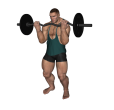 EZ Bar Curl - Standing
EZ Bar Curl - Standing
Benefits: This exercise puts the forearms in a stronger position, allowing you to lift heavier weights.
Purpose: This exercise is used to target the biceps muscle to develop size, definition, strength, endurance and power.
Beginner Biceps Forearms Shoulders Strength EZ Bar Pull Gym
General Info: The biceps is a straight muscle with two heads. The long head of the biceps crosses both the elbow and the shoulder joint. It bends the elbow and raises the arm forward at the shoulder. The short head crosses the elbow joint and, in conjunction with the brachioradialis, supinates the hand.
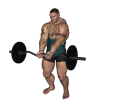 EZ Bar Curl - Standing Close Grip
EZ Bar Curl - Standing Close Grip
Benefits: This exercise puts the forearms in a stronger position, allowing you to lift heavier weights.
Purpose: This exercise is used to target the biceps muscle to develop size, definition, strength, endurance and power.
Beginner Biceps Forearms Shoulders Strength EZ Bar Pull Gym
General Info: The biceps is a straight muscle with two heads. The long head of the biceps crosses both the elbow and the shoulder joint. It bends the elbow and raises the arm forward at the shoulder. The short head crosses the elbow joint and, in conjunction with the brachioradialis, supinates the hand.
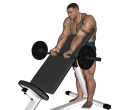 EZ Bar Curl - Standing Incline
EZ Bar Curl - Standing Incline
Benefits: This exercise works both heads of the biceps with a heavier weight than can typically be done with dumbbells.
Purpose: This exercise is used to target the biceps muscle to develop size, definition, strength, endurance and power.
Beginner Biceps Forearms Shoulders Strength EZ Bar Incline Bench Pull Gym
General Info: The biceps is a straight muscle with two heads. The long head of the biceps crosses both the elbow and the shoulder joint. It bends the elbow and raises the arm forward at the shoulder. The short head crosses the elbow joint and, in conjunction with the brachioradialis, supinates the hand.
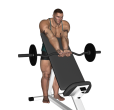 EZ Bar Curl - Standing Incline Close Grip
EZ Bar Curl - Standing Incline Close Grip
Benefits: This exercise works both heads of the biceps with a heavier weight than can typically be done with dumbbells.
Purpose: This exercise is used to target the biceps muscle to develop size, definition, strength, endurance and power.
Beginner Biceps Forearms Shoulders Strength EZ Bar Incline Bench Pull Gym
General Info: The biceps is a straight muscle with two heads. The long head of the biceps crosses both the elbow and the shoulder joint. It bends the elbow and raises the arm forward at the shoulder. The short head crosses the elbow joint and, in conjunction with the brachioradialis, supinates the hand.
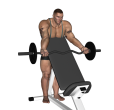 EZ Bar Curl - Standing Incline Wide Grip
EZ Bar Curl - Standing Incline Wide Grip
Benefits: This exercise works both heads of the biceps with a heavier weight than can typically be done with dumbbells.
Purpose: This exercise is used to target the biceps muscle to develop size, definition, strength, endurance and power.
Beginner Biceps Forearms Shoulders Strength EZ Bar Incline Bench Pull Gym
General Info: The biceps is a straight muscle with two heads. The long head of the biceps crosses both the elbow and the shoulder joint. It bends the elbow and raises the arm forward at the shoulder. The short head crosses the elbow joint and, in conjunction with the brachioradialis, supinates the hand.
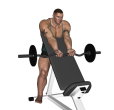 EZ Bar Curl - Standing Incline Wide Stance
EZ Bar Curl - Standing Incline Wide Stance
Benefits: This exercise works both heads of the biceps with a heavier weight than can typically be done with dumbbells.
Purpose: This exercise is used to target the biceps muscle to develop size, definition, strength, endurance and power.
Beginner Biceps Forearms Shoulders Strength EZ Bar Incline Bench Pull Gym
General Info: The biceps is a straight muscle with two heads. The long head of the biceps crosses both the elbow and the shoulder joint. It bends the elbow and raises the arm forward at the shoulder. The short head crosses the elbow joint and, in conjunction with the brachioradialis, supinates the hand.
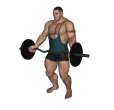 EZ Bar Curl - Standing Wide Grip
EZ Bar Curl - Standing Wide Grip
Benefits: This exercise puts the forearms in a stronger position, allowing you to lift heavier weights.
Purpose: This exercise is used to target the biceps muscle to develop size, definition, strength, endurance and power.
Beginner Biceps Forearms Shoulders Strength EZ Bar Pull Gym
General Info: The biceps is a straight muscle with two heads. The long head of the biceps crosses both the elbow and the shoulder joint. It bends the elbow and raises the arm forward at the shoulder. The short head crosses the elbow joint and, in conjunction with the brachioradialis, supinates the hand.
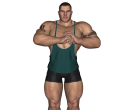 Finger Extensions - Basic
Finger Extensions - Basic
Benefits: This exercise focuses on the finger extensors, a muscle group that hardly is ever exercised in the gym.
Purpose: This exercise strengthens the muscles that extend the fingers.
Beginner Forearms Strength Body Only Pull Gym
General Info: A complete forearm program must achieve balanced development for all major forearm muscles. The forearm is involved in six different forearm movements. They include wrist flexion, wrist extension, wrist abduction, wrist adduction, forearm pronation, and forearm supination. There are additional muscles found in the forearm that are involved in movements like elbow flexion (brachioradialis), finger flexion, and finger extension.
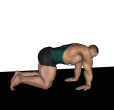 Forearm Stretch - Kneeling
Forearm Stretch - Kneeling
Benefits: This exercise focuses on the front of the wrist, a muscle group that hardly is ever stretched in the gym.
Purpose: This exercise stretches the tendons running down the front of the wrist.
Beginner Forearms Strength Body Only Gym
General Info: A complete forearm program must achieve balanced development for all major forearm muscles. The forearm is involved in six different forearm movements. They include wrist flexion, wrist extension, wrist abduction, wrist adduction, forearm pronation, and forearm supination. There are additional muscles found in the forearm that are involved in movements like elbow flexion (brachioradialis), finger flexion, and finger extension.
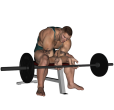 Grip Work - Basic
Grip Work - Basic
Benefits: This exercise focuses on the finger flexors with the forearms supinated.
Purpose: This exercise strengthens the muscles that flex the fingers.
Beginner Forearms Strength Barbell Pull Gym
General Info: A complete forearm program must achieve balanced development for all major forearm muscles. The forearm is involved in six different forearm movements. They include wrist flexion, wrist extension, wrist abduction, wrist adduction, forearm pronation, and forearm supination. There are additional muscles found in the forearm that are involved in movements like elbow flexion (brachioradialis), finger flexion, and finger extension.
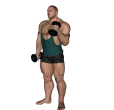 Hammer Curl - Alternate
Hammer Curl - Alternate
Benefits: The Alternative Hammer Curl places greater relative intensity on the biceps muscle.
Purpose: The Alternate Hammer Curl focuses on the biceps but also involves the brachioradialis.
Beginner Biceps Forearms Shoulders Strength Dumbbell Pull Gym
General Info: The biceps is a straight muscle with two heads. The long head of the biceps crosses both the elbow and the shoulder joints. It bends the elbow and raises the arm forward at the shoulder. The short head crosses the elbow joint and, in conjunction with the brachioradialis muscle, supinates the hand.
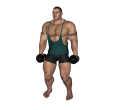 Hammer Curl - Basic
Hammer Curl - Basic
Benefits: The Hammer Curl places greater relative intensity on the biceps muscle. Using a hammer grip keeps the hands in a very strong position.
Purpose: The Hammer Curl focuses on the biceps but also involves the brachioradialis.
Beginner Biceps Forearms Shoulders Strength Dumbbell Pull Gym
General Info: The biceps is a straight muscle with two heads. The long head of the biceps crosses both the elbow and the shoulder joints. It bends the elbow and raises the arm forward at the shoulder. The short head crosses the elbow joint and, in conjunction with the brachioradialis muscle, supinates the hand.
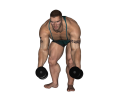 Hammer Curl - Bent Over
Hammer Curl - Bent Over
Benefits: This exercise is similar in effect to the Spider curl and does a good job of placing maximum tension on the biceps in the fully contracted position.
Purpose: This exercise works the biceps muscles but focuses also on the brachioradialis (a muscle that crosses the elbow joint and assists in rotating the forearm).
Beginner Biceps Forearms Shoulders Strength Dumbbell Pull Gym
General Info: The biceps is a straight muscle which has two heads. The long head crosses both the elbow and the shoulder joints. It bends the arm at the elbow and raises the arm forward at the shoulder. The short head crosses the elbow joint and, in conjunction with the brachioradialis, supinates the hand.
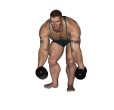 Hammer Curl - Bent Over Dumbbell Alternate
Hammer Curl - Bent Over Dumbbell Alternate
Benefits: This exercise does a good job of placing maximum tension on the biceps in the fully contracted position and also supinates the forearm..
Purpose: This exercise works the biceps muscles but focuses also on the brachioradialis (a muscle that crosses the elbow joint and assists in rotating the forearm).
Beginner Biceps Forearms Shoulders Strength Dumbbell Pull Gym
General Info: The biceps is a straight muscle which has two heads. The long head crosses both the elbow and the shoulder joints. It bends the arm at the elbow and raises the arm forward at the shoulder. The short head crosses the elbow joint and, in conjunction with the brachioradialis, supinates the hand.
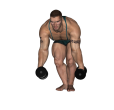 Hammer Curl - Bent Over Narrow Stance
Hammer Curl - Bent Over Narrow Stance
Benefits: This exercise does a good job of placing maximum tension on the biceps in the fully contracted position and also supinates the forearm..
Purpose: This exercise works the biceps muscles but focuses also on the brachioradialis (a muscle that crosses the elbow joint and assists in rotating the forearm).
Beginner Biceps Forearms Shoulders Strength Dumbbell Pull Gym
General Info: The biceps is a straight muscle which has two heads. The long head crosses both the elbow and the shoulder joints. It bends the arm at the elbow and raises the arm forward at the shoulder. The short head crosses the elbow joint and, in conjunction with the brachioradialis, supinates the hand.
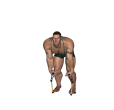 Hammer Curl - Bent Over Resistance
Hammer Curl - Bent Over Resistance
Benefits: This exercise is similar in effect to the Spider curl and does a good job of placing maximum tension on the biceps in the fully contracted position.
Purpose: This exercise works the biceps muscles but focuses also on the brachioradialis (a muscle that crosses the elbow joint and assists in rotating the forearm).
Beginner Biceps Forearms Shoulders Strength Resistance Tube Pull Gym
General Info: The biceps is a straight muscle which has two heads. The long head crosses both the elbow and the shoulder joints. It bends the arm at the elbow and raises the arm forward at the shoulder. The short head crosses the elbow joint and, in conjunction with the brachioradialis, supinates the hand.
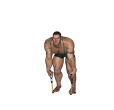 Hammer Curl - Bent Over Resistance Alternate
Hammer Curl - Bent Over Resistance Alternate
Benefits: This exercise is similar in effect to the Spider curl and does a good job of placing maximum tension on the biceps in the fully contracted position.
Purpose: This exercise works the biceps muscles but focuses also on the brachioradialis (a muscle that crosses the elbow joint and assists in rotating the forearm).
Beginner Biceps Forearms Shoulders Strength Resistance Tube Pull Gym
General Info: The biceps is a straight muscle which has two heads. The long head crosses both the elbow and the shoulder joints. It bends the arm at the elbow and raises the arm forward at the shoulder. The short head crosses the elbow joint and, in conjunction with the brachioradialis, supinates the hand.
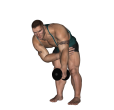 Hammer Curl - Bent Over Single
Hammer Curl - Bent Over Single
Benefits: The hammer curl places greater relative intensity on the brachioradialis muscle.
Purpose: The Alternate Hammer Curl focuses on the biceps but also involves the brachioradialis.
Beginner Biceps Forearms Shoulders Strength Dumbbell Pull Gym
General Info: The biceps is a straight muscle with two heads. The long head of the biceps crosses both the elbow and the shoulder joints. It bends the elbow and raises the arm forward at the shoulder. The short head crosses the elbow joint and, in conjunction with the brachioradialis muscle, supinates the hand.
 Hammer Curl - Bent Over Water Bottle
Hammer Curl - Bent Over Water Bottle
Benefits: This exercise is similar in effect to the Spider curl and does a good job of placing maximum tension on the biceps in the fully contracted position.
Purpose: This exercise works the biceps muscles but focuses also on the brachioradialis (a muscle that crosses the elbow joint and assists in rotating the forearm).
Beginner Biceps Forearms Shoulders Strength Water Bottle Pull Home
General Info: The biceps is a straight muscle which has two heads. The long head crosses both the elbow and the shoulder joints. It bends the arm at the elbow and raises the arm forward at the shoulder. The short head crosses the elbow joint and, in conjunction with the brachioradialis, supinates the hand.
 Hammer Curl - Bent Over Water Bottle Alternate
Hammer Curl - Bent Over Water Bottle Alternate
Benefits: This exercise does a good job of placing maximum tension on the biceps in the fully contracted position and also supinates the forearm..
Purpose: This exercise works the biceps muscles but focuses also on the brachioradialis (a muscle that crosses the elbow joint and assists in rotating the forearm).
Beginner Biceps Forearms Shoulders Strength Water Bottle Pull Home
General Info: The biceps is a straight muscle which has two heads. The long head crosses both the elbow and the shoulder joints. It bends the arm at the elbow and raises the arm forward at the shoulder. The short head crosses the elbow joint and, in conjunction with the brachioradialis, supinates the hand.
 Hammer Curl - Bent Over Water Bottle Narrow
Hammer Curl - Bent Over Water Bottle Narrow
Benefits: This exercise does a good job of placing maximum tension on the biceps in the fully contracted position and also supinates the forearm..
Purpose: This exercise works the biceps muscles but focuses also on the brachioradialis (a muscle that crosses the elbow joint and assists in rotating the forearm).
Beginner Biceps Forearms Shoulders Strength Water Bottle Pull Home
General Info: The biceps is a straight muscle which has two heads. The long head crosses both the elbow and the shoulder joints. It bends the arm at the elbow and raises the arm forward at the shoulder. The short head crosses the elbow joint and, in conjunction with the brachioradialis, supinates the hand.
 Hammer Curl - Bent Over Water Bottle Single
Hammer Curl - Bent Over Water Bottle Single
Benefits: The hammer curl places greater relative intensity on the brachioradialis muscle.
Purpose: The Alternate Hammer Curl focuses on the biceps but also involves the brachioradialis.
Beginner Biceps Forearms Shoulders Strength Water Bottle Pull Home
General Info: The biceps is a straight muscle with two heads. The long head of the biceps crosses both the elbow and the shoulder joints. It bends the elbow and raises the arm forward at the shoulder. The short head crosses the elbow joint and, in conjunction with the brachioradialis muscle, supinates the hand.
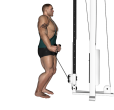 Hammer Curl - Cable Rope Attachment
Hammer Curl - Cable Rope Attachment
Benefits: The Cable Hammer Curl places greater relative intensity on the biceps muscle because there is always tension on the cable. Using a hammer grip keeps the hands in a very strong position.
Purpose: The Cable Hammer Curl focuses on the biceps but also involves the brachioradialis.
Beginner Biceps Forearms Shoulders Strength High Low Cable Machine Cable Rope Attachment Pull Gym
General Info: The biceps is a straight muscle with two heads. The long head of the biceps crosses both the elbow and the shoulder joints. It bends the elbow and raises the arm forward at the shoulder. The short head crosses the elbow joint and, in conjunction with the brachioradialis muscle, supinates the hand.
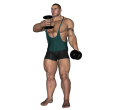 Hammer Curl - Cross Body
Hammer Curl - Cross Body
Benefits: This exercise works both heads of the biceps with a heavier weight than can typically be done with dumbbells.
Purpose: This exercise is used to target the biceps muscle to develop size, definition, strength, endurance and power.
Intermediate Biceps Forearms Shoulders Strength Dumbbell Pull Gym
General Info: The biceps is a straight muscle with two heads. The long head of the biceps crosses both the elbow and the shoulder joint. It bends the elbow and raises the arm forward at the shoulder. The short head crosses the elbow joint and, in conjunction with the brachioradialis, supinates the hand.
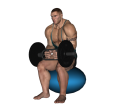 Hammer Curl - Fitness Ball Barbell
Hammer Curl - Fitness Ball Barbell
Benefits: This exercise isolates the biceps so that momentum does not come into play.
Purpose: This exercise strengthens the biceps.
Beginner Biceps Forearms Strength Hammer Barbell Fitness Ball Pull Gym
General Info: The biceps muscle is a straight muscle with 2 heads. The long head crosses both the elbow and shoulder joints and bends the elbow and raises the arm forward at the shoulder. The short head of the biceps crosses the elbow joint and, in conjunction with the brachioradialis, supinates the hand..
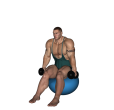 Hammer Curl - Fitness Ball Dumbbell
Hammer Curl - Fitness Ball Dumbbell
Benefits: This exercise isolates the biceps so that momentum does not come into play.
Purpose: This exercise strengthens the biceps.
Beginner Biceps Forearms Strength Dumbbell Fitness Ball Pull Gym
General Info: The biceps muscle is a straight muscle with 2 heads. The long head crosses both the elbow and shoulder joints and bends the elbow and raises the arm forward at the shoulder. The short head of the biceps crosses the elbow joint and, in conjunction with the brachioradialis, supinates the hand.
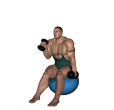 Hammer Curl - Fitness Ball Dumbbell Alternate
Hammer Curl - Fitness Ball Dumbbell Alternate
Benefits: This exercise isolates the biceps so that momentum does not come into play.
Purpose: This exercise strengthens the biceps.
Beginner Biceps Forearms Shoulders Traps Strength Dumbbell Fitness Ball Pull Gym
General Info: The biceps muscle is a straight muscle with 2 heads. The long head crosses both the elbow and shoulder joints and bends the elbow and raises the arm forward at the shoulder. The short head of the biceps crosses the elbow joint and, in conjunction with the brachioradialis, supinates the hand.
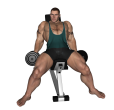 Hammer Curl - Incline Dumbbell
Hammer Curl - Incline Dumbbell
Benefits: The Hammer Curl places greater relative intensity on the biceps muscle.
Purpose: The Hammer Curl focuses on the biceps but also involves the brachioradialis.
Beginner Biceps Forearms Shoulders Strength Dumbbell Incline Bench Pull Gym
General Info: The biceps is a straight muscle with two heads. The long head of the biceps crosses both the elbow and the shoulder joints. It bends the elbow and raises the arm forward at the shoulder. The short head crosses the elbow joint and, in conjunction with the brachioradialis muscle, supinates the hand.
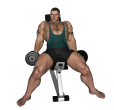 Hammer Curl - Incline Dumbbell Alternate
Hammer Curl - Incline Dumbbell Alternate
Benefits: The Alternative Hammer Curl places greater relative intensity on the biceps muscle.
Purpose: The Alternate Hammer Curl focuses on the biceps but also involves the brachioradialis.
Beginner Biceps Forearms Shoulders Strength Dumbbell Incline Bench Pull Gym
General Info: The biceps is a straight muscle with two heads. The long head of the biceps crosses both the elbow and the shoulder joints. It bends the elbow and raises the arm forward at the shoulder. The short head crosses the elbow joint and, in conjunction with the brachioradialis muscle, supinates the hand.
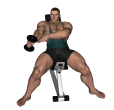 Hammer Curl - Incline Single
Hammer Curl - Incline Single
Benefits: This exercise works both heads of the biceps with a heavier weight than can typically be done with dumbbells.
Purpose: This exercise is used to target the biceps muscle to develop size, definition, strength, endurance and power.
Beginner Biceps Forearms Shoulders Strength Dumbbell Incline Bench Pull Gym
General Info: The biceps is a straight muscle with two heads. The long head of the biceps crosses both the elbow and the shoulder joint. It bends the elbow and raises the arm forward at the shoulder. The short head crosses the elbow joint and, in conjunction with the brachioradialis, supinates the hand.
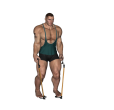 Hammer Curl - Resistance Tube
Hammer Curl - Resistance Tube
Benefits: The Alternative Hammer Curl places greater relative intensity on the biceps muscle. Using a hammer grip keeps the hands in a very strong position.
Purpose: The Alternate Hammer Curl focuses on the biceps but also involves the brachioradialis.
Beginner Biceps Forearms Shoulders Strength Resistance Tube Pull Gym
General Info: The biceps is a straight muscle with two heads. The long head of the biceps crosses both the elbow and the shoulder joints. It bends the elbow and raises the arm forward at the shoulder. The short head crosses the elbow joint and, in conjunction with the brachioradialis muscle, supinates the hand.
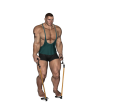 Hammer Curl - Resistance Tube Alternate
Hammer Curl - Resistance Tube Alternate
Benefits: The Alternative Hammer Curl places greater relative intensity on the biceps muscle. Using a hammer grip keeps the hands in a very strong position.
Purpose: The Alternate Hammer Curl focuses on the biceps but also involves the brachioradialis.
Beginner Biceps Forearms Shoulders Strength Resistance Tube Pull Gym
General Info: The biceps is a straight muscle with two heads. The long head of the biceps crosses both the elbow and the shoulder joints. It bends the elbow and raises the arm forward at the shoulder. The short head crosses the elbow joint and, in conjunction with the brachioradialis muscle, supinates the hand.
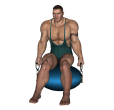 Hammer Curl - Resistance Tube Ball
Hammer Curl - Resistance Tube Ball
Benefits: This exercise isolates the biceps so that momentum does not come into play.
Purpose: This exercise strengthens the biceps.
Beginner Biceps Forearms Strength Fitness Ball Resistance Tube Pull Gym
General Info: The biceps muscle is a straight muscle with 2 heads. The long head crosses both the elbow and shoulder joints and bends the elbow and raises the arm forward at the shoulder. The short head of the biceps crosses the elbow joint and, in conjunction with the brachioradialis, supinates the hand..
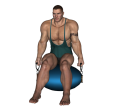 Hammer Curl - Resistance Tube Ball Alternate
Hammer Curl - Resistance Tube Ball Alternate
Benefits: This exercise isolates the biceps so that momentum does not come into play.
Purpose: This exercise strengthens the biceps.
Beginner Biceps Forearms Strength Fitness Ball Resistance Tube Pull Gym
General Info: The biceps muscle is a straight muscle with 2 heads. The long head crosses both the elbow and shoulder joints and bends the elbow and raises the arm forward at the shoulder. The short head of the biceps crosses the elbow joint and, in conjunction with the brachioradialis, supinates the hand..
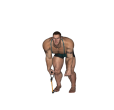 Hammer Curl - Resistance Tube Bent Single
Hammer Curl - Resistance Tube Bent Single
Benefits: This exercise isolates the biceps so that momentum does not come into play.
Purpose: This exercise strengthens the biceps.
Beginner Biceps Forearms Strength Resistance Tube Pull Gym
General Info: The biceps muscle is a straight muscle with 2 heads. The long head crosses both the elbow and shoulder joints and bends the elbow and raises the arm forward at the shoulder. The short head of the biceps crosses the elbow joint and, in conjunction with the brachioradialis, supinates the hand..
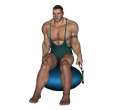 Hammer Curl - Resistance Tube Seated Single
Hammer Curl - Resistance Tube Seated Single
Benefits: This exercise isolates the biceps so that momentum does not come into play.
Purpose: This exercise strengthens the biceps.
Beginner Biceps Forearms Shoulders Traps Strength Resistance Tube Fitness Ball Pull Gym
General Info: The biceps muscle is a straight muscle with 2 heads. The long head crosses both the elbow and shoulder joints and bends the elbow and raises the arm forward at the shoulder. The short head of the biceps crosses the elbow joint and, in conjunction with the brachioradialis, supinates the hand.
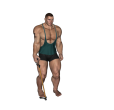 Hammer Curl - Resistance Tube Single
Hammer Curl - Resistance Tube Single
Benefits: This exercise works both heads of the biceps with a heavier weight than can typically be done with dumbbells.
Purpose: This exercise is used to target the biceps muscle to develop size, definition, strength, endurance and power.
Beginner Biceps Forearms Shoulders Strength Resistance Tube Pull Gym
General Info: The biceps is a straight muscle with two heads. The long head of the biceps crosses both the elbow and the shoulder joint. It bends the elbow and raises the arm forward at the shoulder. The short head crosses the elbow joint and, in conjunction with the brachioradialis, supinates the hand.
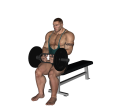 Hammer Curl - Seated Barbell
Hammer Curl - Seated Barbell
Benefits: This exercise isolates the biceps so that momentum does not come into play. Using a hammer grip keeps the hands in a very strong position.
Purpose: This exercise strengthens the biceps.
Beginner Biceps Forearms Shoulders Traps Strength Hammer Barbell Flat Bench Pull Gym
General Info: The biceps muscle is a straight muscle with 2 heads. The long head crosses both the elbow and shoulder joints and bends the elbow and raises the arm forward at the shoulder. The short head of the biceps crosses the elbow joint and, in conjunction with the brachioradialis, supinates the hand..
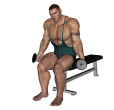 Hammer Curl - Seated Dumbbell
Hammer Curl - Seated Dumbbell
Benefits: This exercise isolates the biceps so that momentum does not come into play. Using a hammer grip keeps the hands in a very strong position.
Purpose: This exercise strengthens the biceps.
Beginner Biceps Forearms Shoulders Traps Strength Dumbbell Flat Bench Pull Gym
General Info: The biceps muscle is a straight muscle with 2 heads. The long head crosses both the elbow and shoulder joints and bends the elbow and raises the arm forward at the shoulder. The short head of the biceps crosses the elbow joint and, in conjunction with the brachioradialis, supinates the hand..
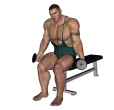 Hammer Curl - Seated Dumbbell Alternate
Hammer Curl - Seated Dumbbell Alternate
Benefits: This exercise isolates the biceps so that momentum does not come into play. Using a hammer grip keeps the hands in a very strong position.
Purpose: This exercise strengthens the biceps.
Beginner Biceps Forearms Shoulders Traps Strength Dumbbell Flat Bench Pull Gym
General Info: The biceps muscle is a straight muscle with 2 heads. The long head crosses both the elbow and shoulder joints and bends the elbow and raises the arm forward at the shoulder. The short head of the biceps crosses the elbow joint and, in conjunction with the brachioradialis, supinates the hand..
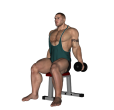 Hammer Curl - Seated Dumbbell Feet Up
Hammer Curl - Seated Dumbbell Feet Up
Benefits: This exercise isolates the biceps so that momentum does not come into play.
Purpose: This exercise strengthens the biceps.
Intermediate Biceps Forearms Shoulders Traps Strength Dumbbell Flat Bench Pull Gym
General Info: The biceps muscle is a straight muscle with 2 heads. The long head crosses both the elbow and shoulder joints and bends the elbow and raises the arm forward at the shoulder. The short head of the biceps crosses the elbow joint and, in conjunction with the brachioradialis, supinates the hand..
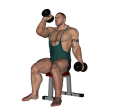 Hammer Curl - Seated Dumbbell Feet Up Alternate
Hammer Curl - Seated Dumbbell Feet Up Alternate
Benefits: This exercise isolates the biceps so that momentum does not come into play.
Purpose: This exercise strengthens the biceps.
Intermediate Biceps Forearms Shoulders Traps Strength Dumbbell Flat Bench Pull Gym
General Info: The biceps muscle is a straight muscle with 2 heads. The long head crosses both the elbow and shoulder joints and bends the elbow and raises the arm forward at the shoulder. The short head of the biceps crosses the elbow joint and, in conjunction with the brachioradialis, supinates the hand..
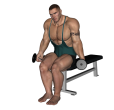 Hammer Curl - Seated Dumbbell Narrow
Hammer Curl - Seated Dumbbell Narrow
Benefits: This exercise isolates the biceps so that momentum does not come into play.
Purpose: This exercise strengthens the biceps.
Beginner Biceps Forearms Shoulders Traps Strength Dumbbell Flat Bench Pull Gym
General Info: The biceps muscle is a straight muscle with 2 heads. The long head crosses both the elbow and shoulder joints and bends the elbow and raises the arm forward at the shoulder. The short head of the biceps crosses the elbow joint and, in conjunction with the brachioradialis, supinates the hand..
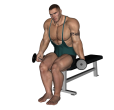 Hammer Curl - Seated Dumbbell Narrow Alternate
Hammer Curl - Seated Dumbbell Narrow Alternate
Benefits: This exercise isolates the biceps so that momentum does not come into play.
Purpose: This exercise strengthens the biceps.
Beginner Biceps Forearms Shoulders Traps Strength Dumbbell Flat Bench Pull Gym
General Info: The biceps muscle is a straight muscle with 2 heads. The long head crosses both the elbow and shoulder joints and bends the elbow and raises the arm forward at the shoulder. The short head of the biceps crosses the elbow joint and, in conjunction with the brachioradialis, supinates the hand..
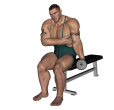 Hammer Curl - Seated Dumbbell Single
Hammer Curl - Seated Dumbbell Single
Benefits: This exercise isolates the biceps so that momentum does not come into play.
Purpose: This exercise strengthens the biceps.
Beginner Biceps Forearms Shoulders Traps Strength Dumbbell Flat Bench Pull Gym
General Info: The biceps muscle is a straight muscle with 2 heads. The long head crosses both the elbow and shoulder joints and bends the elbow and raises the arm forward at the shoulder. The short head of the biceps crosses the elbow joint and, in conjunction with the brachioradialis, supinates the hand..
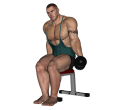 Hammer Curl - Seated Dumbbell Single Narrow
Hammer Curl - Seated Dumbbell Single Narrow
Benefits: This exercise isolates the biceps so that momentum does not come into play.
Purpose: This exercise strengthens the biceps.
Beginner Biceps Forearms Shoulders Traps Strength Dumbbell Flat Bench Pull Gym
General Info: The biceps muscle is a straight muscle with 2 heads. The long head crosses both the elbow and shoulder joints and bends the elbow and raises the arm forward at the shoulder. The short head of the biceps crosses the elbow joint and, in conjunction with the brachioradialis, supinates the hand..
 Hammer Curl - Seated Water Bottle
Hammer Curl - Seated Water Bottle
Benefits: This exercise isolates the biceps so that momentum does not come into play.
Purpose: This exercise strengthens the biceps.
Beginner Biceps Forearms Shoulders Traps Strength Water Bottle Chair Pull Home
General Info: The biceps muscle is a straight muscle with 2 heads. The long head crosses both the elbow and shoulder joints and bends the elbow and raises the arm forward at the shoulder. The short head of the biceps crosses the elbow joint and, in conjunction with the brachioradialis, supinates the hand..
 Hammer Curl - Seated Water Bottle Alternate
Hammer Curl - Seated Water Bottle Alternate
Benefits: This exercise isolates the biceps so that momentum does not come into play.
Purpose: This exercise strengthens the biceps.
Beginner Biceps Forearms Shoulders Traps Strength Water Bottle Chair Pull Home
General Info: The biceps muscle is a straight muscle with 2 heads. The long head crosses both the elbow and shoulder joints and bends the elbow and raises the arm forward at the shoulder. The short head of the biceps crosses the elbow joint and, in conjunction with the brachioradialis, supinates the hand..
 Hammer Curl - Seated Water Bottle Feet Up
Hammer Curl - Seated Water Bottle Feet Up
Benefits: This exercise isolates the biceps so that momentum does not come into play.
Purpose: This exercise strengthens the biceps.
Intermediate Biceps Forearms Shoulders Traps Strength Water Bottle Chair Pull Home
General Info: The biceps muscle is a straight muscle with 2 heads. The long head crosses both the elbow and shoulder joints and bends the elbow and raises the arm forward at the shoulder. The short head of the biceps crosses the elbow joint and, in conjunction with the brachioradialis, supinates the hand..
 Hammer Curl - Seated Water Bottle Feet Up Alternate
Hammer Curl - Seated Water Bottle Feet Up Alternate
Benefits: This exercise isolates the biceps so that momentum does not come into play.
Purpose: This exercise strengthens the biceps.
Intermediate Biceps Forearms Shoulders Traps Strength Water Bottle Chair Pull Home
General Info: The biceps muscle is a straight muscle with 2 heads. The long head crosses both the elbow and shoulder joints and bends the elbow and raises the arm forward at the shoulder. The short head of the biceps crosses the elbow joint and, in conjunction with the brachioradialis, supinates the hand..
 Hammer Curl - Seated Water Bottle Narrow
Hammer Curl - Seated Water Bottle Narrow
Benefits: This exercise isolates the biceps so that momentum does not come into play.
Purpose: This exercise strengthens the biceps.
Beginner Biceps Forearms Shoulders Traps Strength Water Bottle Chair Pull Home
General Info: The biceps muscle is a straight muscle with 2 heads. The long head crosses both the elbow and shoulder joints and bends the elbow and raises the arm forward at the shoulder. The short head of the biceps crosses the elbow joint and, in conjunction with the brachioradialis, supinates the hand..
 Hammer Curl - Seated Water Bottle Narrow Alternate
Hammer Curl - Seated Water Bottle Narrow Alternate
Benefits: This exercise isolates the biceps so that momentum does not come into play.
Purpose: This exercise strengthens the biceps.
Beginner Biceps Forearms Shoulders Traps Strength Water Bottle Chair Pull Home
General Info: The biceps muscle is a straight muscle with 2 heads. The long head crosses both the elbow and shoulder joints and bends the elbow and raises the arm forward at the shoulder. The short head of the biceps crosses the elbow joint and, in conjunction with the brachioradialis, supinates the hand..
 Hammer Curl - Seated Water Bottle Single
Hammer Curl - Seated Water Bottle Single
Benefits: This exercise isolates the biceps so that momentum does not come into play.
Purpose: This exercise strengthens the biceps.
Beginner Biceps Forearms Shoulders Traps Strength Water Bottle Chair Pull Home
General Info: The biceps muscle is a straight muscle with 2 heads. The long head crosses both the elbow and shoulder joints and bends the elbow and raises the arm forward at the shoulder. The short head of the biceps crosses the elbow joint and, in conjunction with the brachioradialis, supinates the hand..
 Hammer Curl - Seated Water Bottle Single Narrow
Hammer Curl - Seated Water Bottle Single Narrow
Benefits: This exercise isolates the biceps so that momentum does not come into play.
Purpose: This exercise strengthens the biceps.
Beginner Biceps Forearms Shoulders Traps Strength Water Bottle Chair Pull Home
General Info: The biceps muscle is a straight muscle with 2 heads. The long head crosses both the elbow and shoulder joints and bends the elbow and raises the arm forward at the shoulder. The short head of the biceps crosses the elbow joint and, in conjunction with the brachioradialis, supinates the hand..
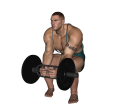 Hammer Curl - Squat Barbell
Hammer Curl - Squat Barbell
Benefits: This exercise isolates the biceps so that momentum does not come into play.
Purpose: This exercise strengthens the biceps.
Intermediate Biceps Forearms Shoulders Traps Strength Hammer Barbell Pull Gym
General Info: The biceps muscle is a straight muscle with 2 heads. The long head crosses both the elbow and shoulder joints and bends the elbow and raises the arm forward at the shoulder. The short head of the biceps crosses the elbow joint and, in conjunction with the brachioradialis, supinates the hand..
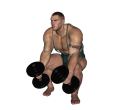 Hammer Curl - Squat Dumbbell
Hammer Curl - Squat Dumbbell
Benefits: This exercise isolates the biceps so that momentum does not come into play.
Purpose: This exercise strengthens the biceps.
Beginner Biceps Forearms Shoulders Traps Strength Dumbbell Pull Gym
General Info: The biceps muscle is a straight muscle with 2 heads. The long head crosses both the elbow and shoulder joints and bends the elbow and raises the arm forward at the shoulder. The short head of the biceps crosses the elbow joint and, in conjunction with the brachioradialis, supinates the hand..
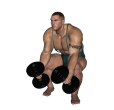 Hammer Curl - Squat Dumbbell Single
Hammer Curl - Squat Dumbbell Single
Benefits: This exercise isolates the biceps so that momentum does not come into play.
Purpose: This exercise strengthens the biceps.
Beginner Biceps Forearms Shoulders Traps Strength Dumbbell Pull Gym
General Info: The biceps muscle is a straight muscle with 2 heads. The long head crosses both the elbow and shoulder joints and bends the elbow and raises the arm forward at the shoulder. The short head of the biceps crosses the elbow joint and, in conjunction with the brachioradialis, supinates the hand..
 Hammer Curl - Squat Water Bottle
Hammer Curl - Squat Water Bottle
Benefits: This exercise isolates the biceps so that momentum does not come into play.
Purpose: This exercise strengthens the biceps.
Beginner Biceps Forearms Shoulders Traps Strength Water Bottle Pull Home
General Info: The biceps muscle is a straight muscle with 2 heads. The long head crosses both the elbow and shoulder joints and bends the elbow and raises the arm forward at the shoulder. The short head of the biceps crosses the elbow joint and, in conjunction with the brachioradialis, supinates the hand..
 Hammer Curl - Squat Water Bottle Single
Hammer Curl - Squat Water Bottle Single
Benefits: This exercise isolates the biceps so that momentum does not come into play.
Purpose: This exercise strengthens the biceps.
Beginner Biceps Forearms Shoulders Traps Strength Water Bottle Pull Home
General Info: The biceps muscle is a straight muscle with 2 heads. The long head crosses both the elbow and shoulder joints and bends the elbow and raises the arm forward at the shoulder. The short head of the biceps crosses the elbow joint and, in conjunction with the brachioradialis, supinates the hand..
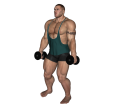 Hammer Curl - Standing
Hammer Curl - Standing
Benefits: This exercise works both heads of the biceps with a heavier weight than can typically be done with dumbbells.
Purpose: This exercise is used to target the biceps. Using a hammer grip keeps the hands in a very strong position.
Beginner Biceps Forearms Shoulders Strength Dumbbell Pull Gym
General Info: The biceps is a straight muscle with two heads. The long head of the biceps crosses both the elbow and the shoulder joint. It bends the elbow and raises the arm forward at the shoulder. The short head crosses the elbow joint and, in conjunction with the brachioradialis, supinates the hand.
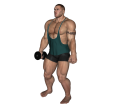 Hammer Curl - Standing Dumbbell Single
Hammer Curl - Standing Dumbbell Single
Benefits: This exercise isolates the biceps so that momentum does not come into play. Using a hammer grip keeps the hands in a very strong position.
Purpose: This exercise strengthens the biceps.
Beginner Biceps Forearms Shoulders Traps Strength Dumbbell Pull Gym
General Info: The biceps muscle is a straight muscle with 2 heads. The long head crosses both the elbow and shoulder joints and bends the elbow and raises the arm forward at the shoulder. The short head of the biceps crosses the elbow joint and, in conjunction with the brachioradialis, supinates the hand..
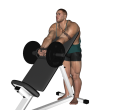 Hammer Curl - Standing Incline Barbell
Hammer Curl - Standing Incline Barbell
Benefits: This exercise works both heads of the biceps similar to a hammer barbell preacher curl.
Purpose: This exercise is used to target the biceps muscle to develop size, definition, strength, endurance and power.
Beginner Biceps Forearms Shoulders Strength Hammer Barbell Incline Bench Pull Gym
General Info: The biceps is a straight muscle with two heads. The long head of the biceps crosses both the elbow and the shoulder joint. It bends the elbow and raises the arm forward at the shoulder. The short head crosses the elbow joint and, in conjunction with the brachioradialis, supinates the hand.
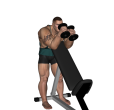 Hammer Curl - Standing Incline Dumbbell
Hammer Curl - Standing Incline Dumbbell
Benefits: This exercise works both heads of the biceps similar to a hammer dumbbell preacher curl.
Purpose: This exercise is used to target the biceps muscle to develop size, definition, strength, endurance and power.
Beginner Biceps Forearms Shoulders Strength Dumbbell Incline Bench Pull Gym
General Info: The biceps is a straight muscle with two heads. The long head of the biceps crosses both the elbow and the shoulder joint. It bends the elbow and raises the arm forward at the shoulder. The short head crosses the elbow joint and, in conjunction with the brachioradialis, supinates the hand.
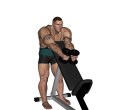 Hammer Curl - Standing Incline Dumbbell Alternate
Hammer Curl - Standing Incline Dumbbell Alternate
Benefits: This exercise works both heads of the biceps with a heavier weight than can typically be done with dumbbells.
Purpose: This exercise is used to target the biceps muscle to develop size, definition, strength, endurance and power.
Beginner Biceps Forearms Shoulders Strength Dumbbell Incline Bench Pull Gym
General Info: The biceps is a straight muscle with two heads. The long head of the biceps crosses both the elbow and the shoulder joint. It bends the elbow and raises the arm forward at the shoulder. The short head crosses the elbow joint and, in conjunction with the brachioradialis, supinates the hand.
 Hammer Curl - Standing Water Bottle
Hammer Curl - Standing Water Bottle
Benefits: This exercise works both heads of the biceps with a heavier weight than can typically be done with dumbbells.
Purpose: This exercise is used to target the biceps muscle to develop size, definition, strength, endurance and power.
Beginner Biceps Forearms Shoulders Strength Water Bottle Pull Home
General Info: The biceps is a straight muscle with two heads. The long head of the biceps crosses both the elbow and the shoulder joint. It bends the elbow and raises the arm forward at the shoulder. The short head crosses the elbow joint and, in conjunction with the brachioradialis, supinates the hand.
 Hammer Curl - Standing Water Bottle Single
Hammer Curl - Standing Water Bottle Single
Benefits: This exercise isolates the biceps so that momentum does not come into play.
Purpose: This exercise strengthens the biceps.
Beginner Biceps Forearms Shoulders Traps Strength Water Bottle Pull Home
General Info: The biceps muscle is a straight muscle with 2 heads. The long head crosses both the elbow and shoulder joints and bends the elbow and raises the arm forward at the shoulder. The short head of the biceps crosses the elbow joint and, in conjunction with the brachioradialis, supinates the hand..
 Hammer Curl - Water Bottle Alternate
Hammer Curl - Water Bottle Alternate
Benefits: The Alternative Hammer Curl places greater relative intensity on the biceps muscle.
Purpose: The Alternate Hammer Curl focuses on the biceps but also involves the brachioradialis.
Beginner Biceps Forearms Shoulders Strength Water Bottle Pull Home
General Info: The biceps is a straight muscle with two heads. The long head of the biceps crosses both the elbow and the shoulder joints. It bends the elbow and raises the arm forward at the shoulder. The short head crosses the elbow joint and, in conjunction with the brachioradialis muscle, supinates the hand.
 Hammer Curl - Water Bottle Basic
Hammer Curl - Water Bottle Basic
Benefits: The Hammer Curl places greater relative intensity on the biceps muscle.
Purpose: The Hammer Curl focuses on the biceps but also involves the brachioradialis.
Beginner Biceps Forearms Shoulders Strength Water Bottle Pull Home
General Info: The biceps is a straight muscle with two heads. The long head of the biceps crosses both the elbow and the shoulder joints. It bends the elbow and raises the arm forward at the shoulder. The short head crosses the elbow joint and, in conjunction with the brachioradialis muscle, supinates the hand.
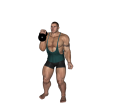 Kettlebell - Arnold Press
Kettlebell - Arnold Press
Benefits: Arnold Press vs a Barbell Press gives a wide range of motion as you lower the dumbbells well down in front giving that maximum stretch other shoulder exercises lack. Essentially it is a combination of two moves which isolate shoulder muscles - shoulder press and a lateral raise.
Purpose: To build muscle mass in the front and side heads of the deltoids. Arnold Shoulder Press is an excellent alternative to Shoulder Dumbbell press and can be used to spice up your workouts. I perform Arnold press and shoulder dumbbell presses on alternate weeks for variety in my workouts.
Intermediate Shoulders Forearms Triceps Strength Kettlebell Push Compound Gym
General Info: When it comes to the best exercise with the best range of motion for Shoulder muscles, Arnold press stands out from the crowd. It was created by bodybuilder Arnold Schwarzenegger and hits both the medial and front heads of deltoids.
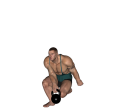 Kettlebell - One Legged Deadlift
Kettlebell - One Legged Deadlift
Benefits: This exercise involves many other muscles.
Purpose: This exercise builds overall strength in the lower body.
Lower Back Glutes Hamstrings Calves Quads Forearms Lats Middle Back Traps Strength Kettlebell Pull Compound Gym
General Info: The muscles of the lower back straighten the spine. They work together with the abdominals to keep the spine upright. The Barbell Deadlift is considered to be the king of exercises. No other exercise will work your body so much.
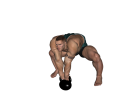 Kettlebell - Sumo High Pull
Kettlebell - Sumo High Pull
Benefits: This exercise involves many other muscles.
Purpose: This exercise builds overall strength in the lower body.
Lower Back Glutes Hamstrings Calves Quads Forearms Lats Middle Back Traps Strength Kettlebell Pull Compound Gym
General Info: The muscles of the lower back straighten the spine. They work together with the abdominals to keep the spine upright. The Barbell Deadlift is considered to be the king of exercises. No other exercise will work your body so much.
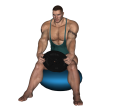 Plate Curl - Fitness Ball
Plate Curl - Fitness Ball
Benefits: This exercise isolates the biceps so that momentum does not come into play.
Purpose: This exercise strengthens the biceps.
Beginner Biceps Forearms Strength Plate Fitness Ball Pull Gym
General Info: The biceps muscle is a straight muscle with 2 heads. The long head crosses both the elbow and shoulder joints and bends the elbow and raises the arm forward at the shoulder. The short head of the biceps crosses the elbow joint and, in conjunction with the brachioradialis, supinates the hand..
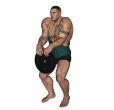 Plate Curl - Reverse
Plate Curl - Reverse
Benefits: This exercise isolates the biceps so that momentum does not come into play.
Purpose: This exercise strengthens the biceps.
Beginner Biceps Forearms Strength Plate Pull Gym
General Info: The biceps muscle is a straight muscle with 2 heads. The long head crosses both the elbow and shoulder joints and bends the elbow and raises the arm forward at the shoulder. The short head of the biceps crosses the elbow joint and, in conjunction with the brachioradialis, supinates the hand..
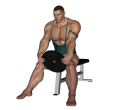 Plate Curl - Seated
Plate Curl - Seated
Benefits: This exercise isolates the biceps so that momentum does not come into play.
Purpose: This exercise strengthens the biceps.
Beginner Biceps Forearms Strength Plate Flat Bench Pull Gym
General Info: The biceps muscle is a straight muscle with 2 heads. The long head crosses both the elbow and shoulder joints and bends the elbow and raises the arm forward at the shoulder. The short head of the biceps crosses the elbow joint and, in conjunction with the brachioradialis, supinates the hand..
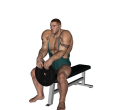 Plate Curl - Seated Reverse
Plate Curl - Seated Reverse
Benefits: This exercise isolates the biceps so that momentum does not come into play.
Purpose: This exercise strengthens the biceps.
Beginner Biceps Forearms Strength Plate Flat Bench Pull Gym
General Info: The biceps muscle is a straight muscle with 2 heads. The long head crosses both the elbow and shoulder joints and bends the elbow and raises the arm forward at the shoulder. The short head of the biceps crosses the elbow joint and, in conjunction with the brachioradialis, supinates the hand..
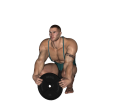 Plate Curl - Squat
Plate Curl - Squat
Benefits: This exercise isolates the biceps so that momentum does not come into play.
Purpose: This exercise strengthens the biceps.
Intermediate Biceps Forearms Shoulders Traps Strength Plate Pull Gym
General Info: The biceps muscle is a straight muscle with 2 heads. The long head crosses both the elbow and shoulder joints and bends the elbow and raises the arm forward at the shoulder. The short head of the biceps crosses the elbow joint and, in conjunction with the brachioradialis, supinates the hand..
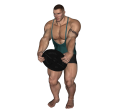 Plate Curl - Standing
Plate Curl - Standing
Benefits: This exercise isolates the biceps so that momentum does not come into play.
Purpose: This exercise strengthens the biceps.
Beginner Biceps Forearms Strength Plate Pull Gym
General Info: The biceps muscle is a straight muscle with 2 heads. The long head crosses both the elbow and shoulder joints and bends the elbow and raises the arm forward at the shoulder. The short head of the biceps crosses the elbow joint and, in conjunction with the brachioradialis, supinates the hand..
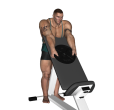 Plate Curl - Standing Incline
Plate Curl - Standing Incline
Benefits: This exercise works both heads of the biceps and is very similar to the preacher curl.
Purpose: This exercise is used to target the biceps muscle to develop size, definition, strength, endurance and power.
Beginner Biceps Forearms Shoulders Strength Plate Incline Bench Pull Gym
General Info: The biceps is a straight muscle with two heads. The long head of the biceps crosses both the elbow and the shoulder joint. It bends the elbow and raises the arm forward at the shoulder. The short head crosses the elbow joint and, in conjunction with the brachioradialis, supinates the hand.
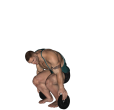 Plate Pinch - Basic
Plate Pinch - Basic
Benefits: This exercise focuses finger gripping and strength. To get the greatest benefit from this exercise, ensure that you hold the plates until you cannot hold them any longer, then minimum rest and do it again.
Purpose: This exercise strengthens the forearm muscles as well as finger strength.
Intermediate Forearms Fingers Strength Plate Gym
General Info: A complete forearm program must achieve balanced development for all major forearm muscles. The forearm is involved in six different forearm movements. They include wrist flexion, wrist extension, wrist abduction, wrist adduction, forearm pronation, and forearm supination. There are additional muscles found in the forearm that are involved in movements like elbow flexion (brachioradialis), finger flexion, and finger extension.
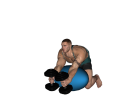 Preacher Curl - Ball Dumbbell Hammer Single
Preacher Curl - Ball Dumbbell Hammer Single
Benefits: This exercise isolates the biceps so that momentum does not come into play.
Purpose: This exercise strengthens the biceps.
Beginner Biceps Forearms Shoulders Traps Strength Dumbbell Fitness Ball Pull Gym
General Info: The biceps muscle is a straight muscle with 2 heads. The long head crosses both the elbow and shoulder joints and bends the elbow and raises the arm forward at the shoulder. The short head of the biceps crosses the elbow joint and, in conjunction with the brachioradialis, supinates the hand.
 Preacher Curl - Ball Dumbbell Zottman Single
Preacher Curl - Ball Dumbbell Zottman Single
Benefits: This exercise isolates the biceps so that momentum does not come into play.
Purpose: This exercise strengthens the biceps.
Beginner Biceps Forearms Shoulders Traps Strength Dumbbell Fitness Ball Pull Gym
General Info: The biceps muscle is a straight muscle with 2 heads. The long head crosses both the elbow and shoulder joints and bends the elbow and raises the arm forward at the shoulder. The short head of the biceps crosses the elbow joint and, in conjunction with the brachioradialis, supinates the hand.
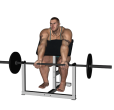 Preacher Curl - Barbell
Preacher Curl - Barbell
Benefits: This exercise isolates the biceps so that momentum does not come into play.
Purpose: This exercise strengthens the biceps.
Beginner Biceps Forearms Shoulders Traps Strength Barbell Preacher Bench Pull Gym
General Info: The biceps muscle is a straight muscle with 2 heads. The long head crosses both the elbow and shoulder joints and bends the elbow and raises the arm forward at the shoulder. The short head of the biceps crosses the elbow joint and, in conjunction with the brachioradialis, supinates the hand.
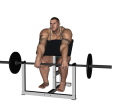 Preacher Curl - Barbell Reverse
Preacher Curl - Barbell Reverse
Benefits: Reverse curls work the forearms more than regular bicep curls.
Purpose: This exercise increases strength and produces greater functional strength in both the biceps and the forearms.
Intermediate Forearms Biceps Strength Barbell Preacher Bench Pull Gym
General Info: The biceps is a straight muscle with two heads. The long head of the biceps crosses both the elbow and the shoulder joints. It bends the elbow and raises the arm forward at the shoulder. The short head crosses the elbow joint and, in conjunction with the brachioradialis muscle, supinates the hand. When the hands are placed in a reverse grip, they work the forearm muscles more.
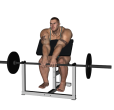 Preacher Curl - Barbell Reverse Close Grip
Preacher Curl - Barbell Reverse Close Grip
Benefits: Reverse curls work the forearms more than regular bicep curls.
Purpose: This exercise increases strength and produces greater functional strength in both the biceps and the forearms.
Intermediate Forearms Biceps Strength Barbell Preacher Bench Pull Gym
General Info: The biceps is a straight muscle with two heads. The long head of the biceps crosses both the elbow and the shoulder joints. It bends the elbow and raises the arm forward at the shoulder. The short head crosses the elbow joint and, in conjunction with the brachioradialis muscle, supinates the hand. When the hands are placed in a reverse grip, they work the forearm muscles more.
 Preacher Curl - Barbell With Chains
Preacher Curl - Barbell With Chains
Benefits: This exercise is done with the addition of chains. The primary function of chains is to accommodate resistance. Chains are also a great means of weight loading (adding more weight to an exercise). Chains are also a great way for working the stabilizers.
Purpose: Benefits This exercise isolates the biceps so that momentum does not come into play.
Beginner Biceps Forearms Shoulders Traps Strength Barbell Chains Preacher Bench Pull Gym
General Info: The biceps muscle is a straight muscle with 2 heads. The long head crosses both the elbow and shoulder joints and bends the elbow and raises the arm forward at the shoulder. The short head of the biceps crosses the elbow joint and, in conjunction with the brachioradialis, supinates the hand.
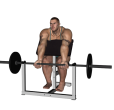 Preacher Curl - Basic
Preacher Curl - Basic
Benefits: This exercise isolates the biceps so that momentum does not come into play.
Purpose: This exercise strengthens the biceps.
Beginner Biceps Forearms Shoulders Traps Strength Barbell Preacher Bench Pull Gym
General Info: The biceps muscle is a straight muscle with 2 heads. The long head crosses both the elbow and shoulder joints and bends the elbow and raises the arm forward at the shoulder. The short head of the biceps crosses the elbow joint and, in conjunction with the brachioradialis, supinates the hand.
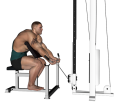 Preacher Curl - Cable
Preacher Curl - Cable
Benefits: This exercise isolates the biceps so that momentum does not come into play. The cable keeps tension on the muscles throughout the exercise.
Purpose: This exercise strengthens the biceps.
Beginner Biceps Forearms Shoulders Traps Strength Cable Machine Preacher Bench Pull Gym
General Info: The biceps muscle is a straight muscle with 2 heads. The long head crosses both the elbow and shoulder joints and bends the elbow and raises the arm forward at the shoulder. The short head of the biceps crosses the elbow joint and, in conjunction with the brachioradialis, supinates the hand.
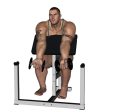 Preacher Curl - Dumbbell
Preacher Curl - Dumbbell
Benefits: This exercise isolates the biceps so that momentum does not come into play.
Purpose: This exercise strengthens the biceps.
Beginner Biceps Forearms Shoulders Traps Strength Dumbbell Preacher Bench Pull Gym
General Info: The biceps muscle is a straight muscle with 2 heads. The long head crosses both the elbow and shoulder joints and bends the elbow and raises the arm forward at the shoulder. The short head of the biceps crosses the elbow joint and, in conjunction with the brachioradialis, supinates the hand.
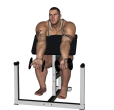 Preacher Curl - Dumbbell Alternate
Preacher Curl - Dumbbell Alternate
Benefits: This exercise isolates the biceps so that momentum does not come into play.
Purpose: This exercise strengthens the biceps.
Beginner Biceps Forearms Shoulders Traps Strength Dumbbell Preacher Bench Pull Gym
General Info: The biceps muscle is a straight muscle with 2 heads. The long head crosses both the elbow and shoulder joints and bends the elbow and raises the arm forward at the shoulder. The short head of the biceps crosses the elbow joint and, in conjunction with the brachioradialis, supinates the hand.
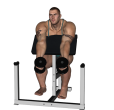 Preacher Curl - Dumbbell Hammer
Preacher Curl - Dumbbell Hammer
Benefits: This exercise isolates the biceps so that momentum does not come into play.
Purpose: This exercise strengthens the biceps.
Beginner Biceps Forearms Strength Dumbbell Preacher Bench Pull Gym
General Info: The biceps muscle is a straight muscle with 2 heads. The long head crosses both the elbow and shoulder joints and bends the elbow and raises the arm forward at the shoulder. The short head of the biceps crosses the elbow joint and, in conjunction with the brachioradialis, supinates the hand.
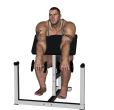 Preacher Curl - Dumbbell Reverse
Preacher Curl - Dumbbell Reverse
Benefits: Reverse curls work the forearms more than regular bicep curls. The reverse grip makes the exercise more difficult.
Purpose: This exercise increases strength and produces greater functional strength in both the biceps and the forearms.
Intermediate Forearms Biceps Strength Dumbbell Preacher Bench Pull Gym
General Info: The biceps is a straight muscle with two heads. The long head of the biceps crosses both the elbow and the shoulder joints. It bends the elbow and raises the arm forward at the shoulder. The short head crosses the elbow joint and, in conjunction with the brachioradialis muscle, supinates the hand. When the hands are placed in a reverse grip, they work the forearm muscles more.
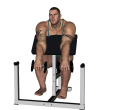 Preacher Curl - Dumbbell Reverse Alternate
Preacher Curl - Dumbbell Reverse Alternate
Benefits: Reverse curls work the forearms more than regular bicep curls. The reverse grip makes the exercise more difficult.
Purpose: This exercise increases strength and produces greater functional strength in both the biceps and the forearms.
Intermediate Forearms Biceps Strength Dumbbell Preacher Bench Pull Gym
General Info: The biceps is a straight muscle with two heads. The long head of the biceps crosses both the elbow and the shoulder joints. It bends the elbow and raises the arm forward at the shoulder. The short head crosses the elbow joint and, in conjunction with the brachioradialis muscle, supinates the hand. When the hands are placed in a reverse grip, they work the forearm muscles more.
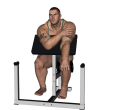 Preacher Curl - Dumbbell Reverse Single
Preacher Curl - Dumbbell Reverse Single
Benefits: This exercise isolates the biceps so that momentum does not come into play. The reverse grip makes the exercise more difficult.
Purpose: This exercise strengthens the biceps.
Beginner Biceps Forearms Shoulders Traps Strength Dumbbell Preacher Bench Pull Gym
General Info: The biceps muscle is a straight muscle with 2 heads. The long head crosses both the elbow and shoulder joints and bends the elbow and raises the arm forward at the shoulder. The short head of the biceps crosses the elbow joint and, in conjunction with the brachioradialis, supinates the hand.
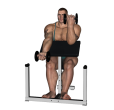 Preacher Curl - Dumbbell Single
Preacher Curl - Dumbbell Single
Benefits: This exercise isolates the biceps so that momentum does not come into play.
Purpose: This exercise strengthens the biceps.
Beginner Biceps Forearms Shoulders Traps Strength Dumbbell Preacher Bench Pull Gym
General Info: The biceps muscle is a straight muscle with 2 heads. The long head crosses both the elbow and shoulder joints and bends the elbow and raises the arm forward at the shoulder. The short head of the biceps crosses the elbow joint and, in conjunction with the brachioradialis, supinates the hand.
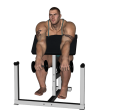 Preacher Curl - Dumbbell Zottman
Preacher Curl - Dumbbell Zottman
Benefits: This exercise isolates the biceps so that momentum does not come into play. The rotation used in this exercise works the forearms.
Purpose: This exercise strengthens the biceps.
Beginner Biceps Forearms Shoulders Traps Strength Dumbbell Preacher Bench Pull Gym
General Info: The biceps muscle is a straight muscle with 2 heads. The long head crosses both the elbow and shoulder joints and bends the elbow and raises the arm forward at the shoulder. The short head of the biceps crosses the elbow joint and, in conjunction with the brachioradialis, supinates the hand.
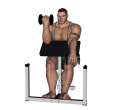 Preacher Curl - Dumbbell Zottman Alternate
Preacher Curl - Dumbbell Zottman Alternate
Benefits: This exercise isolates the biceps so that momentum does not come into play. The rotation used in this exercise works the forearms.
Purpose: This exercise strengthens the biceps.
Beginner Biceps Forearms Shoulders Traps Strength Dumbbell Preacher Bench Pull Gym
General Info: The biceps muscle is a straight muscle with 2 heads. The long head crosses both the elbow and shoulder joints and bends the elbow and raises the arm forward at the shoulder. The short head of the biceps crosses the elbow joint and, in conjunction with the brachioradialis, supinates the hand.
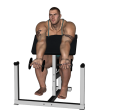 Preacher Curl - Dumbbell Zottman Reverse
Preacher Curl - Dumbbell Zottman Reverse
Benefits: This exercise isolates the biceps so that momentum does not come into play. The rotation used in this exercise works the forearms.
Purpose: This exercise strengthens the biceps.
Beginner Biceps Forearms Shoulders Traps Strength Dumbbell Preacher Bench Pull Gym
General Info: The biceps muscle is a straight muscle with 2 heads. The long head crosses both the elbow and shoulder joints and bends the elbow and raises the arm forward at the shoulder. The short head of the biceps crosses the elbow joint and, in conjunction with the brachioradialis, supinates the hand.
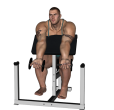 Preacher Curl - Dumbbell Zottman Reverse Alternate
Preacher Curl - Dumbbell Zottman Reverse Alternate
Benefits: This exercise isolates the biceps so that momentum does not come into play. The rotation used in this exercise works the forearms.
Purpose: This exercise strengthens the biceps.
Beginner Biceps Forearms Shoulders Traps Strength Dumbbell Preacher Bench Pull Gym
General Info: The biceps muscle is a straight muscle with 2 heads. The long head crosses both the elbow and shoulder joints and bends the elbow and raises the arm forward at the shoulder. The short head of the biceps crosses the elbow joint and, in conjunction with the brachioradialis, supinates the hand.
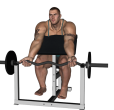 Preacher Curl - EZ Bar
Preacher Curl - EZ Bar
Benefits: This exercise isolates the biceps so that momentum does not come into play.
Purpose: This exercise strengthens the biceps.
Beginner Biceps Forearms Shoulders Traps Strength Barbell Preacher Bench Pull Gym
General Info: The biceps muscle is a straight muscle with 2 heads. The long head crosses both the elbow and shoulder joints and bends the elbow and raises the arm forward at the shoulder. The short head of the biceps crosses the elbow joint and, in conjunction with the brachioradialis, supinates the hand.
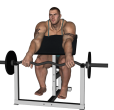 Preacher Curl - EZ Bar Reverse
Preacher Curl - EZ Bar Reverse
Benefits: Reverse curls work the forearms more than regular bicep curls. The reverse grip makes the exercise more difficult.
Purpose: This exercise increases strength and produces greater functional strength in both the biceps and the forearms.
Intermediate Forearms Biceps Strength EZ Bar Preacher Bench Pull Gym
General Info: The biceps is a straight muscle with two heads. The long head of the biceps crosses both the elbow and the shoulder joints. It bends the elbow and raises the arm forward at the shoulder. The short head crosses the elbow joint and, in conjunction with the brachioradialis muscle, supinates the hand. When the hands are placed in a reverse grip, they work the forearm muscles more.
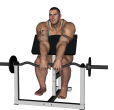 Preacher Curl - EZ Bar Reverse Close Grip
Preacher Curl - EZ Bar Reverse Close Grip
Benefits: Reverse curls work the forearms more than regular bicep curls. The reverse grip makes the exercise more difficult.
Purpose: This exercise increases strength and produces greater functional strength in both the biceps and the forearms.
Intermediate Forearms Biceps Strength EZ Bar Preacher Bench Pull Gym
General Info: The biceps is a straight muscle with two heads. The long head of the biceps crosses both the elbow and the shoulder joints. It bends the elbow and raises the arm forward at the shoulder. The short head crosses the elbow joint and, in conjunction with the brachioradialis muscle, supinates the hand. When the hands are placed in a reverse grip, they work the forearm muscles more.
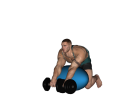 Preacher Curl - Fit Ball Dumbbell Reverse Single
Preacher Curl - Fit Ball Dumbbell Reverse Single
Benefits: This exercise isolates the biceps so that momentum does not come into play.
Purpose: This exercise strengthens the biceps.
Beginner Biceps Forearms Shoulders Traps Strength Dumbbell Fitness Ball Pull Gym
General Info: The biceps muscle is a straight muscle with 2 heads. The long head crosses both the elbow and shoulder joints and bends the elbow and raises the arm forward at the shoulder. The short head of the biceps crosses the elbow joint and, in conjunction with the brachioradialis, supinates the hand.
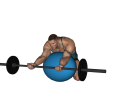 Preacher Curl - Fitness Ball Barbell
Preacher Curl - Fitness Ball Barbell
Benefits: This exercise isolates the biceps so that momentum does not come into play.
Purpose: This exercise strengthens the biceps.
Beginner Biceps Forearms Shoulders Traps Strength Barbell Fitness Ball Pull Gym
General Info: The biceps muscle is a straight muscle with 2 heads. The long head crosses both the elbow and shoulder joints and bends the elbow and raises the arm forward at the shoulder. The short head of the biceps crosses the elbow joint and, in conjunction with the brachioradialis, supinates the hand.
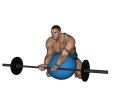 Preacher Curl - Fitness Ball Barbell Close Grip
Preacher Curl - Fitness Ball Barbell Close Grip
Benefits: This exercise isolates the biceps so that momentum does not come into play.
Purpose: This exercise strengthens the biceps.
Beginner Biceps Forearms Shoulders Traps Strength Barbell Fitness Ball Pull Gym
General Info: The biceps muscle is a straight muscle with 2 heads. The long head crosses both the elbow and shoulder joints and bends the elbow and raises the arm forward at the shoulder. The short head of the biceps crosses the elbow joint and, in conjunction with the brachioradialis, supinates the hand.
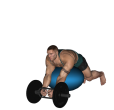 Preacher Curl - Fitness Ball Barbell Hammer
Preacher Curl - Fitness Ball Barbell Hammer
Benefits: This exercise isolates the biceps so that momentum does not come into play.
Purpose: This exercise strengthens the biceps.
Beginner Biceps Forearms Strength Hammer Barbell Fitness Ball Pull Gym
General Info: The biceps muscle is a straight muscle with 2 heads. The long head crosses both the elbow and shoulder joints and bends the elbow and raises the arm forward at the shoulder. The short head of the biceps crosses the elbow joint and, in conjunction with the brachioradialis, supinates the hand.
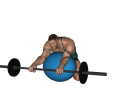 Preacher Curl - Fitness Ball Barbell Reverse
Preacher Curl - Fitness Ball Barbell Reverse
Benefits: This exercise isolates the biceps so that momentum does not come into play. The reverse grip makes the exercise more difficult.
Purpose: This exercise strengthens the biceps.
Beginner Biceps Forearms Shoulders Traps Strength Barbell Fitness Ball Pull Gym
General Info: The biceps muscle is a straight muscle with 2 heads. The long head crosses both the elbow and shoulder joints and bends the elbow and raises the arm forward at the shoulder. The short head of the biceps crosses the elbow joint and, in conjunction with the brachioradialis, supinates the hand.
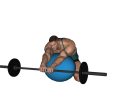 Preacher Curl - Fitness Ball Barbell Reverse Close
Preacher Curl - Fitness Ball Barbell Reverse Close
Benefits: This exercise isolates the biceps so that momentum does not come into play. The reverse grip makes the exercise more difficult.
Purpose: This exercise strengthens the biceps.
Beginner Biceps Forearms Shoulders Traps Strength Barbell Fitness Ball Pull Gym
General Info: The biceps muscle is a straight muscle with 2 heads. The long head crosses both the elbow and shoulder joints and bends the elbow and raises the arm forward at the shoulder. The short head of the biceps crosses the elbow joint and, in conjunction with the brachioradialis, supinates the hand.
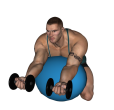 Preacher Curl - Fitness Ball Dumbbell
Preacher Curl - Fitness Ball Dumbbell
Benefits: This exercise isolates the biceps so that momentum does not come into play.
Purpose: This exercise strengthens the biceps.
Beginner Biceps Forearms Shoulders Traps Strength Dumbbell Fitness Ball Pull Gym
General Info: The biceps muscle is a straight muscle with 2 heads. The long head crosses both the elbow and shoulder joints and bends the elbow and raises the arm forward at the shoulder. The short head of the biceps crosses the elbow joint and, in conjunction with the brachioradialis, supinates the hand.
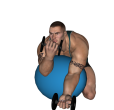 Preacher Curl - Fitness Ball Dumbbell Alternate
Preacher Curl - Fitness Ball Dumbbell Alternate
Benefits: This exercise isolates the biceps so that momentum does not come into play.
Purpose: This exercise strengthens the biceps.
Beginner Biceps Forearms Shoulders Traps Strength Dumbbell Fitness Ball Pull Gym
General Info: The biceps muscle is a straight muscle with 2 heads. The long head crosses both the elbow and shoulder joints and bends the elbow and raises the arm forward at the shoulder. The short head of the biceps crosses the elbow joint and, in conjunction with the brachioradialis, supinates the hand.
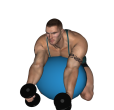 Preacher Curl - Fitness Ball Dumbbell Hammer
Preacher Curl - Fitness Ball Dumbbell Hammer
Benefits: This exercise isolates the biceps so that momentum does not come into play.
Purpose: This exercise strengthens the biceps.
Beginner Biceps Forearms Shoulders Traps Strength Dumbbell Fitness Ball Pull Gym
General Info: The biceps muscle is a straight muscle with 2 heads. The long head crosses both the elbow and shoulder joints and bends the elbow and raises the arm forward at the shoulder. The short head of the biceps crosses the elbow joint and, in conjunction with the brachioradialis, supinates the hand.
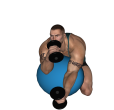 Preacher Curl - Fitness Ball Dumbbell Hammer Alternate
Preacher Curl - Fitness Ball Dumbbell Hammer Alternate
Benefits: This exercise isolates the biceps so that momentum does not come into play.
Purpose: This exercise strengthens the biceps.
Beginner Biceps Forearms Shoulders Traps Strength Dumbbell Fitness Ball Pull Gym
General Info: The biceps muscle is a straight muscle with 2 heads. The long head crosses both the elbow and shoulder joints and bends the elbow and raises the arm forward at the shoulder. The short head of the biceps crosses the elbow joint and, in conjunction with the brachioradialis, supinates the hand.
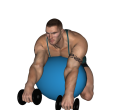 Preacher Curl - Fitness Ball Dumbbell Reverse
Preacher Curl - Fitness Ball Dumbbell Reverse
Benefits: This exercise isolates the biceps so that momentum does not come into play. The reverse grip makes the exercise more difficult.
Purpose: This exercise strengthens the biceps.
Beginner Biceps Forearms Shoulders Traps Strength Dumbbell Fitness Ball Pull Gym
General Info: The biceps muscle is a straight muscle with 2 heads. The long head crosses both the elbow and shoulder joints and bends the elbow and raises the arm forward at the shoulder. The short head of the biceps crosses the elbow joint and, in conjunction with the brachioradialis, supinates the hand.
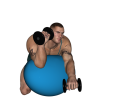 Preacher Curl - Fitness Ball Dumbbell Reverse Alternate
Preacher Curl - Fitness Ball Dumbbell Reverse Alternate
Benefits: This exercise isolates the biceps so that momentum does not come into play. The reverse grip makes the exercise more difficult.
Purpose: This exercise strengthens the biceps.
Beginner Biceps Forearms Shoulders Traps Strength Dumbbell Fitness Ball Pull Gym
General Info: The biceps muscle is a straight muscle with 2 heads. The long head crosses both the elbow and shoulder joints and bends the elbow and raises the arm forward at the shoulder. The short head of the biceps crosses the elbow joint and, in conjunction with the brachioradialis, supinates the hand.
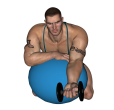 Preacher Curl - Fitness Ball Dumbbell Single
Preacher Curl - Fitness Ball Dumbbell Single
Benefits: This exercise isolates the biceps so that momentum does not come into play.
Purpose: This exercise strengthens the biceps.
Beginner Biceps Forearms Shoulders Traps Strength Dumbbell Fitness Ball Pull Gym
General Info: The biceps muscle is a straight muscle with 2 heads. The long head crosses both the elbow and shoulder joints and bends the elbow and raises the arm forward at the shoulder. The short head of the biceps crosses the elbow joint and, in conjunction with the brachioradialis, supinates the hand.
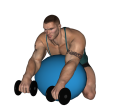 Preacher Curl - Fitness Ball Dumbbell Zottman
Preacher Curl - Fitness Ball Dumbbell Zottman
Benefits: This exercise isolates the biceps so that momentum does not come into play. The rotation used in this exercise works the forearms.
Purpose: This exercise strengthens the biceps.
Beginner Biceps Forearms Shoulders Traps Strength Dumbbell Fitness Ball Pull Gym
General Info: The biceps muscle is a straight muscle with 2 heads. The long head crosses both the elbow and shoulder joints and bends the elbow and raises the arm forward at the shoulder. The short head of the biceps crosses the elbow joint and, in conjunction with the brachioradialis, supinates the hand.
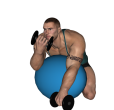 Preacher Curl - Fitness Ball Dumbbell Zottman Alternate
Preacher Curl - Fitness Ball Dumbbell Zottman Alternate
Benefits: This exercise isolates the biceps so that momentum does not come into play. The rotation used in this exercise works the forearms.
Purpose: This exercise strengthens the biceps.
Beginner Biceps Forearms Shoulders Traps Strength Dumbbell Fitness Ball Pull Gym
General Info: The biceps muscle is a straight muscle with 2 heads. The long head crosses both the elbow and shoulder joints and bends the elbow and raises the arm forward at the shoulder. The short head of the biceps crosses the elbow joint and, in conjunction with the brachioradialis, supinates the hand.
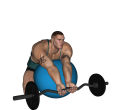 Preacher Curl - Fitness Ball EZ Bar
Preacher Curl - Fitness Ball EZ Bar
Benefits: This exercise isolates the biceps so that momentum does not come into play.
Purpose: This exercise strengthens the biceps.
Beginner Biceps Forearms Shoulders Traps Strength EZ Bar Fitness Ball Pull Gym
General Info: The biceps muscle is a straight muscle with 2 heads. The long head crosses both the elbow and shoulder joints and bends the elbow and raises the arm forward at the shoulder. The short head of the biceps crosses the elbow joint and, in conjunction with the brachioradialis, supinates the hand.
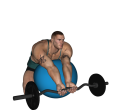 Preacher Curl - Fitness Ball EZ Bar Close Grip
Preacher Curl - Fitness Ball EZ Bar Close Grip
Benefits: This exercise isolates the biceps so that momentum does not come into play.
Purpose: This exercise strengthens the biceps.
Beginner Biceps Forearms Shoulders Traps Strength EZ Bar Fitness Ball Pull Gym
General Info: The biceps muscle is a straight muscle with 2 heads. The long head crosses both the elbow and shoulder joints and bends the elbow and raises the arm forward at the shoulder. The short head of the biceps crosses the elbow joint and, in conjunction with the brachioradialis, supinates the hand.
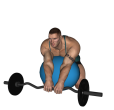 Preacher Curl - Fitness Ball EZ Bar Reverse Close
Preacher Curl - Fitness Ball EZ Bar Reverse Close
Benefits: Reverse curls work the forearms more than regular bicep curls. The reverse grip makes the exercise more difficult.
Purpose: This exercise increases strength and produces greater functional strength in both the biceps and the forearms.
Beginner Biceps Forearms Strength EZ Bar Fitness Ball Pull Gym
General Info: The biceps is a straight muscle with two heads. The long head of the biceps crosses both the elbow and the shoulder joints. It bends the elbow and raises the arm forward at the shoulder. The short head crosses the elbow joint and, in conjunction with the brachioradialis muscle, supinates the hand. When the hands are placed in a reverse grip, they work the forearm muscles more.
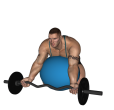 Preacher Curl - Fitness Ball EZ Bar Wide Grip
Preacher Curl - Fitness Ball EZ Bar Wide Grip
Benefits: This exercise isolates the biceps so that momentum does not come into play.
Purpose: This exercise strengthens the biceps.
Beginner Biceps Forearms Shoulders Traps Strength EZ Bar Fitness Ball Pull Gym
General Info: The biceps muscle is a straight muscle with 2 heads. The long head crosses both the elbow and shoulder joints and bends the elbow and raises the arm forward at the shoulder. The short head of the biceps crosses the elbow joint and, in conjunction with the brachioradialis, supinates the hand.
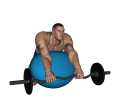 Preacher Curl - Fitness Ball EZ Reverse
Preacher Curl - Fitness Ball EZ Reverse
Benefits: Reverse curls work the forearms more than regular bicep curls. The reverse grip makes the exercise more difficult.
Purpose: This exercise increases strength and produces greater functional strength in both the biceps and the forearms.
Beginner Biceps Forearms Strength EZ Bar Fitness Ball Pull Gym
General Info: The biceps is a straight muscle with two heads. The long head of the biceps crosses both the elbow and the shoulder joints. It bends the elbow and raises the arm forward at the shoulder. The short head crosses the elbow joint and, in conjunction with the brachioradialis muscle, supinates the hand. When the hands are placed in a reverse grip, they work the forearm muscles more.
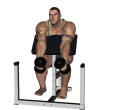 Preacher Curl - Hammer Dumbbell
Preacher Curl - Hammer Dumbbell
Benefits: This exercise isolates the biceps so that momentum does not come into play.
Purpose: This exercise strengthens the biceps.
Beginner Biceps Forearms Strength Dumbbell Preacher Bench Pull Gym
General Info: The biceps muscle is a straight muscle with 2 heads. The long head crosses both the elbow and shoulder joints and bends the elbow and raises the arm forward at the shoulder. The short head of the biceps crosses the elbow joint and, in conjunction with the brachioradialis, supinates the hand.
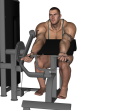 Preacher Curl - Machine
Preacher Curl - Machine
Benefits: This exercise isolates the biceps so that momentum does not come into play.
Purpose: This exercise strengthens the biceps.
Beginner Biceps Forearms Shoulders Traps Strength Preacher Curl Machine Pull Gym
General Info: The biceps muscle is a straight muscle with 2 heads. The long head crosses both the elbow and shoulder joints and bends the elbow and raises the arm forward at the shoulder. The short head of the biceps crosses the elbow joint and, in conjunction with the brachioradialis, supinates the hand.
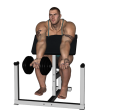 Preacher Curl - One Arm Dumbbell
Preacher Curl - One Arm Dumbbell
Benefits: This exercise isolates the biceps so that momentum does not come into play.
Purpose: This exercise strengthens the biceps.
Beginner Biceps Forearms Shoulders Traps Strength Dumbbell Preacher Bench Pull Gym
General Info: The biceps muscle is a straight muscle with 2 heads. The long head crosses both the elbow and shoulder joints and bends the elbow and raises the arm forward at the shoulder. The short head of the biceps crosses the elbow joint and, in conjunction with the brachioradialis, supinates the hand.
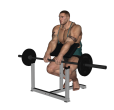 Preacher Curl - Reverse Barbell Close Grip
Preacher Curl - Reverse Barbell Close Grip
Benefits: Reverse curls work the forearms more than regular bicep curls.
Purpose: This exercise increases strength and produces greater functional strength in both the biceps and the forearms.
Intermediate Forearms Biceps Strength Barbell Preacher Bench Pull Gym
General Info: The biceps is a straight muscle with two heads. The long head of the biceps crosses both the elbow and the shoulder joints. It bends the elbow and raises the arm forward at the shoulder. The short head crosses the elbow joint and, in conjunction with the brachioradialis muscle, supinates the hand. When the hands are placed in a reverse grip, they work the forearm muscles more.
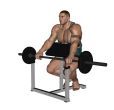 Preacher Curl - Reverse Barbell Wide Grip
Preacher Curl - Reverse Barbell Wide Grip
Benefits: Reverse curls work the forearms more than regular bicep curls.
Purpose: This exercise increases strength and produces greater functional strength in both the biceps and the forearms.
Intermediate Forearms Biceps Strength Barbell Preacher Bench Pull Gym
General Info: The biceps is a straight muscle with two heads. The long head of the biceps crosses both the elbow and the shoulder joints. It bends the elbow and raises the arm forward at the shoulder. The short head crosses the elbow joint and, in conjunction with the brachioradialis muscle, supinates the hand. When the hands are placed in a reverse grip, they work the forearm muscles more.
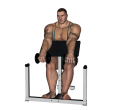 Preacher Curl - Reverse Dumbbell
Preacher Curl - Reverse Dumbbell
Benefits: Reverse curls work the forearms more than regular bicep curls.
Purpose: This exercise increases strength and produces greater functional strength in both the biceps and the forearms.
Intermediate Forearms Biceps Strength Dumbbell Preacher Bench Pull Gym
General Info: The biceps is a straight muscle with two heads. The long head of the biceps crosses both the elbow and the shoulder joints. It bends the elbow and raises the arm forward at the shoulder. The short head crosses the elbow joint and, in conjunction with the brachioradialis muscle, supinates the hand. When the hands are placed in a reverse grip, they work the forearm muscles more.
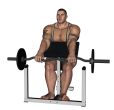 Preacher Curl - Reverse EZ Bar
Preacher Curl - Reverse EZ Bar
Benefits: Reverse curls work the forearms more than regular bicep curls.
Purpose: This exercise increases strength and produces greater functional strength in both the biceps and the forearms.
Intermediate Forearms Biceps Strength EZ Bar Preacher Bench Pull Gym
General Info: The biceps is a straight muscle with two heads. The long head of the biceps crosses both the elbow and the shoulder joints. It bends the elbow and raises the arm forward at the shoulder. The short head crosses the elbow joint and, in conjunction with the brachioradialis muscle, supinates the hand. When the hands are placed in a reverse grip, they work the forearm muscles more.
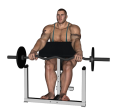 Preacher Curl - Reverse EZ Bar Wide Grip
Preacher Curl - Reverse EZ Bar Wide Grip
Benefits: Reverse curls work the forearms more than regular bicep curls.
Purpose: This exercise increases strength and produces greater functional strength in both the biceps and the forearms.
Intermediate Forearms Biceps Strength EZ Bar Preacher Bench Pull Gym
General Info: The biceps is a straight muscle with two heads. The long head of the biceps crosses both the elbow and the shoulder joints. It bends the elbow and raises the arm forward at the shoulder. The short head crosses the elbow joint and, in conjunction with the brachioradialis muscle, supinates the hand. When the hands are placed in a reverse grip, they work the forearm muscles more.
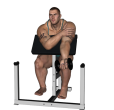 Preacher Curl - Single Dumbbell
Preacher Curl - Single Dumbbell
Benefits: This exercise isolates the biceps so that momentum does not come into play.
Purpose: This exercise strengthens the biceps.
Beginner Biceps Forearms Shoulders Traps Strength Dumbbell Preacher Bench Pull Gym
General Info: The biceps muscle is a straight muscle with 2 heads. The long head crosses both the elbow and shoulder joints and bends the elbow and raises the arm forward at the shoulder. The short head of the biceps crosses the elbow joint and, in conjunction with the brachioradialis, supinates the hand.
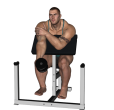 Preacher Curl - Single Dumbbell Hammer
Preacher Curl - Single Dumbbell Hammer
Benefits: This exercise isolates the biceps so that momentum does not come into play.
Purpose: This exercise strengthens the biceps.
Beginner Biceps Forearms Shoulders Traps Strength Dumbbell Preacher Bench Pull Gym
General Info: The biceps muscle is a straight muscle with 2 heads. The long head crosses both the elbow and shoulder joints and bends the elbow and raises the arm forward at the shoulder. The short head of the biceps crosses the elbow joint and, in conjunction with the brachioradialis, supinates the hand.
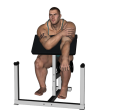 Preacher Curl - Single Dumbbell Zottman
Preacher Curl - Single Dumbbell Zottman
Benefits: This exercise isolates the biceps so that momentum does not come into play. The rotation used in this exercise works the forearms.
Purpose: This exercise strengthens the biceps.
Beginner Biceps Forearms Shoulders Traps Strength Dumbbell Preacher Bench Pull Gym
General Info: The biceps muscle is a straight muscle with 2 heads. The long head crosses both the elbow and shoulder joints and bends the elbow and raises the arm forward at the shoulder. The short head of the biceps crosses the elbow joint and, in conjunction with the brachioradialis, supinates the hand.
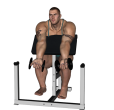 Preacher Curl - Two Arm Dumbbell
Preacher Curl - Two Arm Dumbbell
Benefits: This exercise isolates the biceps so that momentum does not come into play.
Purpose: This exercise strengthens the biceps.
Beginner Biceps Forearms Shoulders Traps Strength Dumbbell Preacher Bench Pull Gym
General Info: The biceps muscle is a straight muscle with 2 heads. The long head crosses both the elbow and shoulder joints and bends the elbow and raises the arm forward at the shoulder. The short head of the biceps crosses the elbow joint and, in conjunction with the brachioradialis, supinates the hand.
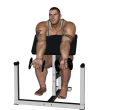 Preacher Curl - Zottman
Preacher Curl - Zottman
Benefits: This exercise isolates the biceps so that momentum does not come into play. the rotation used in this exercise works the forearms.
Purpose: This exercise strengthens the biceps.
Beginner Biceps Forearms Shoulders Traps Strength Dumbbell Preacher Bench Pull Gym
General Info: The biceps muscle is a straight muscle with 2 heads. The long head crosses both the elbow and shoulder joints and bends the elbow and raises the arm forward at the shoulder. The short head of the biceps crosses the elbow joint and, in conjunction with the brachioradialis, supinates the hand.
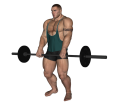 Reverse Curl - Barbell
Reverse Curl - Barbell
Benefits: Reverse curls work the forearms more than regular bicep curls.
Purpose: This exercise increases strength and produces greater functional strength in both the biceps and the forearms.
Beginner Biceps Forearms Strength Barbell Pull Gym
General Info: The biceps is a straight muscle with two heads. The long head of the biceps crosses both the elbow and the shoulder joints. It bends the elbow and raises the arm forward at the shoulder. The short head crosses the elbow joint and, in conjunction with the brachioradialis muscle, supinates the hand. When the hands are placed in a reverse grip, they work the forearm muscles more.
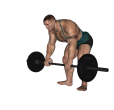 Reverse Curl - Bent Over Barbell
Reverse Curl - Bent Over Barbell
Benefits: Reverse curls work the forearms more than regular bicep curls. The reverse grip makes the exercise more difficult.
Purpose: This exercise increases strength and produces greater functional strength in both the biceps and the forearms.
Beginner Biceps Forearms Strength Barbell Pull Gym
General Info: The biceps is a straight muscle with two heads. The long head of the biceps crosses both the elbow and the shoulder joints. It bends the elbow and raises the arm forward at the shoulder. The short head crosses the elbow joint and, in conjunction with the brachioradialis muscle, supinates the hand. When the hands are placed in a reverse grip, they work the forearm muscles more.
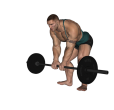 Reverse Curl - Bent Over Barbell Close Grip
Reverse Curl - Bent Over Barbell Close Grip
Benefits: Reverse curls work the forearms more than regular bicep curls. The reverse grip makes the exercise more difficult.
Purpose: This exercise increases strength and produces greater functional strength in both the biceps and the forearms.
Beginner Biceps Forearms Strength Barbell Pull Gym
General Info: The biceps is a straight muscle with two heads. The long head of the biceps crosses both the elbow and the shoulder joints. It bends the elbow and raises the arm forward at the shoulder. The short head crosses the elbow joint and, in conjunction with the brachioradialis muscle, supinates the hand. When the hands are placed in a reverse grip, they work the forearm muscles more.
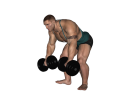 Reverse Curl - Bent Over Dumbbell
Reverse Curl - Bent Over Dumbbell
Benefits: This exercise is similar in effect to the Spider curl and does a good job of placing maximum tension on the biceps in the fully contracted position.
Purpose: This exercise works the biceps muscles but focuses also on the brachioradialis (a muscle that crosses the elbow joint and assists in rotating the forearm).
Beginner Biceps Forearms Shoulders Strength Dumbbell Pull Gym
General Info: The biceps is a straight muscle which has two heads. The long head crosses both the elbow and the shoulder joints. It bends the arm at the elbow and raises the arm forward at the shoulder. The short head crosses the elbow joint and, in conjunction with the brachioradialis, supinates the hand.
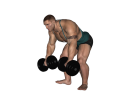 Reverse Curl - Bent Over Dumbbell Alternate
Reverse Curl - Bent Over Dumbbell Alternate
Benefits: This exercise is similar in effect to the Spider curl and does a good job of placing maximum tension on the biceps in the fully contracted position.
Purpose: This exercise works the biceps muscles but focuses also on the brachioradialis (a muscle that crosses the elbow joint and assists in rotating the forearm).
Beginner Biceps Forearms Shoulders Strength Dumbbell Pull Gym
General Info: The biceps is a straight muscle which has two heads. The long head crosses both the elbow and the shoulder joints. It bends the arm at the elbow and raises the arm forward at the shoulder. The short head crosses the elbow joint and, in conjunction with the brachioradialis, supinates the hand.
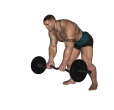 Reverse Curl - Bent Over EZ Bar
Reverse Curl - Bent Over EZ Bar
Benefits: Reverse curls work the forearms more than regular bicep curls.
Purpose: This exercise increases strength and produces greater functional strength in both the biceps and the forearms.
Beginner Biceps Forearms Strength EZ Bar Pull Gym
General Info: The biceps is a straight muscle with two heads. The long head of the biceps crosses both the elbow and the shoulder joints. It bends the elbow and raises the arm forward at the shoulder. The short head crosses the elbow joint and, in conjunction with the brachioradialis muscle, supinates the hand. When the hands are placed in a reverse grip, they work the forearm muscles more.
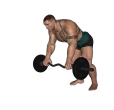 Reverse Curl - Bent Over EZ Bar Wide Grip
Reverse Curl - Bent Over EZ Bar Wide Grip
Benefits: Reverse curls work the forearms more than regular bicep curls.
Purpose: This exercise increases strength and produces greater functional strength in both the biceps and the forearms.
Beginner Biceps Forearms Strength EZ Bar Pull Gym
General Info: The biceps is a straight muscle with two heads. The long head of the biceps crosses both the elbow and the shoulder joints. It bends the elbow and raises the arm forward at the shoulder. The short head crosses the elbow joint and, in conjunction with the brachioradialis muscle, supinates the hand. When the hands are placed in a reverse grip, they work the forearm muscles more.
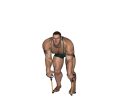 Reverse Curl - Bent Over Resistance Tube
Reverse Curl - Bent Over Resistance Tube
Benefits: This exercise is similar in effect to the Spider curl and does a good job of placing maximum tension on the biceps in the fully contracted position.
Purpose: This exercise works the biceps muscles but focuses also on the brachioradialis (a muscle that crosses the elbow joint and assists in rotating the forearm).
Beginner Biceps Forearms Shoulders Strength Resistance Tube Pull Gym
General Info: The biceps is a straight muscle which has two heads. The long head crosses both the elbow and the shoulder joints. It bends the arm at the elbow and raises the arm forward at the shoulder. The short head crosses the elbow joint and, in conjunction with the brachioradialis, supinates the hand.
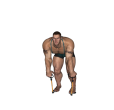 Reverse Curl - Bent Over Resistance Tube Alternate
Reverse Curl - Bent Over Resistance Tube Alternate
Benefits: This exercise is similar in effect to the Spider curl and does a good job of placing maximum tension on the biceps in the fully contracted position.
Purpose: This exercise works the biceps muscles but focuses also on the brachioradialis (a muscle that crosses the elbow joint and assists in rotating the forearm).
Beginner Biceps Forearms Shoulders Strength Resistance Tube Pull Gym
General Info: The biceps is a straight muscle which has two heads. The long head crosses both the elbow and the shoulder joints. It bends the arm at the elbow and raises the arm forward at the shoulder. The short head crosses the elbow joint and, in conjunction with the brachioradialis, supinates the hand.
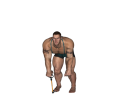 Reverse Curl - Bent Over Resistance Tube Single
Reverse Curl - Bent Over Resistance Tube Single
Benefits: This exercise is similar in effect to the Spider curl and does a good job of placing maximum tension on the biceps in the fully contracted position.
Purpose: This exercise works the biceps muscles but focuses also on the brachioradialis (a muscle that crosses the elbow joint and assists in rotating the forearm).
Beginner Biceps Forearms Shoulders Strength Resistance Tube Pull Gym
General Info: The biceps is a straight muscle which has two heads. The long head crosses both the elbow and the shoulder joints. It bends the arm at the elbow and raises the arm forward at the shoulder. The short head crosses the elbow joint and, in conjunction with the brachioradialis, supinates the hand.
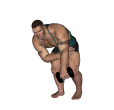 Reverse Curl - Bent Over Single Dumbbell
Reverse Curl - Bent Over Single Dumbbell
Benefits: This exercise is similar in effect to the Spider curl and does a good job of placing maximum tension on the biceps in the fully contracted position.
Purpose: This exercise works the biceps muscles but focuses also on the brachioradialis (a muscle that crosses the elbow joint and assists in rotating the forearm).
Beginner Biceps Forearms Shoulders Strength Dumbbell Pull Gym
General Info: The biceps is a straight muscle which has two heads. The long head crosses both the elbow and the shoulder joints. It bends the arm at the elbow and raises the arm forward at the shoulder. The short head crosses the elbow joint and, in conjunction with the brachioradialis, supinates the hand.
 Reverse Curl - Bent Over Single Water Bottle
Reverse Curl - Bent Over Single Water Bottle
Benefits: This exercise is similar in effect to the Spider curl and does a good job of placing maximum tension on the biceps in the fully contracted position.
Purpose: This exercise works the biceps muscles but focuses also on the brachioradialis (a muscle that crosses the elbow joint and assists in rotating the forearm).
Beginner Biceps Forearms Shoulders Strength Water Bottle Pull Home
General Info: The biceps is a straight muscle which has two heads. The long head crosses both the elbow and the shoulder joints. It bends the arm at the elbow and raises the arm forward at the shoulder. The short head crosses the elbow joint and, in conjunction with the brachioradialis, supinates the hand.
 Reverse Curl - Bent Over Water Bottle
Reverse Curl - Bent Over Water Bottle
Benefits: This exercise is similar in effect to the Spider curl and does a good job of placing maximum tension on the biceps in the fully contracted position.
Purpose: This exercise works the biceps muscles but focuses also on the brachioradialis (a muscle that crosses the elbow joint and assists in rotating the forearm).
Beginner Biceps Forearms Shoulders Strength Water Bottle Pull Home
General Info: The biceps is a straight muscle which has two heads. The long head crosses both the elbow and the shoulder joints. It bends the arm at the elbow and raises the arm forward at the shoulder. The short head crosses the elbow joint and, in conjunction with the brachioradialis, supinates the hand.
 Reverse Curl - Bent Over Water Bottle Alternate
Reverse Curl - Bent Over Water Bottle Alternate
Benefits: This exercise is similar in effect to the Spider curl and does a good job of placing maximum tension on the biceps in the fully contracted position.
Purpose: This exercise works the biceps muscles but focuses also on the brachioradialis (a muscle that crosses the elbow joint and assists in rotating the forearm).
Beginner Biceps Forearms Shoulders Strength Water Bottle Pull Home
General Info: The biceps is a straight muscle which has two heads. The long head crosses both the elbow and the shoulder joints. It bends the arm at the elbow and raises the arm forward at the shoulder. The short head crosses the elbow joint and, in conjunction with the brachioradialis, supinates the hand.
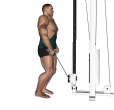 Reverse Curl - Cable
Reverse Curl - Cable
Benefits: Reverse curls work the forearms more than regular bicep curls.
Purpose: This exercise increases strength and produces greater functional strength in both the biceps and the forearms.
Beginner Forearms Biceps Strength Cable Machine Pull Gym
General Info: The biceps is a straight muscle with two heads. The long head of the biceps crosses both the elbow and the shoulder joints. It bends the elbow and raises the arm forward at the shoulder. The short head crosses the elbow joint and, in conjunction with the brachioradialis muscle, supinates the hand. When the hands are placed in a reverse grip, they work the forearm muscles more.
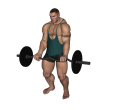 Reverse Curl - EZ Bar
Reverse Curl - EZ Bar
Benefits: This exercise puts the forearms in a stronger position, allowing you to lift heavier weights.
Purpose: This exercise is used to target the biceps muscle to develop size, definition, strength, endurance and power.
Beginner Biceps Forearms Shoulders Strength EZ Bar Pull Gym
General Info: The biceps is a straight muscle with two heads. The long head of the biceps crosses both the elbow and the shoulder joint. It bends the elbow and raises the arm forward at the shoulder. The short head crosses the elbow joint and, in conjunction with the brachioradialis, supinates the hand.
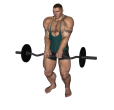 Reverse Curl - EZ Bar Close Grip
Reverse Curl - EZ Bar Close Grip
Benefits: This exercise puts the forearms in a stronger position, allowing you to lift heavier weights.
Purpose: This exercise is used to target the biceps muscle to develop size, definition, strength, endurance and power.
Beginner Biceps Forearms Shoulders Strength EZ Bar Pull Gym
General Info: The biceps is a straight muscle with two heads. The long head of the biceps crosses both the elbow and the shoulder joint. It bends the elbow and raises the arm forward at the shoulder. The short head crosses the elbow joint and, in conjunction with the brachioradialis, supinates the hand.
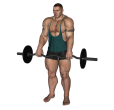 Reverse Curl - EZ Bar Narrow Stance
Reverse Curl - EZ Bar Narrow Stance
Benefits: This exercise puts the forearms in a stronger position, allowing you to lift heavier weights.
Purpose: This exercise is used to target the biceps muscle to develop size, definition, strength, endurance and power.
Beginner Biceps Forearms Shoulders Strength EZ Bar Pull Gym
General Info: The biceps is a straight muscle with two heads. The long head of the biceps crosses both the elbow and the shoulder joint. It bends the elbow and raises the arm forward at the shoulder. The short head crosses the elbow joint and, in conjunction with the brachioradialis, supinates the hand.
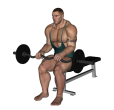 Reverse Curl - EZ Bar Seated
Reverse Curl - EZ Bar Seated
Benefits: This exercise puts the forearms in a stronger position, allowing you to lift heavier weights.
Purpose: This exercise is used to target the biceps muscle to develop size, definition, strength, endurance and power.
Beginner Biceps Forearms Shoulders Strength EZ Bar Flat Bench Pull Gym
General Info: The biceps is a straight muscle with two heads. The long head of the biceps crosses both the elbow and the shoulder joint. It bends the elbow and raises the arm forward at the shoulder. The short head crosses the elbow joint and, in conjunction with the brachioradialis, supinates the hand.
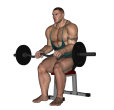 Reverse Curl - EZ Bar Seated Feet Up
Reverse Curl - EZ Bar Seated Feet Up
Benefits: This exercise puts the forearms in a stronger position, allowing you to lift heavier weights.
Purpose: This exercise is used to target the biceps muscle to develop size, definition, strength, endurance and power.
Beginner Biceps Forearms Shoulders Strength EZ Bar Flat Bench Pull Gym
General Info: The biceps is a straight muscle with two heads. The long head of the biceps crosses both the elbow and the shoulder joint. It bends the elbow and raises the arm forward at the shoulder. The short head crosses the elbow joint and, in conjunction with the brachioradialis, supinates the hand.
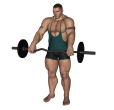 Reverse Curl - EZ Bar Wide Grip Narrow Stance
Reverse Curl - EZ Bar Wide Grip Narrow Stance
Benefits: This exercise puts the forearms in a stronger position, allowing you to lift heavier weights.
Purpose: This exercise is used to target the biceps muscle to develop size, definition, strength, endurance and power.
Beginner Biceps Forearms Shoulders Strength EZ Bar Pull Gym
General Info: The biceps is a straight muscle with two heads. The long head of the biceps crosses both the elbow and the shoulder joint. It bends the elbow and raises the arm forward at the shoulder. The short head crosses the elbow joint and, in conjunction with the brachioradialis, supinates the hand.
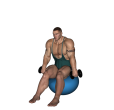 Reverse Curl - Fitness Ball Dumbbell
Reverse Curl - Fitness Ball Dumbbell
Benefits: Reverse curls work the forearms more than regular bicep curls.
Purpose: This exercise increases strength and produces greater functional strength in both the biceps and the forearms.
Beginner Biceps Forearms Strength Dumbbell Fitness Ball Pull Gym
General Info: The biceps is a straight muscle with two heads. The long head of the biceps crosses both the elbow and the shoulder joints. It bends the elbow and raises the arm forward at the shoulder. The short head crosses the elbow joint and, in conjunction with the brachioradialis muscle, supinates the hand. When the hands are placed in a reverse grip, they work the forearm muscles more.
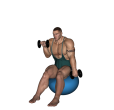 Reverse Curl - Fitness Ball Dumbbell Alternate
Reverse Curl - Fitness Ball Dumbbell Alternate
Benefits: Reverse curls work the forearms more than regular bicep curls.
Purpose: This exercise increases strength and produces greater functional strength in both the biceps and the forearms.
Beginner Biceps Forearms Shoulders Strength Dumbbell Fitness Ball Pull Gym
General Info: The biceps is a straight muscle with two heads. The long head of the biceps crosses both the elbow and the shoulder joint. It bends the elbow and raises the arm forward at the shoulder. The short head crosses the elbow joint and, in conjunction with the brachioradialis, supinates the hand.
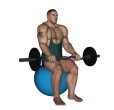 Reverse Curl - Fitness Ball EZ Bar
Reverse Curl - Fitness Ball EZ Bar
Benefits: Reverse curls work the forearms more than regular bicep curls.
Purpose: This exercise increases strength and produces greater functional strength in both the biceps and the forearms.
Beginner Biceps Forearms Strength EZ Bar Fitness Ball Pull Gym
General Info: The biceps is a straight muscle with two heads. The long head of the biceps crosses both the elbow and the shoulder joints. It bends the elbow and raises the arm forward at the shoulder. The short head crosses the elbow joint and, in conjunction with the brachioradialis muscle, supinates the hand. When the hands are placed in a reverse grip, they work the forearm muscles more.
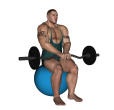 Reverse Curl - Fitness Ball EZ Bar Close Grip
Reverse Curl - Fitness Ball EZ Bar Close Grip
Benefits: Reverse curls work the forearms more than regular bicep curls.
Purpose: This exercise increases strength and produces greater functional strength in both the biceps and the forearms.
Beginner Biceps Forearms Strength EZ Bar Fitness Ball Pull Gym
General Info: The biceps is a straight muscle with two heads. The long head of the biceps crosses both the elbow and the shoulder joints. It bends the elbow and raises the arm forward at the shoulder. The short head crosses the elbow joint and, in conjunction with the brachioradialis muscle, supinates the hand. When the hands are placed in a reverse grip, they work the forearm muscles more.
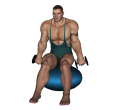 Reverse Curl - Fitness Ball Single Dumbbell
Reverse Curl - Fitness Ball Single Dumbbell
Benefits: Reverse curls work the forearms more than regular bicep curls.
Purpose: This exercise increases strength and produces greater functional strength in both the biceps and the forearms.
Beginner Biceps Forearms Shoulders Strength Dumbbell Fitness Ball Pull Gym
General Info: The biceps is a straight muscle with two heads. The long head of the biceps crosses both the elbow and the shoulder joint. It bends the elbow and raises the arm forward at the shoulder. The short head crosses the elbow joint and, in conjunction with the brachioradialis, supinates the hand.
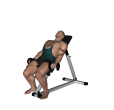 Reverse Curl - Incline Dumbbell
Reverse Curl - Incline Dumbbell
Benefits: Reverse curls work the forearms more than regular bicep curls.
Purpose: This exercise increases strength and produces greater functional strength in both the biceps and the forearms.
Beginner Biceps Forearms Anterior Shoulders Strength Dumbbell Incline Bench Pull Gym
General Info: The biceps muscle is a straight muscle with 2 heads. The long head crosses both the elbow and shoulder joints and bends the elbow and raises the arm forward at the shoulder. The short head of the biceps crosses the elbow joint and, in conjunction with the brachioradialis, supinates the hand.
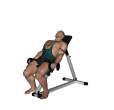 Reverse Curl - Incline Dumbbell Alternate
Reverse Curl - Incline Dumbbell Alternate
Benefits: Reverse curls work the forearms more than regular bicep curls.
Purpose: This exercise increases strength and produces greater functional strength in both the biceps and the forearms.
Beginner Biceps Forearms Anterior Shoulders Strength Dumbbell Incline Bench Pull Gym
General Info: The biceps muscle is a straight muscle with 2 heads. The long head crosses both the elbow and shoulder joints and bends the elbow and raises the arm forward at the shoulder. The short head of the biceps crosses the elbow joint and, in conjunction with the brachioradialis, supinates the hand.
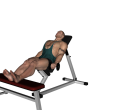 Reverse Curl - Incline Dumbbell Feet Up
Reverse Curl - Incline Dumbbell Feet Up
Benefits: Reverse curls work the forearms more than regular bicep curls.
Purpose: This exercise increases strength and produces greater functional strength in both the biceps and the forearms.
Beginner Biceps Forearms Anterior Shoulders Strength Dumbbell Incline Bench Pull Gym
General Info: The biceps muscle is a straight muscle with 2 heads. The long head crosses both the elbow and shoulder joints and bends the elbow and raises the arm forward at the shoulder. The short head of the biceps crosses the elbow joint and, in conjunction with the brachioradialis, supinates the hand.
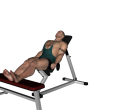 Reverse Curl - Incline Dumbbell Feet Up Alternate
Reverse Curl - Incline Dumbbell Feet Up Alternate
Benefits: Reverse curls work the forearms more than regular bicep curls.
Purpose: This exercise increases strength and produces greater functional strength in both the biceps and the forearms.
Beginner Biceps Forearms Anterior Shoulders Strength Dumbbell Incline Bench Pull Gym
General Info: The biceps muscle is a straight muscle with 2 heads. The long head crosses both the elbow and shoulder joints and bends the elbow and raises the arm forward at the shoulder. The short head of the biceps crosses the elbow joint and, in conjunction with the brachioradialis, supinates the hand.
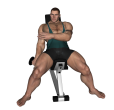 Reverse Curl - Incline Single Dumbbell
Reverse Curl - Incline Single Dumbbell
Benefits: Reverse curls work the forearms more than regular bicep curls.
Purpose: This exercise increases strength and produces greater functional strength in both the biceps and the forearms.
Beginner Biceps Forearms Shoulders Strength Dumbbell Incline Bench Pull Gym
General Info: The biceps is a straight muscle with two heads. The long head of the biceps crosses both the elbow and the shoulder joint. It bends the elbow and raises the arm forward at the shoulder. The short head crosses the elbow joint and, in conjunction with the brachioradialis, supinates the hand.
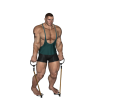 Reverse Curl - Resistance Tube
Reverse Curl - Resistance Tube
Benefits: This exercise places great relative intensity on the biceps muscle and is a basic bicep exercise.
Purpose: This exercise focuses on the biceps but also involves the brachioradialis.
Beginner Biceps Forearms Shoulders Strength Resistance Tube Pull Gym
General Info: The biceps is a straight muscle with two heads. The long head of the biceps crosses both the elbow and the shoulder joints. It bends the elbow and raises the arm forward at the shoulder. The short head crosses the elbow joint and, in conjunction with the brachioradialis muscle, supinates the hand.
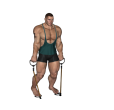 Reverse Curl - Resistance Tube Alternate
Reverse Curl - Resistance Tube Alternate
Benefits: This exercise places great relative intensity on the biceps muscle and is a basic bicep exercise.
Purpose: This exercise focuses on the biceps but also involves the brachioradialis.
Beginner Biceps Forearms Shoulders Strength Resistance Tube Pull Gym
General Info: The biceps is a straight muscle with two heads. The long head of the biceps crosses both the elbow and the shoulder joints. It bends the elbow and raises the arm forward at the shoulder. The short head crosses the elbow joint and, in conjunction with the brachioradialis muscle, supinates the hand.
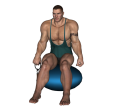 Reverse Curl - Resistance Tube Ball Single
Reverse Curl - Resistance Tube Ball Single
Benefits: This exercise isolates the biceps so that momentum does not come into play.
Purpose: This exercise strengthens the biceps.
Beginner Biceps Forearms Strength Fitness Ball Resistance Tube Pull Gym
General Info: The biceps muscle is a straight muscle with 2 heads. The long head crosses both the elbow and shoulder joints and bends the elbow and raises the arm forward at the shoulder. The short head of the biceps crosses the elbow joint and, in conjunction with the brachioradialis, supinates the hand.
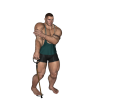 Reverse Curl - Resistance Tube Single
Reverse Curl - Resistance Tube Single
Benefits: This exercise isolates the biceps so that momentum does not come into play.
Purpose: This exercise strengthens the biceps.
Beginner Biceps Forearms Shoulders Strength Resistance Tube Pull Gym
General Info: The biceps is a straight muscle with two heads. The long head of the biceps crosses both the elbow and the shoulder joint. It bends the elbow and raises the arm forward at the shoulder. The short head crosses the elbow joint and, in conjunction with the brachioradialis, supinates the hand.
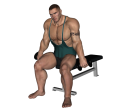 Reverse Curl - Seated Dumbbell
Reverse Curl - Seated Dumbbell
Benefits: This exercise isolates the biceps so that momentum does not come into play.
Purpose: This exercise strengthens the biceps.
Beginner Biceps Forearms Shoulders Traps Strength Dumbbell Flat Bench Pull Gym
General Info: The biceps muscle is a straight muscle with 2 heads. The long head crosses both the elbow and shoulder joints and bends the elbow and raises the arm forward at the shoulder. The short head of the biceps crosses the elbow joint and, in conjunction with the brachioradialis, supinates the hand..
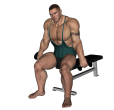 Reverse Curl - Seated Dumbbell Alternate
Reverse Curl - Seated Dumbbell Alternate
Benefits: This exercise isolates the biceps so that momentum does not come into play.
Purpose: This exercise strengthens the biceps.
Beginner Biceps Forearms Shoulders Traps Strength Dumbbell Flat Bench Pull Gym
General Info: The biceps muscle is a straight muscle with 2 heads. The long head crosses both the elbow and shoulder joints and bends the elbow and raises the arm forward at the shoulder. The short head of the biceps crosses the elbow joint and, in conjunction with the brachioradialis, supinates the hand..
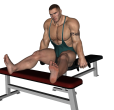 Reverse Curl - Seated Dumbbell Feet Up
Reverse Curl - Seated Dumbbell Feet Up
Benefits: This exercise isolates the biceps so that momentum does not come into play. It also works the forearms.
Purpose: This exercise strengthens the biceps.
Beginner Biceps Forearms Shoulders Traps Strength Dumbbell Flat Bench Pull Gym
General Info: The biceps muscle is a straight muscle with 2 heads. The long head crosses both the elbow and shoulder joints and bends the elbow and raises the arm forward at the shoulder. The short head of the biceps crosses the elbow joint and, in conjunction with the brachioradialis, supinates the hand..
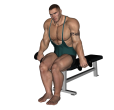 Reverse Curl - Seated Dumbbell Narrow Alternate
Reverse Curl - Seated Dumbbell Narrow Alternate
Benefits: This exercise isolates the biceps so that momentum does not come into play. It also works the forearms.
Purpose: This exercise strengthens the biceps.
Beginner Biceps Forearms Shoulders Traps Strength Dumbbell Flat Bench Pull Gym
General Info: The biceps muscle is a straight muscle with 2 heads. The long head crosses both the elbow and shoulder joints and bends the elbow and raises the arm forward at the shoulder. The short head of the biceps crosses the elbow joint and, in conjunction with the brachioradialis, supinates the hand..
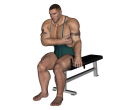 Reverse Curl - Seated Dumbbell Single
Reverse Curl - Seated Dumbbell Single
Benefits: This exercise isolates the biceps so that momentum does not come into play. It also works the forearms.
Purpose: This exercise strengthens the biceps.
Beginner Biceps Forearms Shoulders Traps Strength Dumbbell Flat Bench Pull Gym
General Info: The biceps muscle is a straight muscle with 2 heads. The long head crosses both the elbow and shoulder joints and bends the elbow and raises the arm forward at the shoulder. The short head of the biceps crosses the elbow joint and, in conjunction with the brachioradialis, supinates the hand..
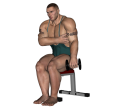 Reverse Curl - Seated Dumbbell Single Narrow
Reverse Curl - Seated Dumbbell Single Narrow
Benefits: This exercise isolates the biceps so that momentum does not come into play. It also works the forearms.
Purpose: This exercise strengthens the biceps.
Beginner Biceps Forearms Shoulders Traps Strength Dumbbell Flat Bench Pull Gym
General Info: The biceps muscle is a straight muscle with 2 heads. The long head crosses both the elbow and shoulder joints and bends the elbow and raises the arm forward at the shoulder. The short head of the biceps crosses the elbow joint and, in conjunction with the brachioradialis, supinates the hand..
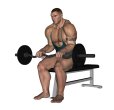 Reverse Curl - Seated EZ Bar
Reverse Curl - Seated EZ Bar
Benefits: This exercise isolates the biceps so that momentum does not come into play. It also works the forearms.
Purpose: This exercise strengthens the biceps.
Beginner Biceps Forearms Shoulders Traps Strength EZ Bar Flat Bench Pull Gym
General Info: The biceps muscle is a straight muscle with 2 heads. The long head crosses both the elbow and shoulder joints and bends the elbow and raises the arm forward at the shoulder. The short head of the biceps crosses the elbow joint and, in conjunction with the brachioradialis, supinates the hand..
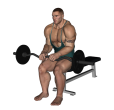 Reverse Curl - Seated EZ Bar Close Grip
Reverse Curl - Seated EZ Bar Close Grip
Benefits: This exercise isolates the biceps so that momentum does not come into play. It also works the forearms.
Purpose: This exercise strengthens the biceps.
Beginner Biceps Forearms Shoulders Traps Strength EZ Bar Flat Bench Pull Gym
General Info: The biceps muscle is a straight muscle with 2 heads. The long head crosses both the elbow and shoulder joints and bends the elbow and raises the arm forward at the shoulder. The short head of the biceps crosses the elbow joint and, in conjunction with the brachioradialis, supinates the hand..
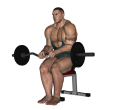 Reverse Curl - Seated EZ Bar Close Narrow
Reverse Curl - Seated EZ Bar Close Narrow
Benefits: This exercise isolates the biceps so that momentum does not come into play. It also works the forearms.
Purpose: This exercise strengthens the biceps.
Beginner Biceps Forearms Shoulders Traps Strength EZ Bar Flat Bench Pull Gym
General Info: The biceps muscle is a straight muscle with 2 heads. The long head crosses both the elbow and shoulder joints and bends the elbow and raises the arm forward at the shoulder. The short head of the biceps crosses the elbow joint and, in conjunction with the brachioradialis, supinates the hand..
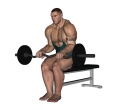 Reverse Curl - Seated EZ Bar Narrow
Reverse Curl - Seated EZ Bar Narrow
Benefits: This exercise isolates the biceps so that momentum does not come into play. It also works the forearms.
Purpose: This exercise strengthens the biceps.
Beginner Biceps Forearms Shoulders Traps Strength EZ Bar Flat Bench Pull Gym
General Info: The biceps muscle is a straight muscle with 2 heads. The long head crosses both the elbow and shoulder joints and bends the elbow and raises the arm forward at the shoulder. The short head of the biceps crosses the elbow joint and, in conjunction with the brachioradialis, supinates the hand..
 Reverse Curl - Seated Water Bottle
Reverse Curl - Seated Water Bottle
Benefits: This exercise isolates the biceps so that momentum does not come into play.
Purpose: This exercise strengthens the biceps.
Beginner Biceps Forearms Shoulders Traps Strength Water Bottle Chair Pull Home
General Info: The biceps muscle is a straight muscle with 2 heads. The long head crosses both the elbow and shoulder joints and bends the elbow and raises the arm forward at the shoulder. The short head of the biceps crosses the elbow joint and, in conjunction with the brachioradialis, supinates the hand..
 Reverse Curl - Seated Water Bottle Alternate
Reverse Curl - Seated Water Bottle Alternate
Benefits: This exercise isolates the biceps so that momentum does not come into play.
Purpose: This exercise strengthens the biceps.
Beginner Biceps Forearms Shoulders Traps Strength Water Bottle Chair Pull Home
General Info: The biceps muscle is a straight muscle with 2 heads. The long head crosses both the elbow and shoulder joints and bends the elbow and raises the arm forward at the shoulder. The short head of the biceps crosses the elbow joint and, in conjunction with the brachioradialis, supinates the hand..
 Reverse Curl - Seated Water Bottle Feet Up
Reverse Curl - Seated Water Bottle Feet Up
Benefits: This exercise isolates the biceps so that momentum does not come into play.
Purpose: This exercise strengthens the biceps.
Beginner Biceps Forearms Shoulders Traps Strength Water Bottle Chair Pull Home
General Info: The biceps muscle is a straight muscle with 2 heads. The long head crosses both the elbow and shoulder joints and bends the elbow and raises the arm forward at the shoulder. The short head of the biceps crosses the elbow joint and, in conjunction with the brachioradialis, supinates the hand..
 Reverse Curl - Seated Water Bottle Narrow Alternate
Reverse Curl - Seated Water Bottle Narrow Alternate
Benefits: This exercise isolates the biceps so that momentum does not come into play.
Purpose: This exercise strengthens the biceps.
Beginner Biceps Forearms Shoulders Traps Strength Water Bottle Chair Pull Home
General Info: The biceps muscle is a straight muscle with 2 heads. The long head crosses both the elbow and shoulder joints and bends the elbow and raises the arm forward at the shoulder. The short head of the biceps crosses the elbow joint and, in conjunction with the brachioradialis, supinates the hand..
 Reverse Curl - Seated Water Bottle Single
Reverse Curl - Seated Water Bottle Single
Benefits: This exercise isolates the biceps so that momentum does not come into play.
Purpose: This exercise strengthens the biceps.
Beginner Biceps Forearms Shoulders Traps Strength Water Bottle Chair Pull Home
General Info: The biceps muscle is a straight muscle with 2 heads. The long head crosses both the elbow and shoulder joints and bends the elbow and raises the arm forward at the shoulder. The short head of the biceps crosses the elbow joint and, in conjunction with the brachioradialis, supinates the hand..
 Reverse Curl - Seated Water Bottle Single Narrow
Reverse Curl - Seated Water Bottle Single Narrow
Benefits: This exercise isolates the biceps so that momentum does not come into play.
Purpose: This exercise strengthens the biceps.
Beginner Biceps Forearms Shoulders Traps Strength Water Bottle Chair Pull Home
General Info: The biceps muscle is a straight muscle with 2 heads. The long head crosses both the elbow and shoulder joints and bends the elbow and raises the arm forward at the shoulder. The short head of the biceps crosses the elbow joint and, in conjunction with the brachioradialis, supinates the hand..
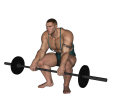 Reverse Curl - Squat Barbell
Reverse Curl - Squat Barbell
Benefits: Reverse curls work the forearms more than regular bicep curls.
Purpose: This exercise increases strength and produces greater functional strength in both the biceps and the forearms.
Beginner Biceps Forearms Strength Barbell Pull Gym
General Info: The biceps is a straight muscle with two heads. The long head of the biceps crosses both the elbow and the shoulder joints. It bends the elbow and raises the arm forward at the shoulder. The short head crosses the elbow joint and, in conjunction with the brachioradialis muscle, supinates the hand. When the hands are placed in a reverse grip, they work the forearm muscles more.
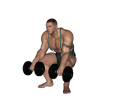 Reverse Curl - Squat Dumbbell
Reverse Curl - Squat Dumbbell
Benefits: Reverse curls work the forearms more than regular bicep curls.
Purpose: This exercise increases strength and produces greater functional strength in both the biceps and the forearms.
Beginner Biceps Forearms Strength Dumbbell Pull Gym
General Info: The biceps is a straight muscle with two heads. The long head of the biceps crosses both the elbow and the shoulder joints. It bends the elbow and raises the arm forward at the shoulder. The short head crosses the elbow joint and, in conjunction with the brachioradialis muscle, supinates the hand. When the hands are placed in a reverse grip, they work the forearm muscles more.
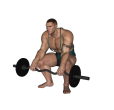 Reverse Curl - Squat EZ Bar
Reverse Curl - Squat EZ Bar
Benefits: Reverse curls work the forearms more than regular bicep curls.
Purpose: This exercise increases strength and produces greater functional strength in both the biceps and the forearms.
Beginner Biceps Forearms Strength EZ Bar Pull Gym
General Info: The biceps is a straight muscle with two heads. The long head of the biceps crosses both the elbow and the shoulder joints. It bends the elbow and raises the arm forward at the shoulder. The short head crosses the elbow joint and, in conjunction with the brachioradialis muscle, supinates the hand. When the hands are placed in a reverse grip, they work the forearm muscles more.
 Reverse Curl - Squat Water Bottle
Reverse Curl - Squat Water Bottle
Benefits: Reverse curls work the forearms more than regular bicep curls.
Purpose: This exercise increases strength and produces greater functional strength in both the biceps and the forearms.
Beginner Biceps Forearms Strength Water Bottle Pull Home
General Info: The biceps is a straight muscle with two heads. The long head of the biceps crosses both the elbow and the shoulder joints. It bends the elbow and raises the arm forward at the shoulder. The short head crosses the elbow joint and, in conjunction with the brachioradialis muscle, supinates the hand. When the hands are placed in a reverse grip, they work the forearm muscles more.
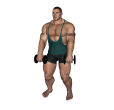 Reverse Curl - Standing Dumbbell
Reverse Curl - Standing Dumbbell
Benefits: Reverse curls work the forearms in addition to the biceps.
Purpose: This exercise increases strength and produces greater functional strength in both the biceps and the forearms.
Beginner Forearms Biceps Strength Dumbbell Pull Gym
General Info: The biceps is a straight muscle with two heads. The long head of the biceps crosses both the elbow and the shoulder joint. It bends the elbow and raises the arm forward at the shoulder. The short head crosses the elbow joint and, in conjunction with the brachioradialis, supinates the hand.
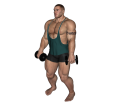 Reverse Curl - Standing Dumbbell Alternate
Reverse Curl - Standing Dumbbell Alternate
Benefits: This exercise works both heads of the biceps with a heavier weight than can typically be done with dumbbells.
Purpose: This exercise is used to target the biceps muscle to develop size, definition, strength, endurance and power.
Beginner Biceps Forearms Shoulders Strength Dumbbell Pull Gym
General Info: The biceps is a straight muscle with two heads. The long head of the biceps crosses both the elbow and the shoulder joint. It bends the elbow and raises the arm forward at the shoulder. The short head crosses the elbow joint and, in conjunction with the brachioradialis, supinates the hand.
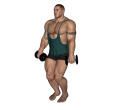 Reverse Curl - Standing Dumbbell Narrow Stance
Reverse Curl - Standing Dumbbell Narrow Stance
Benefits: This exercise works both heads of the biceps. It also works the forearms.
Purpose: This exercise is used to target the biceps muscle to develop size, definition, strength, endurance and power.
Beginner Biceps Forearms Shoulders Strength Dumbbell Pull Gym
General Info: The biceps is a straight muscle with two heads. The long head of the biceps crosses both the elbow and the shoulder joint. It bends the elbow and raises the arm forward at the shoulder. The short head crosses the elbow joint and, in conjunction with the brachioradialis, supinates the hand.
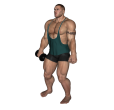 Reverse Curl - Standing Dumbbell Single
Reverse Curl - Standing Dumbbell Single
Benefits: This exercise isolates the biceps so that momentum does not come into play. It also works the forearms.
Purpose: This exercise strengthens the biceps.
Beginner Biceps Forearms Shoulders Traps Strength Dumbbell Pull Gym
General Info: The biceps muscle is a straight muscle with 2 heads. The long head crosses both the elbow and shoulder joints and bends the elbow and raises the arm forward at the shoulder. The short head of the biceps crosses the elbow joint and, in conjunction with the brachioradialis, supinates the hand..
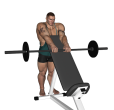 Reverse Curl - Standing Incline Barbell
Reverse Curl - Standing Incline Barbell
Benefits: This exercise works both heads of the biceps with a heavier weight than can typically be done with dumbbells. It is very similar to a preacher curl. It also works the forearms.
Purpose: This exercise is used to target the biceps muscle to develop size, definition, strength, endurance and power.
Beginner Biceps Forearms Shoulders Strength Barbell Incline Bench Pull Gym
General Info: The biceps is a straight muscle with two heads. The long head of the biceps crosses both the elbow and the shoulder joint. It bends the elbow and raises the arm forward at the shoulder. The short head crosses the elbow joint and, in conjunction with the brachioradialis, supinates the hand.
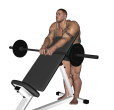 Reverse Curl - Standing Incline Barbell Close
Reverse Curl - Standing Incline Barbell Close
Benefits: This exercise works both heads of the biceps with a heavier weight than can typically be done with dumbbells. It is very similar to a preacher curl. It also works the forearms.
Purpose: This exercise is used to target the biceps muscle to develop size, definition, strength, endurance and power.
Beginner Biceps Forearms Shoulders Strength Barbell Incline Bench Pull Gym
General Info: The biceps is a straight muscle with two heads. The long head of the biceps crosses both the elbow and the shoulder joint. It bends the elbow and raises the arm forward at the shoulder. The short head crosses the elbow joint and, in conjunction with the brachioradialis, supinates the hand.
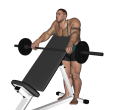 Reverse Curl - Standing Incline Barbell Wide Grip
Reverse Curl - Standing Incline Barbell Wide Grip
Benefits: This exercise works both heads of the biceps with a heavier weight than can typically be done with dumbbells. It is very similar to a preacher curl. It also works the forearms.
Purpose: This exercise is used to target the biceps muscle to develop size, definition, strength, endurance and power.
Beginner Biceps Forearms Shoulders Strength Barbell Incline Bench Pull Gym
General Info: The biceps is a straight muscle with two heads. The long head of the biceps crosses both the elbow and the shoulder joint. It bends the elbow and raises the arm forward at the shoulder. The short head crosses the elbow joint and, in conjunction with the brachioradialis, supinates the hand.
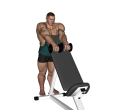 Reverse Curl - Standing Incline Dumbbell
Reverse Curl - Standing Incline Dumbbell
Benefits: This exercise works both heads of the biceps. It is very similar to a preacher curl. It also works the forearms.
Purpose: This exercise is used to target the biceps muscle to develop size, definition, strength, endurance and power.
Beginner Biceps Forearms Shoulders Strength Dumbbell Incline Bench Pull Gym
General Info: The biceps is a straight muscle with two heads. The long head of the biceps crosses both the elbow and the shoulder joint. It bends the elbow and raises the arm forward at the shoulder. The short head crosses the elbow joint and, in conjunction with the brachioradialis, supinates the hand.
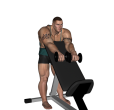 Reverse Curl - Standing Incline Dumbbell Alternate
Reverse Curl - Standing Incline Dumbbell Alternate
Benefits: This exercise works both heads of the biceps. It is very similar to a preacher curl. It also works the forearms.
Purpose: This exercise is used to target the biceps muscle to develop size, definition, strength, endurance and power.
Beginner Biceps Forearms Shoulders Strength Dumbbell Incline Bench Pull Gym
General Info: The biceps is a straight muscle with two heads. The long head of the biceps crosses both the elbow and the shoulder joint. It bends the elbow and raises the arm forward at the shoulder. The short head crosses the elbow joint and, in conjunction with the brachioradialis, supinates the hand.
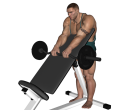 Reverse Curl - Standing Incline EZ Bar
Reverse Curl - Standing Incline EZ Bar
Benefits: This exercise works both heads of the biceps with a heavier weight than can typically be done with dumbbells.
Purpose: This exercise is used to target the biceps muscle to develop size, definition, strength, endurance and power.
Beginner Biceps Forearms Shoulders Strength EZ Bar Incline Bench Pull Gym
General Info: The biceps is a straight muscle with two heads. The long head of the biceps crosses both the elbow and the shoulder joint. It bends the elbow and raises the arm forward at the shoulder. The short head crosses the elbow joint and, in conjunction with the brachioradialis, supinates the hand.
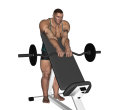 Reverse Curl - Standing Incline EZ Bar Close Grip
Reverse Curl - Standing Incline EZ Bar Close Grip
Benefits: This exercise works both heads of the biceps with a heavier weight than can typically be done with dumbbells. It is very similar to a preacher curl. It also works the forearms.
Purpose: This exercise is used to target the biceps muscle to develop size, definition, strength, endurance and power.
Beginner Biceps Forearms Shoulders Strength EZ Bar Incline Bench Pull Gym
General Info: The biceps is a straight muscle with two heads. The long head of the biceps crosses both the elbow and the shoulder joint. It bends the elbow and raises the arm forward at the shoulder. The short head crosses the elbow joint and, in conjunction with the brachioradialis, supinates the hand.
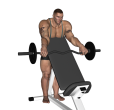 Reverse Curl - Standing Incline EZ Bar Wide Grip
Reverse Curl - Standing Incline EZ Bar Wide Grip
Benefits: This exercise works both heads of the biceps with a heavier weight than can typically be done with dumbbells. It is very similar to a preacher curl. It also works the forearms.
Purpose: This exercise is used to target the biceps muscle to develop size, definition, strength, endurance and power.
Beginner Biceps Forearms Shoulders Strength EZ Bar Incline Bench Pull Gym
General Info: The biceps is a straight muscle with two heads. The long head of the biceps crosses both the elbow and the shoulder joint. It bends the elbow and raises the arm forward at the shoulder. The short head crosses the elbow joint and, in conjunction with the brachioradialis, supinates the hand.
 Reverse Curl - Standing Water Bottle
Reverse Curl - Standing Water Bottle
Benefits: Reverse curls work the forearms in addition to the biceps.
Purpose: This exercise increases strength and produces greater functional strength in both the biceps and the forearms.
Beginner Forearms Biceps Strength Water Bottle Pull Home
General Info: The biceps is a straight muscle with two heads. The long head of the biceps crosses both the elbow and the shoulder joint. It bends the elbow and raises the arm forward at the shoulder. The short head crosses the elbow joint and, in conjunction with the brachioradialis, supinates the hand.
 Reverse Curl - Standing Water Bottle Alternate
Reverse Curl - Standing Water Bottle Alternate
Benefits: This exercise isolates the biceps so that momentum does not come into play.
Purpose: This exercise strengthens the biceps.
Beginner Biceps Forearms Shoulders Traps Strength Water Bottle Pull Home
General Info: The biceps muscle is a straight muscle with 2 heads. The long head crosses both the elbow and shoulder joints and bends the elbow and raises the arm forward at the shoulder. The short head of the biceps crosses the elbow joint and, in conjunction with the brachioradialis, supinates the hand..
 Reverse Curl - Standing Water Bottle Narrow
Reverse Curl - Standing Water Bottle Narrow
Benefits: Reverse curls work the forearms in addition to the biceps.
Purpose: This exercise increases strength and produces greater functional strength in both the biceps and the forearms.
Beginner Forearms Biceps Strength Water Bottle Pull Home
General Info: The biceps is a straight muscle with two heads. The long head of the biceps crosses both the elbow and the shoulder joint. It bends the elbow and raises the arm forward at the shoulder. The short head crosses the elbow joint and, in conjunction with the brachioradialis, supinates the hand.
 Reverse Curl - Standing Water Bottle Single
Reverse Curl - Standing Water Bottle Single
Benefits: This exercise isolates the biceps so that momentum does not come into play.
Purpose: This exercise strengthens the biceps.
Beginner Biceps Forearms Shoulders Traps Strength Water Bottle Chair Pull Home
General Info: The biceps muscle is a straight muscle with 2 heads. The long head crosses both the elbow and shoulder joints and bends the elbow and raises the arm forward at the shoulder. The short head of the biceps crosses the elbow joint and, in conjunction with the brachioradialis, supinates the hand..
 Rickshaw Carry - Basic
Rickshaw Carry - Basic
Benefits: This exercise involves many other muscles.
Purpose: This exercise builds overall strength in the lower body.
Lower Back Glutes Hamstrings Calves Quads Forearms Lats Middle Back Traps Strength Rickshaw Apparatus Pull Compound Gym
General Info: The muscles of the lower back straighten the spine. They work together with the abdominals to keep the spine upright. The Barbell Deadlift is considered to be the king of exercises. No other exercise will work your body so much.
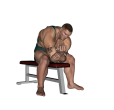 Rotational Flexibility - Wrist Tendons 1
Rotational Flexibility - Wrist Tendons 1
Benefits: This exercise focuses on wrist flexibility.
Purpose: This exercise rotates the wrist to increase flexibility.
Beginner Forearms Strength Body Only Pull Gym
General Info: A complete forearm program must achieve balanced development for all major forearm muscles. The forearm is involved in six different forearm movements. They include wrist flexion, wrist extension, wrist abduction, wrist adduction, forearm pronation, and forearm supination. There are additional muscles found in the forearm that are involved in movements like elbow flexion (brachioradialis), finger flexion, and finger extension.
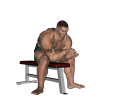 Rotational Flexibility - Wrist Tendons 2
Rotational Flexibility - Wrist Tendons 2
Benefits: This exercise focuses on wrist flexibility.
Purpose: This exercise rotates the wrist to increase flexibility.
Beginner Forearms Strength Body Only Pull Gym
General Info: A complete forearm program must achieve balanced development for all major forearm muscles. The forearm is involved in six different forearm movements. They include wrist flexion, wrist extension, wrist abduction, wrist adduction, forearm pronation, and forearm supination. There are additional muscles found in the forearm that are involved in movements like elbow flexion (brachioradialis), finger flexion, and finger extension.
 Sandbag Load - Basic
Sandbag Load - Basic
Benefits: This exercise involves many other muscles.
Purpose: This exercise builds overall strength in the lower body.
Lower Back Glutes Hamstrings Calves Quads Forearms Lats Middle Back Traps Strength Sandbag Pull Compound Gym
General Info: The muscles of the lower back straighten the spine. They work together with the abdominals to keep the spine upright. The Barbell Deadlift is considered to be the king of exercises. No other exercise will work your body so much.
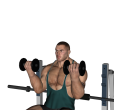 Shoulder Press - Arnold Dumbbell
Shoulder Press - Arnold Dumbbell
Benefits: The press is a highly effective compound upper-body exercise.
Purpose: Shoulder presses are good exercises for building up and strengthening the shoulder region. The Arnold Shoulder Press is an excellent intermediate alternative to the standard shoulder press.
Intermediate Shoulders Forearms Triceps Strength Dumbbell Flat Bench Push Compound Gym
General Info: The deltoid is a fan-shaped muscle. The Anterior (front) deltoid raises the arm toward the front of the body and rotates the arm inward. The Lateral (side) deltoid raises the arm to the side. The Posterior (rear) deltoid raises the arm toward the rear and rotates the arm outward. This exercise was created by bodybuilder Arnold Schwarzenegger and hits both the medial and front heads of deltoids.
 Shoulder Press - Arnold Water Bottle
Shoulder Press - Arnold Water Bottle
Benefits: The press is a highly effective compound upper-body exercise.
Purpose: Shoulder presses are good exercises for building up and strengthening the shoulder region. The Arnold Shoulder Press is an excellent intermediate alternative to the standard shoulder press.
Intermediate Shoulders Forearms Triceps Strength Water Bottle Chair Push Compound Home
General Info: The deltoids is a fan-shaped muscle. The Anterior (front) deltoid raises the arm toward the front of the body and rotates the arm inward. The Lateral (side) deltoid raises the arm to the side. The Posterior (rear) deltoid raises the arm toward the rear and rotates the arm outward. This exercise was created by bodybuilder Arnold Schwarzenegger and hits both the medial and front heads of deltoids.
 Snatch - Deadlift
Snatch - Deadlift
Benefits: This exercise involves many other muscles.
Purpose: This exercise builds overall strength in the lower body.
Intermediate Lower Back Glutes Hamstrings Calves Quads Forearms Lats Middle Back Traps Strength Barbell Pull Compound Gym
General Info: The muscles of the lower back straighten the spine. They work together with the abdominals to keep the spine upright. The Barbell Deadlift is considered to be the king of exercises. No other exercise will work your body so much.
 Snatch - Power
Snatch - Power
Benefits: This exercise involves many other muscles.
Purpose: This exercise builds overall strength in the lower body.
Intermediate Lower Back Glutes Hamstrings Calves Quads Forearms Lats Middle Back Traps Strength Barbell Pull Compound Gym
General Info: The muscles of the lower back straighten the spine. They work together with the abdominals to keep the spine upright. The Barbell Deadlift is considered to be the king of exercises. No other exercise will work your body so much.
 Snatch - Power From Blocks
Snatch - Power From Blocks
Benefits: This exercise involves many other muscles.
Purpose: This exercise builds overall strength in the lower body.
Intermediate Lower Back Glutes Hamstrings Calves Quads Forearms Lats Middle Back Traps Strength Barbell Pull Compound Gym
General Info: The muscles of the lower back straighten the spine. They work together with the abdominals to keep the spine upright. The Barbell Deadlift is considered to be the king of exercises. No other exercise will work your body so much.
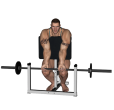 Spider Curl - Barbell Close Grip
Spider Curl - Barbell Close Grip
Benefits: Spider curls do a perfect job of placing maximum tension on the biceps in the fully contracted position. As an alternate, spider curls can be done with a barbell instead of dumbbells.
Purpose: This exercise works the biceps muscles but focuses also on the brachioradialis (a muscle that crosses the elbow joint and assists in rotating the forearm).
Beginner Biceps Forearms Shoulders Traps Strength Barbell Preacher Bench Pull Gym
General Info: The biceps muscle is a straight muscle with 2 heads. The long head crosses both the elbow and shoulder joints and bends the elbow and raises the arm forward at the shoulder. The short head of the biceps crosses the elbow joint and, in conjunction with the brachioradialis, supinates the hand.
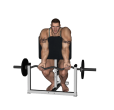 Spider Curl - Basic
Spider Curl - Basic
Benefits: Spider curls do a perfect job of placing maximum tension on the biceps in the fully contracted position. As an alternate, spider curls can be done with a barbell instead of dumbbells.
Purpose: This exercise works the biceps muscles but focuses also on the brachioradialis (a muscle that crosses the elbow joint and assists in rotating the forearm.
Beginner Biceps Forearms Shoulders Traps Strength EZ Bar Preacher Bench Pull Gym
General Info: The biceps muscle is a straight muscle with 2 heads. The long head crosses both the elbow and shoulder joints and bends the elbow and raises the arm forward at the shoulder. The short head of the biceps crosses the elbow joint and, in conjunction with the brachioradialis, supinates the hand.
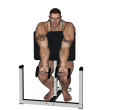 Spider Curl - Dumbbell
Spider Curl - Dumbbell
Benefits: Spider curls do a perfect job of placing maximum tension on the biceps in the fully contracted position. As an alternate, spider curls can be done with a barbell instead of dumbbells.
Purpose: This exercise works the biceps muscles but focuses also on the brachioradialis (a muscle that crosses the elbow joint and assists in rotating the forearm.
Beginner Biceps Forearms Shoulders Traps Strength Dumbbell Preacher Bench Pull Gym
General Info: The biceps muscle is a straight muscle with 2 heads. The long head crosses both the elbow and shoulder joints and bends the elbow and raises the arm forward at the shoulder. The short head of the biceps crosses the elbow joint and, in conjunction with the brachioradialis, supinates the hand.
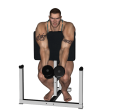 Spider Curl - Dumbbell Hammer
Spider Curl - Dumbbell Hammer
Benefits: Spider curls do a perfect job of placing maximum tension on the biceps in the fully contracted position. Using a hammer grip places the hands in a very strong position.
Purpose: This exercise works the biceps muscles but focuses also on the brachioradialis (a muscle that crosses the elbow joint and assists in rotating the forearm.
Beginner Biceps Forearms Shoulders Traps Strength Dumbbell Preacher Bench Pull Gym
General Info: The biceps muscle is a straight muscle with 2 heads. The long head crosses both the elbow and shoulder joints and bends the elbow and raises the arm forward at the shoulder. The short head of the biceps crosses the elbow joint and, in conjunction with the brachioradialis, supinates the hand.
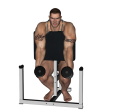 Spider Curl - Dumbbell Hammer Alternate
Spider Curl - Dumbbell Hammer Alternate
Benefits: This exercise isolates the biceps so that momentum does not come into play.
Purpose: This exercise strengthens the biceps.
Beginner Biceps Forearms Shoulders Traps Strength Dumbbell Preacher Bench Pull Gym
General Info: The biceps muscle is a straight muscle with 2 heads. The long head crosses both the elbow and shoulder joints and bends the elbow and raises the arm forward at the shoulder. The short head of the biceps crosses the elbow joint and, in conjunction with the brachioradialis, supinates the hand.
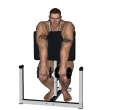 Spider Curl - Dumbbell Reverse
Spider Curl - Dumbbell Reverse
Benefits: Spider curls do a perfect job of placing maximum tension on the biceps in the fully contracted position. The reverse grip also makes the exercise more difficult.
Purpose: This exercise works the biceps muscles but focuses also on the brachioradialis (a muscle that crosses the elbow joint and assists in rotating the forearm.
Beginner Biceps Forearms Shoulders Traps Strength Dumbbell Preacher Bench Pull Gym
General Info: The biceps muscle is a straight muscle with 2 heads. The long head crosses both the elbow and shoulder joints and bends the elbow and raises the arm forward at the shoulder. The short head of the biceps crosses the elbow joint and, in conjunction with the brachioradialis, supinates the hand.
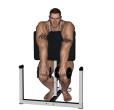 Spider Curl - Dumbbell Zottman
Spider Curl - Dumbbell Zottman
Benefits: Spider curls do a perfect job of placing maximum tension on the biceps in the fully contracted position. Rotating during this exercise also involves the forearms.
Purpose: This exercise works the biceps muscles but focuses also on the brachioradialis (a muscle that crosses the elbow joint and assists in rotating the forearm.
Beginner Biceps Forearms Shoulders Traps Strength Dumbbell Preacher Bench Pull Gym
General Info: The biceps muscle is a straight muscle with 2 heads. The long head crosses both the elbow and shoulder joints and bends the elbow and raises the arm forward at the shoulder. The short head of the biceps crosses the elbow joint and, in conjunction with the brachioradialis, supinates the hand.
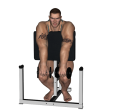 Spider Curl - Dumbbell Zottman Alternate
Spider Curl - Dumbbell Zottman Alternate
Benefits: Spider curls do a perfect job of placing maximum tension on the biceps in the fully contracted position. Rotating during this exercise also involves the forearms.
Purpose: This exercise works the biceps muscles but focuses also on the brachioradialis (a muscle that crosses the elbow joint and assists in rotating the forearm.
Beginner Biceps Forearms Shoulders Traps Strength Dumbbell Preacher Bench Pull Gym
General Info: The biceps muscle is a straight muscle with 2 heads. The long head crosses both the elbow and shoulder joints and bends the elbow and raises the arm forward at the shoulder. The short head of the biceps crosses the elbow joint and, in conjunction with the brachioradialis, supinates the hand.
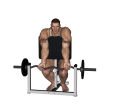 Spider Curl - EZ Bar
Spider Curl - EZ Bar
Benefits: Spider curls do a perfect job of placing maximum tension on the biceps in the fully contracted position.
Purpose: This exercise works the biceps muscles but focuses also on the brachioradialis (a muscle that crosses the elbow joint and assists in rotating the forearm.
Beginner Biceps Forearms Shoulders Traps Strength EZ Bar Preacher Bench Pull Gym
General Info: The biceps muscle is a straight muscle with 2 heads. The long head crosses both the elbow and shoulder joints and bends the elbow and raises the arm forward at the shoulder. The short head of the biceps crosses the elbow joint and, in conjunction with the brachioradialis, supinates the hand.
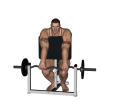 Spider Curl - EZ Bar Reverse
Spider Curl - EZ Bar Reverse
Benefits: Spider curls do a perfect job of placing maximum tension on the biceps in the fully contracted position. The reverse grip makes the exercise more difficult.
Purpose: This exercise works the biceps muscles but focuses also on the brachioradialis (a muscle that crosses the elbow joint and assists in rotating the forearm.
Beginner Biceps Forearms Shoulders Traps Strength EZ Bar Preacher Bench Pull Gym
General Info: The biceps muscle is a straight muscle with 2 heads. The long head crosses both the elbow and shoulder joints and bends the elbow and raises the arm forward at the shoulder. The short head of the biceps crosses the elbow joint and, in conjunction with the brachioradialis, supinates the hand.
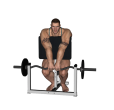 Spider Curl - EZ Bar Reverse Close Grip
Spider Curl - EZ Bar Reverse Close Grip
Benefits: Spider curls do a perfect job of placing maximum tension on the biceps in the fully contracted position. The reverse grip makes the exercise more difficult.
Purpose: This exercise works the biceps muscles but focuses also on the brachioradialis (a muscle that crosses the elbow joint and assists in rotating the forearm.
Beginner Biceps Forearms Shoulders Traps Strength EZ Bar Preacher Bench Pull Gym
General Info: The biceps muscle is a straight muscle with 2 heads. The long head crosses both the elbow and shoulder joints and bends the elbow and raises the arm forward at the shoulder. The short head of the biceps crosses the elbow joint and, in conjunction with the brachioradialis, supinates the hand.
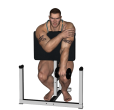 Spider Curl - Reverse Single Dumbbell
Spider Curl - Reverse Single Dumbbell
Benefits: Spider curls do a perfect job of placing maximum tension on the biceps in the fully contracted position. The reverse grip makes the exercise more difficult.
Purpose: This exercise works the biceps muscles but focuses also on the brachioradialis (a muscle that crosses the elbow joint and assists in rotating the forearm.
Beginner Biceps Forearms Shoulders Traps Strength Dumbbell Preacher Bench Pull Gym
General Info: The biceps muscle is a straight muscle with 2 heads. The long head crosses both the elbow and shoulder joints and bends the elbow and raises the arm forward at the shoulder. The short head of the biceps crosses the elbow joint and, in conjunction with the brachioradialis, supinates the hand.
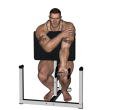 Spider Curl - Single Dumbbell
Spider Curl - Single Dumbbell
Benefits: Spider curls do a perfect job of placing maximum tension on the biceps in the fully contracted position.
Purpose: This exercise works the biceps muscles but focuses also on the brachioradialis (a muscle that crosses the elbow joint and assists in rotating the forearm.
Beginner Biceps Forearms Shoulders Traps Strength Dumbbell Preacher Bench Pull Gym
General Info: The biceps muscle is a straight muscle with 2 heads. The long head crosses both the elbow and shoulder joints and bends the elbow and raises the arm forward at the shoulder. The short head of the biceps crosses the elbow joint and, in conjunction with the brachioradialis, supinates the hand.
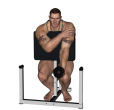 Spider Curl - Single Dumbbell Hammer
Spider Curl - Single Dumbbell Hammer
Benefits: Spider curls do a perfect job of placing maximum tension on the biceps in the fully contracted position.
Purpose: This exercise works the biceps muscles but focuses also on the brachioradialis (a muscle that crosses the elbow joint and assists in rotating the forearm.
Beginner Biceps Forearms Shoulders Traps Strength Dumbbell Preacher Bench Pull Gym
General Info: The biceps muscle is a straight muscle with 2 heads. The long head crosses both the elbow and shoulder joints and bends the elbow and raises the arm forward at the shoulder. The short head of the biceps crosses the elbow joint and, in conjunction with the brachioradialis, supinates the hand.
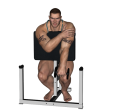 Spider Curl - Single Dumbbell Zottman
Spider Curl - Single Dumbbell Zottman
Benefits: Spider curls do a perfect job of placing maximum tension on the biceps in the fully contracted position.
Purpose: This exercise works the biceps muscles but focuses also on the brachioradialis (a muscle that crosses the elbow joint and assists in rotating the forearm.
Beginner Biceps Forearms Shoulders Traps Strength Dumbbell Preacher Bench Pull Gym
General Info: The biceps muscle is a straight muscle with 2 heads. The long head crosses both the elbow and shoulder joints and bends the elbow and raises the arm forward at the shoulder. The short head of the biceps crosses the elbow joint and, in conjunction with the brachioradialis, supinates the hand.
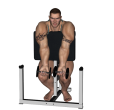 Spider Curl - Zottman Reverse
Spider Curl - Zottman Reverse
Benefits: Spider curls do a perfect job of placing maximum tension on the biceps in the fully contracted position. The reverse grip makes the exercise more difficult.
Purpose: This exercise works the biceps muscles but focuses also on the brachioradialis (a muscle that crosses the elbow joint and assists in rotating the forearm.
Beginner Biceps Forearms Shoulders Traps Strength Dumbbell Preacher Bench Pull Gym
General Info: The biceps muscle is a straight muscle with 2 heads. The long head crosses both the elbow and shoulder joints and bends the elbow and raises the arm forward at the shoulder. The short head of the biceps crosses the elbow joint and, in conjunction with the brachioradialis, supinates the hand.
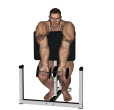 Spider Curl - Zottman Reverse Alternate
Spider Curl - Zottman Reverse Alternate
Benefits: Spider curls do a perfect job of placing maximum tension on the biceps in the fully contracted position. The reverse grip makes the exercise more difficult.
Purpose: This exercise works the biceps muscles but focuses also on the brachioradialis (a muscle that crosses the elbow joint and assists in rotating the forearm.
Beginner Biceps Forearms Shoulders Traps Strength Dumbbell Preacher Bench Pull Gym
General Info: The biceps muscle is a straight muscle with 2 heads. The long head crosses both the elbow and shoulder joints and bends the elbow and raises the arm forward at the shoulder. The short head of the biceps crosses the elbow joint and, in conjunction with the brachioradialis, supinates the hand.
 Squeeze - Standing Olympic Plate Hand
Squeeze - Standing Olympic Plate Hand
Benefits: This exercise focuses on finger gripping and strength.
Purpose: This exercise strengthens the forearm muscles as well as finger strength.
Intermediate Forearms Fingers Strength Plate Gym
General Info: A complete forearm program must achieve balanced development for all major forearm muscles. The forearm is involved in six different forearm movements. They include wrist flexion, wrist extension, wrist abduction, wrist adduction, forearm pronation, and forearm supination. There are additional muscles found in the forearm that are involved in movements like elbow flexion (brachioradialis), finger flexion, and finger extension.
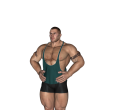 Stretch - Overhead
Stretch - Overhead
Benefits: This exercise is good after sitting at a desk or computer for any extended time. It is also good both before and after resistance exercising.
Purpose: This exercise loosens up and stretches the shoulder muscles. It also relieves tension in the chest and lats.
Intermediate Shoulders Chest Forearms Lats Triceps Stretching Body Only Gym Home
General Info: The shoulder muscles are a group of three muscles. The anterior (front) deltoid raises the arm toward the front and rotates the arm inward. The lateral (side) deltoid raises the arm to the side. The posterior (back) deltoid raises the arm toward the rear and rotates the arm outward.
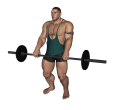 Upright Row - Barbell
Upright Row - Barbell
Benefits: The row is a highly effective compound upper-body exercise.
Purpose: The row is a good exercise for building up and strengthening the anterior (front) delts.
Intermediate Shoulders Traps Forearms Strength Barbell Pull Compound Gym
General Info: The Deltoids is a fan-shaped muscle. The Anterior (Front) Deltoid raises the arm toward the front of the body and rotates the arm inward. The Lateral (Side) Deltoid raises the arm to the side. The Posterior (Rear) Deltoid raises the arm toward the rear and rotates the arm outward.
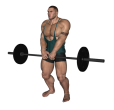 Upright Row - Barbell Close Grip
Upright Row - Barbell Close Grip
Benefits: The row is a highly effective compound upper-body exercise.
Purpose: The row is a good exercise for building up and strengthening the anterior (front) delts.
Intermediate Shoulders Traps Forearms Strength Barbell Pull Compound Gym
General Info: The Deltoids is a fan-shaped muscle. The Anterior (Front) Deltoid raises the arm toward the front of the body and rotates the arm inward. The Lateral (Side) Deltoid raises the arm to the side. The Posterior (Rear) Deltoid raises the arm toward the rear and rotates the arm outward.
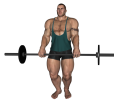 Upright Row - Barbell Narrow Stance
Upright Row - Barbell Narrow Stance
Benefits: The row is a highly effective compound upper-body exercise.
Purpose: The row is a good exercise for building up and strengthening the anterior (front) delts.
Intermediate Shoulders Traps Forearms Strength Barbell Pull Compound Gym
General Info: The Deltoids is a fan-shaped muscle. The Anterior (Front) Deltoid raises the arm toward the front of the body and rotates the arm inward. The Lateral (Side) Deltoid raises the arm to the side. The Posterior (Rear) Deltoid raises the arm toward the rear and rotates the arm outward.
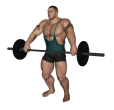 Upright Row - Barbell Wide Grip
Upright Row - Barbell Wide Grip
Benefits: The row is a highly effective compound upper-body exercise.
Purpose: The row is a good exercise for building up and strengthening the anterior (front) delts.
Intermediate Shoulders Traps Forearms Strength Barbell Pull Compound Gym
General Info: The Deltoids is a fan-shaped muscle. The Anterior (Front) Deltoid raises the arm toward the front of the body and rotates the arm inward. The Lateral (Side) Deltoid raises the arm to the side. The Posterior (Rear) Deltoid raises the arm toward the rear and rotates the arm outward.
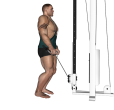 Upright Row - Cable
Upright Row - Cable
Benefits: The row is a highly effective compound upper-body exercise.
Purpose: The row is a good exercise for building up and strengthening the anterior (front) delts.
Intermediate Shoulders Traps Forearms Strength Cable Machine Pull Compound Gym
General Info: The Deltoids is a fan-shaped muscle. The Anterior (Front) Deltoid raises the arm toward the front of the body and rotates the arm inward. The Lateral (Side) Deltoid raises the arm to the side. The Posterior (Rear) Deltoid raises the arm toward the rear and rotates the arm outward.
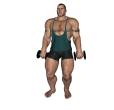 Upright Row - Dumbbell
Upright Row - Dumbbell
Benefits: The row is a highly effective compound upper-body exercise.
Purpose: The row is a good exercise for building up and strengthening the anterior (front) delts.
Intermediate Shoulders Traps Forearms Strength Dumbbell Pull Compound Gym
General Info: The Deltoids is a fan-shaped muscle. The Anterior (Front) Deltoid raises the arm toward the front of the body and rotates the arm inward. The Lateral (Side) Deltoid raises the arm to the side. The Posterior (Rear) Deltoid raises the arm toward the rear and rotates the arm outward.
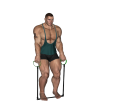 Upright Row - Exercise Band Standing
Upright Row - Exercise Band Standing
Benefits: The row is a highly effective compound upper-body exercise.
Purpose: The row is a good exercise for building up and strengthening the anterior (front) delts.
Intermediate Shoulders Traps Forearms Strength Band Pull Compound Gym
General Info: The Deltoids is a fan-shaped muscle. The Anterior (Front) Deltoid raises the arm toward the front of the body and rotates the arm inward. The Lateral (Side) Deltoid raises the arm to the side. The Posterior (Rear) Deltoid raises the arm toward the rear and rotates the arm outward.
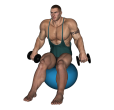 Upright Row - Fitness Ball Dumbbell
Upright Row - Fitness Ball Dumbbell
Benefits: The row is a highly effective compound upper-body exercise.
Purpose: The row is a good exercise for building up and strengthening the anterior (front) delts.
Intermediate Shoulders Traps Forearms Strength Dumbbell Fitness Ball Pull Compound Gym
General Info: The Deltoids is a fan-shaped muscle. The Anterior (Front) Deltoid raises the arm toward the front of the body and rotates the arm inward. The Lateral (Side) Deltoid raises the arm to the side. The Posterior (Rear) Deltoid raises the arm toward the rear and rotates the arm outward.
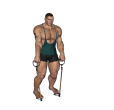 Upright Row - Resistance Tube Standing
Upright Row - Resistance Tube Standing
Benefits: The row is a highly effective compound upper-body exercise.
Purpose: The row is a good exercise for building up and strengthening the anterior (front) delts.
Intermediate Shoulders Traps Forearms Strength Resistance Tube Pull Compound Gym
General Info: The Deltoids is a fan-shaped muscle. The Anterior (Front) Deltoid raises the arm toward the front of the body and rotates the arm inward. The Lateral (Side) Deltoid raises the arm to the side. The Posterior (Rear) Deltoid raises the arm toward the rear and rotates the arm outward.
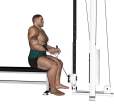 Upright Row - Seated Cable
Upright Row - Seated Cable
Benefits: The row is a highly effective compound upper-body exercise.
Purpose: The row is a good exercise for building up and strengthening the anterior (front) delts.
Intermediate Shoulders Traps Forearms Strength Cable Machine Flat Bench Pull Compound Gym
General Info: The Deltoids is a fan-shaped muscle. The Anterior (Front) Deltoid raises the arm toward the front of the body and rotates the arm inward. The Lateral (Side) Deltoid raises the arm to the side. The Posterior (Rear) Deltoid raises the arm toward the rear and rotates the arm outward.
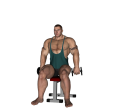 Upright Row - Seated Dumbbell
Upright Row - Seated Dumbbell
Benefits: The row is a highly effective compound upper-body exercise.
Purpose: The row is a good exercise for building up and strengthening the anterior (front) delts.
Intermediate Shoulders Traps Forearms Strength Dumbbell Flat Bench Pull Compound Gym
General Info: The Deltoids is a fan-shaped muscle. The Anterior (Front) Deltoid raises the arm toward the front of the body and rotates the arm inward. The Lateral (Side) Deltoid raises the arm to the side. The Posterior (Rear) Deltoid raises the arm toward the rear and rotates the arm outward.
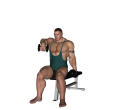 Upright Row - Seated Dumbbell Alternate
Upright Row - Seated Dumbbell Alternate
Benefits: The row is a highly effective compound upper-body exercise.
Purpose: The row is a good exercise for building up and strengthening the anterior (front) delts.
Intermediate Shoulders Traps Forearms Strength Dumbbell Flat Bench Pull Compound Gym
General Info: The Deltoids is a fan-shaped muscle. The Anterior (Front) Deltoid raises the arm toward the front of the body and rotates the arm inward. The Lateral (Side) Deltoid raises the arm to the side. The Posterior (Rear) Deltoid raises the arm toward the rear and rotates the arm outward.
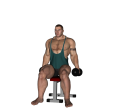 Upright Row - Seated Dumbbell Narrow Stance
Upright Row - Seated Dumbbell Narrow Stance
Benefits: The row is a highly effective compound upper-body exercise.
Purpose: The row is a good exercise for building up and strengthening the anterior (front) delts.
Intermediate Shoulders Traps Forearms Strength Dumbbell Flat Bench Pull Compound Gym
General Info: The Deltoids is a fan-shaped muscle. The Anterior (Front) Deltoid raises the arm toward the front of the body and rotates the arm inward. The Lateral (Side) Deltoid raises the arm to the side. The Posterior (Rear) Deltoid raises the arm toward the rear and rotates the arm outward.
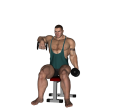 Upright Row - Seated Dumbbell Narrow Stance Alternate
Upright Row - Seated Dumbbell Narrow Stance Alternate
Benefits: The row is a highly effective compound upper-body exercise.
Purpose: The row is a good exercise for building up and strengthening the anterior (front) delts.
Intermediate Shoulders Traps Forearms Strength Dumbbell Flat Bench Pull Compound Gym
General Info: The Deltoids is a fan-shaped muscle. The Anterior (Front) Deltoid raises the arm toward the front of the body and rotates the arm inward. The Lateral (Side) Deltoid raises the arm to the side. The Posterior (Rear) Deltoid raises the arm toward the rear and rotates the arm outward.
 Upright Row - Seated Single Narrow Stance Alternate
Upright Row - Seated Single Narrow Stance Alternate
Benefits: The row is a highly effective compound upper-body exercise.
Purpose: The row is a good exercise for building up and strengthening the anterior (front) delts.
Intermediate Shoulders Traps Forearms Strength Dumbbell Flat Bench Pull Compound Gym
General Info: The Deltoids is a fan-shaped muscle. The Anterior (Front) Deltoid raises the arm toward the front of the body and rotates the arm inward. The Lateral (Side) Deltoid raises the arm to the side. The Posterior (Rear) Deltoid raises the arm toward the rear and rotates the arm outward.
 Upright Row - Seated Water Bottle
Upright Row - Seated Water Bottle
Benefits: The row is a highly effective compound upper-body exercise.
Purpose: The row is a good exercise for building up and strengthening the anterior (front) delts.
Intermediate Shoulders Traps Forearms Strength Water Bottle Chair Pull Compound Home
General Info: The Deltoids is a fan-shaped muscle. The Anterior (Front) Deltoid raises the arm toward the front of the body and rotates the arm inward. The Lateral (Side) Deltoid raises the arm to the side. The Posterior (Rear) Deltoid raises the arm toward the rear and rotates the arm outward.
 Upright Row - Seated Water Bottle Alternate
Upright Row - Seated Water Bottle Alternate
Benefits: The row is a highly effective compound upper-body exercise.
Purpose: The row is a good exercise for building up and strengthening the anterior (front) delts.
Intermediate Shoulders Traps Forearms Strength Water Bottle Chair Pull Compound Home
General Info: The Deltoids is a fan-shaped muscle. The Anterior (Front) Deltoid raises the arm toward the front of the body and rotates the arm inward. The Lateral (Side) Deltoid raises the arm to the side. The Posterior (Rear) Deltoid raises the arm toward the rear and rotates the arm outward.
 Upright Row - Seated Water Bottle Narrow
Upright Row - Seated Water Bottle Narrow
Benefits: The row is a highly effective compound upper-body exercise.
Purpose: The row is a good exercise for building up and strengthening the anterior (front) delts.
Intermediate Shoulders Traps Forearms Strength Water Bottle Chair Pull Compound Home
General Info: The Deltoids is a fan-shaped muscle. The Anterior (Front) Deltoid raises the arm toward the front of the body and rotates the arm inward. The Lateral (Side) Deltoid raises the arm to the side. The Posterior (Rear) Deltoid raises the arm toward the rear and rotates the arm outward.
 Upright Row - Seated Water Bottle Narrow Alternate
Upright Row - Seated Water Bottle Narrow Alternate
Benefits: The row is a highly effective compound upper-body exercise.
Purpose: The row is a good exercise for building up and strengthening the anterior (front) delts.
Intermediate Shoulders Traps Forearms Strength Water Bottle Chair Pull Compound Home
General Info: The Deltoids is a fan-shaped muscle. The Anterior (Front) Deltoid raises the arm toward the front of the body and rotates the arm inward. The Lateral (Side) Deltoid raises the arm to the side. The Posterior (Rear) Deltoid raises the arm toward the rear and rotates the arm outward.
 Upright Row - Single Dumbbell
Upright Row - Single Dumbbell
Benefits: The row is a highly effective compound upper-body exercise.
Purpose: The row is a good exercise for building up and strengthening the anterior (front) delts.
Intermediate Shoulders Traps Forearms Strength Dumbbell Pull Compound Gym
General Info: The Deltoids is a fan-shaped muscle. The Anterior (Front) Deltoid raises the arm toward the front of the body and rotates the arm inward. The Lateral (Side) Deltoid raises the arm to the side. The Posterior (Rear) Deltoid raises the arm toward the rear and rotates the arm outward.
 Upright Row - Single Seated Dumbbell
Upright Row - Single Seated Dumbbell
Benefits: The row is a highly effective compound upper-body exercise.
Purpose: The row is a good exercise for building up and strengthening the anterior (front) delts.
Intermediate Shoulders Traps Forearms Strength Dumbbell Flat Bench Pull Compound Gym
General Info: The Deltoids is a fan-shaped muscle. The Anterior (Front) Deltoid raises the arm toward the front of the body and rotates the arm inward. The Lateral (Side) Deltoid raises the arm to the side. The Posterior (Rear) Deltoid raises the arm toward the rear and rotates the arm outward.
 Upright Row - Single Seated Water Bottle
Upright Row - Single Seated Water Bottle
Benefits: The row is a highly effective compound upper-body exercise.
Purpose: The row is a good exercise for building up and strengthening the anterior (front) delts.
Intermediate Shoulders Traps Forearms Strength Water Bottle Chair Pull Compound Home
General Info: The Deltoids is a fan-shaped muscle. The Anterior (Front) Deltoid raises the arm toward the front of the body and rotates the arm inward. The Lateral (Side) Deltoid raises the arm to the side. The Posterior (Rear) Deltoid raises the arm toward the rear and rotates the arm outward.
 Upright Row - Single Water Bottle
Upright Row - Single Water Bottle
Benefits: The row is a highly effective compound upper-body exercise.
Purpose: The row is a good exercise for building up and strengthening the anterior (front) delts.
Intermediate Shoulders Traps Forearms Strength Water Bottle Pull Compound Home
General Info: The Deltoids is a fan-shaped muscle. The Anterior (Front) Deltoid raises the arm toward the front of the body and rotates the arm inward. The Lateral (Side) Deltoid raises the arm to the side. The Posterior (Rear) Deltoid raises the arm toward the rear and rotates the arm outward.
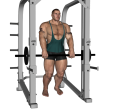 Upright Row - Smith Machine
Upright Row - Smith Machine
Benefits: The row is a highly effective compound upper-body exercise.
Purpose: The row is a good exercise for building up and strengthening the anterior (front) delts.
Intermediate Shoulders Traps Forearms Strength Smith Machine Pull Compound Gym
General Info: The Deltoids is a fan-shaped muscle. The Anterior (Front) Deltoid raises the arm toward the front of the body and rotates the arm inward. The Lateral (Side) Deltoid raises the arm to the side. The Posterior (Rear) Deltoid raises the arm toward the rear and rotates the arm outward.
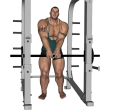 Upright Row - Smith Machine Close Grip
Upright Row - Smith Machine Close Grip
Benefits: The row is a highly effective compound upper-body exercise.
Purpose: The row is a good exercise for building up and strengthening the anterior (front) delts.
Intermediate Shoulders Traps Forearms Strength Smith Machine Pull Compound Gym
General Info: The Deltoids is a fan-shaped muscle. The Anterior (Front) Deltoid raises the arm toward the front of the body and rotates the arm inward. The Lateral (Side) Deltoid raises the arm to the side. The Posterior (Rear) Deltoid raises the arm toward the rear and rotates the arm outward.
 Upright Row - Smith Machine Close Grip Kneeling
Upright Row - Smith Machine Close Grip Kneeling
Benefits: The row is a highly effective compound upper-body exercise.
Purpose: The row is a good exercise for building up and strengthening the anterior (front) delts.
Intermediate Shoulders Traps Forearms Strength Smith Machine Pull Compound Gym
General Info: The Deltoids is a fan-shaped muscle. The Anterior (Front) Deltoid raises the arm toward the front of the body and rotates the arm inward. The Lateral (Side) Deltoid raises the arm to the side. The Posterior (Rear) Deltoid raises the arm toward the rear and rotates the arm outward.
 Upright Row - Smith Machine Kneeling Upright
Upright Row - Smith Machine Kneeling Upright
Benefits: The row is a highly effective compound upper-body exercise.
Purpose: The row is a good exercise for building up and strengthening the anterior (front) delts.
Intermediate Shoulders Traps Forearms Strength Smith Machine Pull Compound Gym
General Info: The Deltoids is a fan-shaped muscle. The Anterior (Front) Deltoid raises the arm toward the front of the body and rotates the arm inward. The Lateral (Side) Deltoid raises the arm to the side. The Posterior (Rear) Deltoid raises the arm toward the rear and rotates the arm outward.
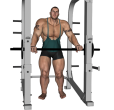 Upright Row - Smith Machine Wide Grip
Upright Row - Smith Machine Wide Grip
Benefits: The row is a highly effective compound upper-body exercise.
Purpose: The row is a good exercise for building up and strengthening the anterior (front) delts.
Intermediate Shoulders Traps Forearms Strength Smith Machine Pull Compound Gym
General Info: The Deltoids is a fan-shaped muscle. The Anterior (Front) Deltoid raises the arm toward the front of the body and rotates the arm inward. The Lateral (Side) Deltoid raises the arm to the side. The Posterior (Rear) Deltoid raises the arm toward the rear and rotates the arm outward.
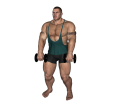 Upright Row - Standing Dumbbell
Upright Row - Standing Dumbbell
Benefits: The row is a highly effective compound upper-body exercise.
Purpose: The row is a good exercise for building up and strengthening the anterior (front) delts.
Intermediate Shoulders Traps Forearms Strength Dumbbell Pull Compound Gym
General Info: The Deltoids is a fan-shaped muscle. The Anterior (Front) Deltoid raises the arm toward the front of the body and rotates the arm inward. The Lateral (Side) Deltoid raises the arm to the side. The Posterior (Rear) Deltoid raises the arm toward the rear and rotates the arm outward.
 Upright Row - Water Bottle
Upright Row - Water Bottle
Benefits: The row is a highly effective compound upper-body exercise.
Purpose: The row is a good exercise for building up and strengthening the anterior (front) delts.
Intermediate Shoulders Traps Forearms Strength Water Bottle Pull Compound Home
General Info: The Deltoids is a fan-shaped muscle. The Anterior (Front) Deltoid raises the arm toward the front of the body and rotates the arm inward. The Lateral (Side) Deltoid raises the arm to the side. The Posterior (Rear) Deltoid raises the arm toward the rear and rotates the arm outward.
 Upright Row - With Chains
Upright Row - With Chains
Benefits: This exercise is done with the addition of chains. The primary function of chains is to accommodate resistance. Chains are also a great means of weight loading (adding more weight to an exercise). Chains are also a great way for working the stabilizers.
Purpose: Benefits The row is a highly effective compound upper-body exercise.
Intermediate Shoulders Traps Forearms Strength Chains Pull Compound Gym
General Info: The Deltoids is a fan-shaped muscle. The Anterior (Front) Deltoid raises the arm toward the front of the body and rotates the arm inward. The Lateral (Side) Deltoid raises the arm to the side. The Posterior (Rear) Deltoid raises the arm toward the rear and rotates the arm outward.
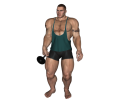 Wrist Abduction - Single Ended Dumbbell
Wrist Abduction - Single Ended Dumbbell
Benefits: This exercise focuses on the wrist abductors, a muscle group that hardly is ever exercised in the gym.
Purpose: This exercise strengthens the muscles that abduct the wrist.
Beginner Forearms Strength Single Ended Dumbbell Pull Gym
General Info: A complete forearm program must achieve balanced development for all major forearm muscles. The forearm is involved in six different forearm movements. They include wrist flexion, wrist extension, wrist abduction, wrist adduction, forearm pronation, and forearm supination. There are additional muscles found in the forearm that are involved in movements like elbow flexion (brachioradialis), finger flexion, and finger extension.
 Wrist Abduction - Water Bottle
Wrist Abduction - Water Bottle
Benefits: This exercise focuses on the wrist abductors, a muscle group that hardly is ever exercised in the gym.
Purpose: This exercise strengthens the muscles that abduct the wrist.
Beginner Forearms Strength Water Bottle Pull Home
General Info: A complete forearm program must achieve balanced development for all major forearm muscles. The forearm is involved in six different forearm movements. They include wrist flexion, wrist extension, wrist abduction, wrist adduction, forearm pronation, and forearm supination. There are additional muscles found in the forearm that are involved in movements like elbow flexion (brachioradialis), finger flexion, and finger extension.
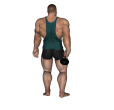 Wrist Adduction - Single Ended Dumbbell
Wrist Adduction - Single Ended Dumbbell
Benefits: This exercise focuses on the wrist adductors, a muscle group that hardly is ever exercised in the gym.
Purpose: This exercise strengthens the muscles that adduct the wrist.
Beginner Forearms Strength Single Ended Dumbbell Pull Gym
General Info: A complete forearm program must achieve balanced development for all major forearm muscles. The forearm is involved in six different forearm movements. They include wrist flexion, wrist extension, wrist abduction, wrist adduction, forearm pronation, and forearm supination. There are additional muscles found in the forearm that are involved in movements like elbow flexion (brachioradialis), finger flexion, and finger extension.
 Wrist Adduction - Water Bottle
Wrist Adduction - Water Bottle
Benefits: This exercise focuses on the wrist adductors, a muscle group that hardly is ever exercised in the gym.
Purpose: This exercise strengthens the muscles that adduct the wrist.
Beginner Forearms Strength Water Bottle Pull Home
General Info: A complete forearm program must achieve balanced development for all major forearm muscles. The forearm is involved in six different forearm movements. They include wrist flexion, wrist extension, wrist abduction, wrist adduction, forearm pronation, and forearm supination. There are additional muscles found in the forearm that are involved in movements like elbow flexion (brachioradialis), finger flexion, and finger extension.
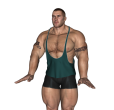 Wrist Circles - Fundamental
Wrist Circles - Fundamental
Benefits: This exercise focuses on wrist flexibility.
Purpose: This exercise provides more flexibility in the wrist.
Intermediate Forearms Strength Body Only Gym
General Info: A complete forearm program must achieve balanced development for all major forearm muscles. The forearm is involved in six different forearm movements. They include wrist flexion, wrist extension, wrist abduction, wrist adduction, forearm pronation, and forearm supination. There are additional muscles found in the forearm that are involved in movements like elbow flexion (brachioradialis), finger flexion, and finger extension.
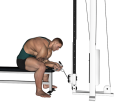 Wrist Curl - Cable
Wrist Curl - Cable
Benefits: This exercise focuses on the wrist flexors with the forearms supinated.
Purpose: This exercise strengthens the muscles that flex the wrist.
Beginner Forearms Strength Cable Machine Flat Bench Pull Gym
General Info: A complete forearm program must achieve balanced development for all major forearm muscles. The forearm is involved in six different forearm movements. They include wrist flexion, wrist extension, wrist abduction, wrist adduction, forearm pronation, and forearm supination. There are additional muscles found in the forearm that are involved in movements like elbow flexion (brachioradialis), finger flexion, and finger extension.
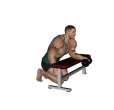 Wrist Curl - Kneeling Dumbbell Single
Wrist Curl - Kneeling Dumbbell Single
Benefits: This exercise focuses on the wrist flexors with the forearms supinated.
Purpose: This exercise strengthens the muscles that flex the wrist.
Beginner Forearms Strength Dumbbell Flat Bench Pull Gym
General Info: A complete forearm program must achieve balanced development for all major forearm muscles. The forearm is involved in six different forearm movements. They include wrist flexion, wrist extension, wrist abduction, wrist adduction, forearm pronation, and forearm supination. There are additional muscles found in the forearm that are involved in movements like elbow flexion (brachioradialis), finger flexion, and finger extension.
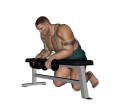 Wrist Curl - Palms Down Dumbbell Over Bench
Wrist Curl - Palms Down Dumbbell Over Bench
Benefits: This exercise focuses on the wrist extensors and indirectly on the brachioradialis.
Purpose: This exercise strengthens the muscles that extend the wrist.
Beginner Forearms Strength Dumbbell Flat Bench Pull Gym
General Info: A complete forearm program must achieve balanced development for all major forearm muscles. The forearm is involved in six different forearm movements. They include wrist flexion, wrist extension, wrist abduction, wrist adduction, forearm pronation, and forearm supination. There are additional muscles found in the forearm that are involved in movements like elbow flexion (brachioradialis), finger flexion, and finger extension.
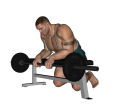 Wrist Curl - Palms Down Over Bench
Wrist Curl - Palms Down Over Bench
Benefits: This exercise focuses on the wrist extensors and indirectly on the brachioradialis.
Purpose: This exercise strengthens the muscles that extend the wrist.
Beginner Forearms Strength Barbell Flat Bench Pull Gym
General Info: A complete forearm program must achieve balanced development for all major forearm muscles. The forearm is involved in six different forearm movements. They include wrist flexion, wrist extension, wrist abduction, wrist adduction, forearm pronation, and forearm supination. There are additional muscles found in the forearm that are involved in movements like elbow flexion (brachioradialis), finger flexion, and finger extension.
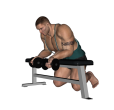 Wrist Curl - Palms Up Dumbbell Over Bench
Wrist Curl - Palms Up Dumbbell Over Bench
Benefits: This exercise focuses on the wrist flexors with the forearms supinated.
Purpose: This exercise strengthens the muscles that flex the wrist.
Beginner Forearms Strength Dumbbell Flat Bench Pull Gym
General Info: A complete forearm program must achieve balanced development for all major forearm muscles. The forearm is involved in six different forearm movements. They include wrist flexion, wrist extension, wrist abduction, wrist adduction, forearm pronation, and forearm supination. There are additional muscles found in the forearm that are involved in movements like elbow flexion (brachioradialis), finger flexion, and finger extension.
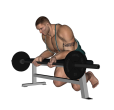 Wrist Curl - Palms Up Over Bench
Wrist Curl - Palms Up Over Bench
Benefits: This exercise focuses on the wrist flexors with the forearms supinated.
Purpose: This exercise strengthens the muscles that flex the wrist.
Beginner Forearms Strength Barbell Flat Bench Pull Gym
General Info: A complete forearm program must achieve balanced development for all major forearm muscles. The forearm is involved in six different forearm movements. They include wrist flexion, wrist extension, wrist abduction, wrist adduction, forearm pronation, and forearm supination. There are additional muscles found in the forearm that are involved in movements like elbow flexion (brachioradialis), finger flexion, and finger extension.
 Wrist Curl - Reverse Barbell
Wrist Curl - Reverse Barbell
Benefits: This exercise focuses on the wrist extensors and indirectly on the brachioradialis.
Purpose: This exercise strengthens the muscles that extend the wrist.
Beginner Forearms Strength Barbell Flat Bench Pull Gym
General Info: A complete forearm program must achieve balanced development for all major forearm muscles. The forearm is involved in six different forearm movements. They include wrist flexion, wrist extension, wrist abduction, wrist adduction, forearm pronation, and forearm supination. There are additional muscles found in the forearm that are involved in movements like elbow flexion (brachioradialis), finger flexion, and finger extension.
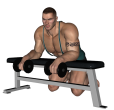 Wrist Curl - Reverse Dumbbell
Wrist Curl - Reverse Dumbbell
Benefits: This exercise focuses on the wrist extensors and indirectly on the brachioradialis.
Purpose: This exercise strengthens the muscles that extend the wrist.
Beginner Forearms Strength Dumbbell Flat Bench Pull Gym
General Info: A complete forearm program must achieve balanced development for all major forearm muscles. The forearm is involved in six different forearm movements. They include wrist flexion, wrist extension, wrist abduction, wrist adduction, forearm pronation, and forearm supination. There are additional muscles found in the forearm that are involved in movements like elbow flexion (brachioradialis), finger flexion, and finger extension.
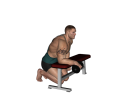 Wrist Curl - Reverse Dumbbell Single
Wrist Curl - Reverse Dumbbell Single
Benefits: This exercise focuses on the wrist extensors and indirectly on the brachioradialis.
Purpose: This exercise strengthens the muscles that extend the wrist.
Beginner Forearms Strength Dumbbell Flat Bench Pull Gym
General Info: A complete forearm program must achieve balanced development for all major forearm muscles. The forearm is involved in six different forearm movements. They include wrist flexion, wrist extension, wrist abduction, wrist adduction, forearm pronation, and forearm supination. There are additional muscles found in the forearm that are involved in movements like elbow flexion (brachioradialis), finger flexion, and finger extension.
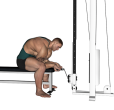 Wrist Curl - Seated 2 Arm Low Pulley
Wrist Curl - Seated 2 Arm Low Pulley
Benefits: This exercise focuses on the wrist flexors with the forearms supinated.
Purpose: This exercise strengthens the muscles that flex the wrist.
Beginner Forearms Strength High Low Cable Machine Flat Bench Pull Gym
General Info: A complete forearm program must achieve balanced development for all major forearm muscles. The forearm is involved in six different forearm movements. They include wrist flexion, wrist extension, wrist abduction, wrist adduction, forearm pronation, and forearm supination. There are additional muscles found in the forearm that are involved in movements like elbow flexion (brachioradialis), finger flexion, and finger extension.
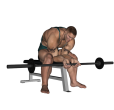 Wrist Curl - Seated Barbell
Wrist Curl - Seated Barbell
Benefits: This exercise focuses on the wrist flexors with the forearms supinated.
Purpose: This exercise strengthens the muscles that flex the wrist.
Beginner Forearms Strength Barbell Flat Bench Pull Gym
General Info: A complete forearm program must achieve balanced development for all major forearm muscles. The forearm is involved in six different forearm movements. They include wrist flexion, wrist extension, wrist abduction, wrist adduction, forearm pronation, and forearm supination. There are additional muscles found in the forearm that are involved in movements like elbow flexion (brachioradialis), finger flexion, and finger extension.
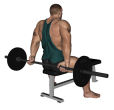 Wrist Curl - Seated Barbell Behind
Wrist Curl - Seated Barbell Behind
Benefits: This exercise isolates the wrist flexors with little involvement of the brachioradialis.
Purpose: This exercise strengthens the muscles that flex the wrist.
Beginner Forearms Strength Barbell Flat Bench Pull Gym
General Info: A complete forearm program must achieve balanced development for all major forearm muscles. The forearm is involved in six different forearm movements. They include wrist flexion, wrist extension, wrist abduction, wrist adduction, forearm pronation, and forearm supination. There are additional muscles found in the forearm that are involved in movements like elbow flexion (brachioradialis), finger flexion, and finger extension.
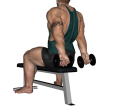 Wrist Curl - Seated Behind Dumbbell
Wrist Curl - Seated Behind Dumbbell
Benefits: This exercise focuses on the wrist flexors with the forearms supinated.
Purpose: This exercise strengthens the muscles that flex the wrist.
Beginner Forearms Strength Barbell Flat Bench Pull Gym
General Info: A complete forearm program must achieve balanced development for all major forearm muscles. The forearm is involved in six different forearm movements. They include wrist flexion, wrist extension, wrist abduction, wrist adduction, forearm pronation, and forearm supination. There are additional muscles found in the forearm that are involved in movements like elbow flexion (brachioradialis), finger flexion, and finger extension.
 Wrist Curl - Seated Chains
Wrist Curl - Seated Chains
Benefits: This exercise is done with the addition of chains. The primary function of chains is to accommodate resistance. Chains are also a great means of weight loading (adding more weight to an exercise). Chains are also a great way for working the stabilizers.
Purpose: Benefits This exercise focuses on the wrist flexors with the forearms supinated.
Beginner Forearms Strength Chains Flat Bench Pull Gym
General Info: A complete forearm program must achieve balanced development for all major forearm muscles. The forearm is involved in six different forearm movements. They include wrist flexion, wrist extension, wrist abduction, wrist adduction, forearm pronation, and forearm supination. There are additional muscles found in the forearm that are involved in movements like elbow flexion (brachioradialis), finger flexion, and finger extension.
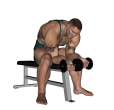 Wrist Curl - Seated Dumbbell
Wrist Curl - Seated Dumbbell
Benefits: This exercise focuses on the wrist flexors with the forearms supinated.
Purpose: This exercise strengthens the muscles that flex the wrist.
Beginner Forearms Strength Dumbbell Flat Bench Pull Gym
General Info: A complete forearm program must achieve balanced development for all major forearm muscles. The forearm is involved in six different forearm movements. They include wrist flexion, wrist extension, wrist abduction, wrist adduction, forearm pronation, and forearm supination. There are additional muscles found in the forearm that are involved in movements like elbow flexion (brachioradialis), finger flexion, and finger extension.
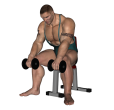 Wrist Curl - Seated Dumbbell Palms Down
Wrist Curl - Seated Dumbbell Palms Down
Benefits: This exercise focuses on the wrist extensors with the forearms pronated.
Purpose: This exercise strengthens the muscles that flex the wrist.
Beginner Forearms Strength Dumbbell Flat Bench Pull Gym
General Info: A complete forearm program must achieve balanced development for all major forearm muscles. The forearm is involved in six different forearm movements. They include wrist flexion, wrist extension, wrist abduction, wrist adduction, forearm pronation, and forearm supination. There are additional muscles found in the forearm that are involved in movements like elbow flexion (brachioradialis), finger flexion, and finger extension.
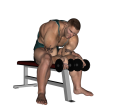 Wrist Curl - Seated Dumbbell Palms Up
Wrist Curl - Seated Dumbbell Palms Up
Benefits: This exercise focuses on the wrist flexors with the forearms supinated.
Purpose: This exercise strengthens the muscles that flex the wrist.
Beginner Forearms Strength Dumbbell Flat Bench Pull Gym
General Info: A complete forearm program must achieve balanced development for all major forearm muscles. The forearm is involved in six different forearm movements. They include wrist flexion, wrist extension, wrist abduction, wrist adduction, forearm pronation, and forearm supination. There are additional muscles found in the forearm that are involved in movements like elbow flexion (brachioradialis), finger flexion, and finger extension.
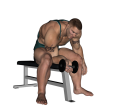 Wrist Curl - Seated Dumbbell Single
Wrist Curl - Seated Dumbbell Single
Benefits: This exercise focuses on the wrist flexors with the forearms supinated.
Purpose: This exercise strengthens the muscles that flex the wrist.
Beginner Forearms Strength Dumbbell Flat Bench Pull Gym
General Info: A complete forearm program must achieve balanced development for all major forearm muscles. The forearm is involved in six different forearm movements. They include wrist flexion, wrist extension, wrist abduction, wrist adduction, forearm pronation, and forearm supination. There are additional muscles found in the forearm that are involved in movements like elbow flexion (brachioradialis), finger flexion, and finger extension.
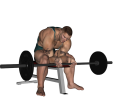 Wrist Curl - Seated Palms Up Barbell
Wrist Curl - Seated Palms Up Barbell
Benefits: This exercise focuses on the wrist flexors with the forearms supinated.
Purpose: This exercise strengthens the muscles that flex the wrist.
Beginner Forearms Strength Barbell Flat Bench Pull Gym
General Info: A complete forearm program must achieve balanced development for all major forearm muscles. The forearm is involved in six different forearm movements. They include wrist flexion, wrist extension, wrist abduction, wrist adduction, forearm pronation, and forearm supination. There are additional muscles found in the forearm that are involved in movements like elbow flexion (brachioradialis), finger flexion, and finger extension.
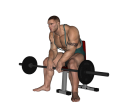 Wrist Curl - Seated Reverse Barbell
Wrist Curl - Seated Reverse Barbell
Benefits: This exercise focuses on the wrist extensors with the forearms pronated.
Purpose: This exercise strengthens the muscles that flex the wrist.
Beginner Forearms Strength Barbell Flat Bench Pull Gym
General Info: A complete forearm program must achieve balanced development for all major forearm muscles. The forearm is involved in six different forearm movements. They include wrist flexion, wrist extension, wrist abduction, wrist adduction, forearm pronation, and forearm supination. There are additional muscles found in the forearm that are involved in movements like elbow flexion (brachioradialis), finger flexion, and finger extension.
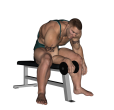 Wrist Curl - Seated Reverse Dumbbell Single
Wrist Curl - Seated Reverse Dumbbell Single
Benefits: This exercise focuses on the wrist flexors with the forearms supinated.
Purpose: This exercise strengthens the muscles that flex the wrist.
Beginner Forearms Strength Dumbbell Flat Bench Pull Gym
General Info: A complete forearm program must achieve balanced development for all major forearm muscles. The forearm is involved in six different forearm movements. They include wrist flexion, wrist extension, wrist abduction, wrist adduction, forearm pronation, and forearm supination. There are additional muscles found in the forearm that are involved in movements like elbow flexion (brachioradialis), finger flexion, and finger extension.
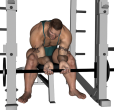 Wrist Curl - Smith Machine
Wrist Curl - Smith Machine
Benefits: This exercise focuses on the wrist flexors with the forearms supinated.
Purpose: This exercise strengthens the muscles that flex the wrist.
Beginner Forearms Strength Smith Machine Flat Bench Pull Gym
General Info: A complete forearm program must achieve balanced development for all major forearm muscles. The forearm is involved in six different forearm movements. They include wrist flexion, wrist extension, wrist abduction, wrist adduction, forearm pronation, and forearm supination. There are additional muscles found in the forearm that are involved in movements like elbow flexion (brachioradialis), finger flexion, and finger extension.
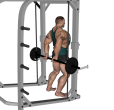 Wrist Curl - Smith Machine Behind
Wrist Curl - Smith Machine Behind
Benefits: This exercise isolates the wrist flexors with little involvement of the brachioradialis.
Purpose: This exercise strengthens the muscles that flex the wrist.
Beginner Forearms Strength Smith Machine Pull Gym
General Info: A complete forearm program must achieve balanced development for all major forearm muscles. The forearm is involved in six different forearm movements. They include wrist flexion, wrist extension, wrist abduction, wrist adduction, forearm pronation, and forearm supination. There are additional muscles found in the forearm that are involved in movements like elbow flexion (brachioradialis), finger flexion, and finger extension.
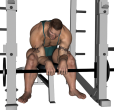 Wrist Curl - Smith Machine Reverse
Wrist Curl - Smith Machine Reverse
Benefits: This exercise focuses on the wrist flexors with the forearms supinated.
Purpose: This exercise strengthens the muscles that flex the wrist.
Beginner Forearms Strength Smith Machine Flat Bench Pull Gym
General Info: A complete forearm program must achieve balanced development for all major forearm muscles. The forearm is involved in six different forearm movements. They include wrist flexion, wrist extension, wrist abduction, wrist adduction, forearm pronation, and forearm supination. There are additional muscles found in the forearm that are involved in movements like elbow flexion (brachioradialis), finger flexion, and finger extension.
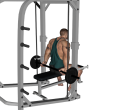 Wrist Curl - Smith Machine Seated Behind Back
Wrist Curl - Smith Machine Seated Behind Back
Benefits: This exercise isolates the wrist flexors with little involvement of the brachioradialis.
Purpose: This exercise strengthens the muscles that flex the wrist.
Beginner Forearms Strength Smith Machine Flat Bench Pull Gym
General Info: A complete forearm program must achieve balanced development for all major forearm muscles. The forearm is involved in six different forearm movements. They include wrist flexion, wrist extension, wrist abduction, wrist adduction, forearm pronation, and forearm supination. There are additional muscles found in the forearm that are involved in movements like elbow flexion (brachioradialis), finger flexion, and finger extension.
 Wrist Curl - Smith Machine Standing
Wrist Curl - Smith Machine Standing
Benefits: This exercise focuses on the wrist flexors with the forearms supinated.
Purpose: This exercise strengthens the muscles that flex the wrist.
Beginner Forearms Strength Smith Machine Pull Gym
General Info: A complete forearm program must achieve balanced development for all major forearm muscles. The forearm is involved in six different forearm movements. They include wrist flexion, wrist extension, wrist abduction, wrist adduction, forearm pronation, and forearm supination. There are additional muscles found in the forearm that are involved in movements like elbow flexion (brachioradialis), finger flexion, and finger extension.
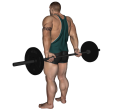 Wrist Curl - Standing Bar Behind Back
Wrist Curl - Standing Bar Behind Back
Benefits: This exercise isolates the wrist flexors with little involvement of the brachioradialis.
Purpose: This exercise strengthens the muscles that flex the wrist.
Beginner Forearms Strength Barbell Pull Gym
General Info: A complete forearm program must achieve balanced development for all major forearm muscles. The forearm is involved in six different forearm movements. They include wrist flexion, wrist extension, wrist abduction, wrist adduction, forearm pronation, and forearm supination. There are additional muscles found in the forearm that are involved in movements like elbow flexion (brachioradialis), finger flexion, and finger extension.
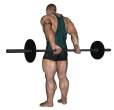 Wrist Curl - Standing Bar Behind Close Grip
Wrist Curl - Standing Bar Behind Close Grip
Benefits: This exercise isolates the wrist flexors with little involvement of the brachioradialis.
Purpose: This exercise strengthens the muscles that flex the wrist.
Beginner Forearms Strength Barbell Pull Gym
General Info: A complete forearm program must achieve balanced development for all major forearm muscles. The forearm is involved in six different forearm movements. They include wrist flexion, wrist extension, wrist abduction, wrist adduction, forearm pronation, and forearm supination. There are additional muscles found in the forearm that are involved in movements like elbow flexion (brachioradialis), finger flexion, and finger extension.
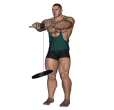 Wrist Roller - Basic
Wrist Roller - Basic
Benefits: This exercise focuses on both the wrist flexors and extensors with the forearms pronated.
Purpose: This exercise strengthens the muscles that flex and extend the wrist.
Beginner Forearms Strength Wrist Roller Pull Gym
General Info: A complete forearm program must achieve balanced development for all major forearm muscles. The forearm is involved in six different forearm movements. They include wrist flexion, wrist extension, wrist abduction, wrist adduction, forearm pronation, and forearm supination. There are additional muscles found in the forearm that are involved in movements like elbow flexion (brachioradialis), finger flexion, and finger extension.
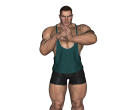 Wrist Stretch - Back Variation 1
Wrist Stretch - Back Variation 1
Benefits: This exercise focuses on the back of the wrist, a muscle group that hardly is ever exercised in the gym.
Purpose: This exercise stretches the tendons running down the back of the wrist.
Beginner Forearms Strength Body Only Pull Gym
General Info: A complete forearm program must achieve balanced development for all major forearm muscles. The forearm is involved in six different forearm movements. They include wrist flexion, wrist extension, wrist abduction, wrist adduction, forearm pronation, and forearm supination. There are additional muscles found in the forearm that are involved in movements like elbow flexion (brachioradialis), finger flexion, and finger extension.
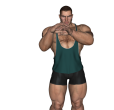 Wrist Stretch - Back Variation 2
Wrist Stretch - Back Variation 2
Benefits: This exercise focuses on the back of the wrist, a muscle group that hardly is ever exercised in the gym.
Purpose: This exercise stretches the thumb tendons and the tendons running down the back of the wrist.
Beginner Forearms Strength Body Only Pull Gym
General Info: A complete forearm program must achieve balanced development for all major forearm muscles. The forearm is involved in six different forearm movements. They include wrist flexion, wrist extension, wrist abduction, wrist adduction, forearm pronation, and forearm supination. There are additional muscles found in the forearm that are involved in movements like elbow flexion (brachioradialis), finger flexion, and finger extension.
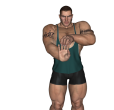 Wrist Stretch - Front
Wrist Stretch - Front
Benefits: This exercise focuses on the front of the wrist, a muscle group that hardly is ever exercised in the gym.
Purpose: This exercise stretches the tendons running down the front of the wrist.
Beginner Forearms Strength Body Only Pull Gym
General Info: A complete forearm program must achieve balanced development for all major forearm muscles. The forearm is involved in six different forearm movements. They include wrist flexion, wrist extension, wrist abduction, wrist adduction, forearm pronation, and forearm supination. There are additional muscles found in the forearm that are involved in movements like elbow flexion (brachioradialis), finger flexion, and finger extension.
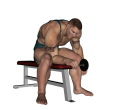 Wrist Twist - Single Ended Dumbbell
Wrist Twist - Single Ended Dumbbell
Benefits: This exercise focuses on the wrist adductors, a muscle group that hardly is ever exercised in the gym.
Purpose: This exercise strengthens the muscles that adduct the wrist.
Beginner Forearms Strength Single Ended Dumbbell Flat Bench Pull Gym
General Info: A complete forearm program must achieve balanced development for all major forearm muscles. The forearm is involved in six different forearm movements. They include wrist flexion, wrist extension, wrist abduction, wrist adduction, forearm pronation, and forearm supination. There are additional muscles found in the forearm that are involved in movements like elbow flexion (brachioradialis), finger flexion, and finger extension.
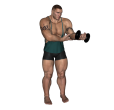 Wrist Twist - Standing Dumbbell One Wrist
Wrist Twist - Standing Dumbbell One Wrist
Benefits: This exercise focuses on the wrist adductors, a muscle group that hardly is ever exercised in the gym.
Purpose: This exercise strengthens the muscles that adduct the wrist.
Beginner Forearms Strength Single Ended Dumbbell Pull Gym
General Info: A complete forearm program must achieve balanced development for all major forearm muscles. The forearm is involved in six different forearm movements. They include wrist flexion, wrist extension, wrist abduction, wrist adduction, forearm pronation, and forearm supination. There are additional muscles found in the forearm that are involved in movements like elbow flexion (brachioradialis), finger flexion, and finger extension.
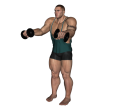 Wrist Twist - Standing Dumbbell Two Wrist
Wrist Twist - Standing Dumbbell Two Wrist
Benefits: This exercise focuses on the wrist adductors, a muscle group that hardly is ever exercised in the gym.
Purpose: This exercise strengthens the muscles that adduct the wrist.
Beginner Forearms Strength Single Ended Dumbbell Pull Gym
General Info: A complete forearm program must achieve balanced development for all major forearm muscles. The forearm is involved in six different forearm movements. They include wrist flexion, wrist extension, wrist abduction, wrist adduction, forearm pronation, and forearm supination. There are additional muscles found in the forearm that are involved in movements like elbow flexion (brachioradialis), finger flexion, and finger extension.
 Wrist Twist - Standing Water Bottle One Wrist
Wrist Twist - Standing Water Bottle One Wrist
Benefits: This exercise focuses on the wrist adductors, a muscle group that hardly is ever exercised in the gym.
Purpose: This exercise strengthens the muscles that adduct the wrist.
Beginner Forearms Strength Water Bottle Pull Home
General Info: A complete forearm program must achieve balanced development for all major forearm muscles. The forearm is involved in six different forearm movements. They include wrist flexion, wrist extension, wrist abduction, wrist adduction, forearm pronation, and forearm supination. There are additional muscles found in the forearm that are involved in movements like elbow flexion (brachioradialis), finger flexion, and finger extension.
 Wrist Twist - Standing Water Bottle Two Wrist
Wrist Twist - Standing Water Bottle Two Wrist
Benefits: This exercise focuses on the wrist adductors, a muscle group that hardly is ever exercised in the gym.
Purpose: This exercise strengthens the muscles that adduct the wrist.
Beginner Forearms Strength Water Bottle Pull Home
General Info: A complete forearm program must achieve balanced development for all major forearm muscles. The forearm is involved in six different forearm movements. They include wrist flexion, wrist extension, wrist abduction, wrist adduction, forearm pronation, and forearm supination. There are additional muscles found in the forearm that are involved in movements like elbow flexion (brachioradialis), finger flexion, and finger extension.
 Wrist Twist - Water Bottle
Wrist Twist - Water Bottle
Benefits: This exercise focuses on the wrist adductors, a muscle group that hardly is ever exercised in the gym.
Purpose: This exercise strengthens the muscles that adduct the wrist.
Beginner Forearms Strength Water Bottle Chair Pull Home
General Info: A complete forearm program must achieve balanced development for all major forearm muscles. The forearm is involved in six different forearm movements. They include wrist flexion, wrist extension, wrist abduction, wrist adduction, forearm pronation, and forearm supination. There are additional muscles found in the forearm that are involved in movements like elbow flexion (brachioradialis), finger flexion, and finger extension.
 Yoke Walk - Basic
Yoke Walk - Basic
Benefits: This exercise involves many other muscles.
Purpose: This exercise builds overall strength in the lower body.
Lower Back Glutes Hamstrings Calves Quads Forearms Lats Middle Back Traps Strength Yoke Pull Compound Gym
General Info: The muscles of the lower back straighten the spine. They work together with the abdominals to keep the spine upright. The Barbell Deadlift is considered to be the king of exercises. No other exercise will work your body so much.
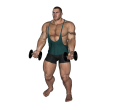 Zottman Curl - Basic
Zottman Curl - Basic
Benefits: This exercise works both heads of the biceps as well as muscles involved in rotating the forearm.
Purpose: This exercise is used to target the biceps muscle to develop size, definition, strength, endurance and power.
Beginner Biceps Forearms Shoulders Strength Dumbbell Pull Gym
General Info: The biceps is a straight muscle with two heads. The long head of the biceps crosses both the elbow and the shoulder joint. It bends the elbow and raises the arm forward at the shoulder. The short head crosses the elbow joint and, in conjunction with the brachioradialis, supinates the hand.
 Zottman Curl - Basic Water Bottle
Zottman Curl - Basic Water Bottle
Benefits: This exercise works both heads of the biceps with a heavier weight than can typically be done with dumbbells.
Purpose: This exercise is used to target the biceps muscle to develop size, definition, strength, endurance and power.
Beginner Biceps Forearms Shoulders Strength Water Bottle Pull Home
General Info: The biceps is a straight muscle with two heads. The long head of the biceps crosses both the elbow and the shoulder joint. It bends the elbow and raises the arm forward at the shoulder. The short head crosses the elbow joint and, in conjunction with the brachioradialis, supinates the hand.
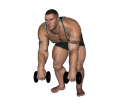 Zottman Curl - Bent Over Dumbbell
Zottman Curl - Bent Over Dumbbell
Benefits: This exercise does a good job of placing maximum tension on the biceps in the fully contracted position and also supinates the forearm.
Purpose: This exercise works the biceps muscles but focuses also on the brachioradialis (a muscle that crosses the elbow joint and assists in rotating the forearm).
Beginner Biceps Forearms Shoulders Strength Dumbbell Pull Gym
General Info: The biceps is a straight muscle which has two heads. The long head crosses both the elbow and the shoulder joints. It bends the arm at the elbow and raises the arm forward at the shoulder. The short head crosses the elbow joint and, in conjunction with the brachioradialis, supinates the hand.
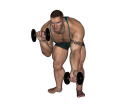 Zottman Curl - Bent Over Dumbbell Alternate
Zottman Curl - Bent Over Dumbbell Alternate
Benefits: This exercise does a good job of placing maximum tension on the biceps in the fully contracted position and also supinates the forearm.
Purpose: This exercise works the biceps muscles but focuses also on the brachioradialis (a muscle that crosses the elbow joint and assists in rotating the forearm).
Beginner Biceps Forearms Shoulders Strength Dumbbell Pull Gym
General Info: The biceps is a straight muscle which has two heads. The long head crosses both the elbow and the shoulder joints. It bends the arm at the elbow and raises the arm forward at the shoulder. The short head crosses the elbow joint and, in conjunction with the brachioradialis, supinates the hand.
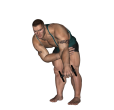 Zottman Curl - Bent Over Dumbbell Single
Zottman Curl - Bent Over Dumbbell Single
Benefits: This exercise does a good job of placing maximum tension on the biceps in the fully contracted position and also supinates the forearm.
Purpose: This exercise works the biceps muscles but focuses also on the brachioradialis (a muscle that crosses the elbow joint and assists in rotating the forearm).
Beginner Biceps Forearms Shoulders Strength Dumbbell Pull Gym
General Info: The biceps is a straight muscle which has two heads. The long head crosses both the elbow and the shoulder joints. It bends the arm at the elbow and raises the arm forward at the shoulder. The short head crosses the elbow joint and, in conjunction with the brachioradialis, supinates the hand.
 Zottman Curl - Bent Over Water Bottle
Zottman Curl - Bent Over Water Bottle
Benefits: This exercise does a good job of placing maximum tension on the biceps in the fully contracted position and also supinates the forearm..
Purpose: This exercise works the biceps muscles but focuses also on the brachioradialis (a muscle that crosses the elbow joint and assists in rotating the forearm).
Beginner Biceps Forearms Shoulders Strength Water Bottle Pull Home
General Info: The biceps is a straight muscle which has two heads. The long head crosses both the elbow and the shoulder joints. It bends the arm at the elbow and raises the arm forward at the shoulder. The short head crosses the elbow joint and, in conjunction with the brachioradialis, supinates the hand.
 Zottman Curl - Bent Over Water Bottle Alternate
Zottman Curl - Bent Over Water Bottle Alternate
Benefits: This exercise does a good job of placing maximum tension on the biceps in the fully contracted position and also supinates the forearm..
Purpose: This exercise works the biceps muscles but focuses also on the brachioradialis (a muscle that crosses the elbow joint and assists in rotating the forearm).
Beginner Biceps Forearms Shoulders Strength Water Bottle Pull Home
General Info: The biceps is a straight muscle which has two heads. The long head crosses both the elbow and the shoulder joints. It bends the arm at the elbow and raises the arm forward at the shoulder. The short head crosses the elbow joint and, in conjunction with the brachioradialis, supinates the hand.
 Zottman Curl - Bent Over Water Bottle Single
Zottman Curl - Bent Over Water Bottle Single
Benefits: This exercise does a good job of placing maximum tension on the biceps in the fully contracted position and also supinates the forearm..
Purpose: This exercise works the biceps muscles but focuses also on the brachioradialis (a muscle that crosses the elbow joint and assists in rotating the forearm).
Beginner Biceps Forearms Shoulders Strength Water Bottle Pull Home
General Info: The biceps is a straight muscle which has two heads. The long head crosses both the elbow and the shoulder joints. It bends the arm at the elbow and raises the arm forward at the shoulder. The short head crosses the elbow joint and, in conjunction with the brachioradialis, supinates the hand.
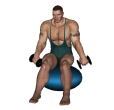 Zottman Curl - Fitness Ball
Zottman Curl - Fitness Ball
Benefits: This exercise isolates the biceps so that momentum does not come into play. The rotation in this exercise works the forearm muscles.
Purpose: This exercise strengthens the biceps.
Beginner Biceps Forearms Shoulders Traps Strength Dumbbell Fitness Ball Pull Gym
General Info: The biceps muscle is a straight muscle with 2 heads. The long head crosses both the elbow and shoulder joints and bends the elbow and raises the arm forward at the shoulder. The short head of the biceps crosses the elbow joint and, in conjunction with the brachioradialis, supinates the hand.
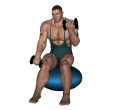 Zottman Curl - Fitness Ball Dumbbell Alternate
Zottman Curl - Fitness Ball Dumbbell Alternate
Benefits: This exercise works both heads of the biceps. The rotation in this exercise works the forearm muscles.
Purpose: This exercise is used to target the biceps muscle to develop size, definition, strength, endurance and power.
Beginner Biceps Forearms Shoulders Strength Dumbbell Fitness Ball Pull Gym
General Info: The biceps is a straight muscle with two heads. The long head of the biceps crosses both the elbow and the shoulder joint. It bends the elbow and raises the arm forward at the shoulder. The short head crosses the elbow joint and, in conjunction with the brachioradialis, supinates the hand.
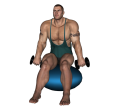 Zottman Curl - Fitness Ball Dumbbell Narrow
Zottman Curl - Fitness Ball Dumbbell Narrow
Benefits: This exercise isolates the biceps so that momentum does not come into play.
Purpose: This exercise strengthens the biceps.
Beginner Biceps Forearms Shoulders Traps Strength Dumbbell Fitness Ball Pull Gym
General Info: The biceps muscle is a straight muscle with 2 heads. The long head crosses both the elbow and shoulder joints and bends the elbow and raises the arm forward at the shoulder. The short head of the biceps crosses the elbow joint and, in conjunction with the brachioradialis, supinates the hand.
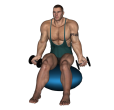 Zottman Curl - Fitness Ball Dumbbell Reverse
Zottman Curl - Fitness Ball Dumbbell Reverse
Benefits: This exercise isolates the biceps so that momentum does not come into play. The rotation in this exercise works the forearm muscles.
Purpose: This exercise strengthens the biceps.
Beginner Biceps Forearms Shoulders Traps Strength Dumbbell Fitness Ball Pull Gym
General Info: The biceps muscle is a straight muscle with 2 heads. The long head crosses both the elbow and shoulder joints and bends the elbow and raises the arm forward at the shoulder. The short head of the biceps crosses the elbow joint and, in conjunction with the brachioradialis, supinates the hand..
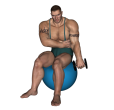 Zottman Curl - Fitness Ball Single
Zottman Curl - Fitness Ball Single
Benefits: This exercise works both heads of the biceps with a heavier weight than can typically be done with dumbbells.
Purpose: This exercise is used to target the biceps muscle to develop size, definition, strength, endurance and power.
Beginner Biceps Forearms Shoulders Strength Dumbbell Fitness Ball Pull Gym
General Info: The biceps is a straight muscle with two heads. The long head of the biceps crosses both the elbow and the shoulder joint. It bends the elbow and raises the arm forward at the shoulder. The short head crosses the elbow joint and, in conjunction with the brachioradialis, supinates the hand.
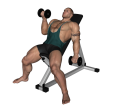 Zottman Curl - Incline Alternate
Zottman Curl - Incline Alternate
Benefits: This exercise works both heads of the biceps along with the brachioradialis muscle.
Purpose: This exercise is used to target the biceps muscle to develop size, definition, strength, endurance and power.
Beginner Biceps Forearms Strength Dumbbell Incline Bench Pull Gym
General Info: The biceps is a straight muscle with two heads. The long head of the biceps crosses both the elbow and the shoulder joint. It bends the elbow and raises the arm forward at the shoulder. The short head crosses the elbow joint and, in conjunction with the brachioradialis, supinates the hand.
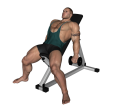 Zottman Curl - Incline Dumbbell
Zottman Curl - Incline Dumbbell
Benefits: This exercise works both heads of the biceps along with the brachioradialis muscle.
Purpose: This exercise is used to target the biceps muscle to develop size, definition, strength, endurance and power.
Beginner Biceps Forearms Strength Dumbbell Pull Gym
General Info: The biceps is a straight muscle with two heads. The long head of the biceps crosses both the elbow and the shoulder joint. It bends the elbow and raises the arm forward at the shoulder. The short head crosses the elbow joint and, in conjunction with the brachioradialis, supinates the hand.
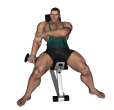 Zottman Curl - Incline Single
Zottman Curl - Incline Single
Benefits: This exercise works both heads of the biceps along with the brachioradialis muscle.
Purpose: This exercise is used to target the biceps muscle to develop size, definition, strength, endurance and power.
Beginner Biceps Forearms Shoulders Strength Dumbbell Pull Gym
General Info: The biceps is a straight muscle with two heads. The long head of the biceps crosses both the elbow and the shoulder joint. It bends the elbow and raises the arm forward at the shoulder. The short head crosses the elbow joint and, in conjunction with the brachioradialis, supinates the hand.
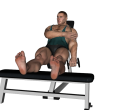 Zottman Curl - Incline Single Feet Up
Zottman Curl - Incline Single Feet Up
Benefits: This exercise works both heads of the biceps along with the brachioradialis muscle.
Purpose: This exercise is used to target the biceps muscle to develop size, definition, strength, endurance and power.
Beginner Biceps Forearms Shoulders Strength Dumbbell Incline Bench Flat Bench Pull Gym
General Info: The biceps is a straight muscle with two heads. The long head of the biceps crosses both the elbow and the shoulder joint. It bends the elbow and raises the arm forward at the shoulder. The short head crosses the elbow joint and, in conjunction with the brachioradialis, supinates the hand.
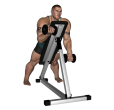 Zottman Curl - Overhang Alternate
Zottman Curl - Overhang Alternate
Benefits: This exercise works both heads of the biceps along with the brachioradialis muscle.
Purpose: This exercise works the biceps muscles.
Beginner Biceps Forearms Strength Dumbbell Incline Bench Pull Gym
General Info: The biceps muscle is a straight muscle with 2 heads. The long head crosses both the elbow and shoulder joints and bends the elbow and raises the arm forward at the shoulder. The short head of the biceps crosses the elbow joint and, in conjunction with the brachioradialis, supinates the hand.
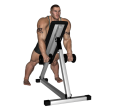 Zottman Curl - Overhang Dumbbell
Zottman Curl - Overhang Dumbbell
Benefits: This exercise works both heads of the biceps along with the brachioradialis muscle.
Purpose: This exercise works the biceps muscles.
Beginner Biceps Forearms Strength Dumbbell Incline Bench Pull Gym
General Info: The biceps muscle is a straight muscle with 2 heads. The long head crosses both the elbow and shoulder joints and bends the elbow and raises the arm forward at the shoulder. The short head of the biceps crosses the elbow joint and, in conjunction with the brachioradialis, supinates the hand.
 Zottman Curl - Overhang Single Dumbbell
Zottman Curl - Overhang Single Dumbbell
Benefits: This exercise is similar in effect to the Spider curl and does a good job of placing maximum tension on the biceps in the fully contracted position.
Purpose: This exercise works the biceps muscles.
Beginner Biceps Forearms Strength Dumbbell Incline Bench Pull Gym
General Info: The biceps muscle is a straight muscle with 2 heads. The long head crosses both the elbow and shoulder joints and bends the elbow and raises the arm forward at the shoulder. The short head of the biceps crosses the elbow joint and, in conjunction with the brachioradialis, supinates the hand.
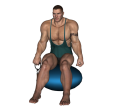 Zottman Curl - Resistance Ball Single
Zottman Curl - Resistance Ball Single
Benefits: This exercise works both heads of the biceps along with the brachioradialis muscle.
Purpose: This exercise strengthens the biceps.
Beginner Biceps Forearms Strength Fitness Ball Resistance Tube Pull Gym
General Info: The biceps muscle is a straight muscle with 2 heads. The long head crosses both the elbow and shoulder joints and bends the elbow and raises the arm forward at the shoulder. The short head of the biceps crosses the elbow joint and, in conjunction with the brachioradialis, supinates the hand..
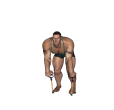 Zottman Curl - Resistance Bent Over Alternate
Zottman Curl - Resistance Bent Over Alternate
Benefits: This exercise does a good job of placing maximum tension on the biceps in the fully contracted position and also supinates the forearm.
Purpose: This exercise works the biceps muscles but focuses also on the brachioradialis (a muscle that crosses the elbow joint and assists in rotating the forearm).
Beginner Biceps Forearms Shoulders Strength Resistance Tube Pull Gym
General Info: The biceps is a straight muscle which has two heads. The long head crosses both the elbow and the shoulder joints. It bends the arm at the elbow and raises the arm forward at the shoulder. The short head crosses the elbow joint and, in conjunction with the brachioradialis, supinates the hand.
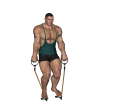 Zottman Curl - Resistance Standing Alternate
Zottman Curl - Resistance Standing Alternate
Benefits: This exercise does a good job of placing maximum tension on the biceps in the fully contracted position and also supinates the forearm.
Purpose: This exercise works the biceps muscles but focuses also on the brachioradialis (a muscle that crosses the elbow joint and assists in rotating the forearm).
Beginner Biceps Forearms Shoulders Strength Resistance Tube Pull Gym
General Info: The biceps is a straight muscle with two heads. The long head of the biceps crosses both the elbow and the shoulder joint. It bends the elbow and raises the arm forward at the shoulder. The short head crosses the elbow joint and, in conjunction with the brachioradialis, supinates the hand.
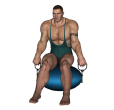 Zottman Curl - Resistance Tube Ball
Zottman Curl - Resistance Tube Ball
Benefits: This exercise does a good job of placing maximum tension on the biceps in the fully contracted position and also supinates the forearm.
Purpose: This exercise works the biceps muscles but focuses also on the brachioradialis (a muscle that crosses the elbow joint and assists in rotating the forearm).
Beginner Biceps Forearms Strength Fitness Ball Resistance Tube Pull Gym
General Info: The biceps muscle is a straight muscle with 2 heads. The long head crosses both the elbow and shoulder joints and bends the elbow and raises the arm forward at the shoulder. The short head of the biceps crosses the elbow joint and, in conjunction with the brachioradialis, supinates the hand..
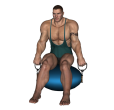 Zottman Curl - Resistance Tube Ball Alternate
Zottman Curl - Resistance Tube Ball Alternate
Benefits: This exercise does a good job of placing maximum tension on the biceps in the fully contracted position and also supinates the forearm.
Purpose: This exercise works the biceps muscles but focuses also on the brachioradialis (a muscle that crosses the elbow joint and assists in rotating the forearm).
Beginner Biceps Forearms Strength Fitness Ball Resistance Tube Pull Gym
General Info: The biceps muscle is a straight muscle with 2 heads. The long head crosses both the elbow and shoulder joints and bends the elbow and raises the arm forward at the shoulder. The short head of the biceps crosses the elbow joint and, in conjunction with the brachioradialis, supinates the hand..
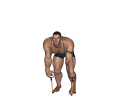 Zottman Curl - Resistance Tube Bent Over
Zottman Curl - Resistance Tube Bent Over
Benefits: This exercise does a good job of placing maximum tension on the biceps in the fully contracted position and also supinates the forearm.
Purpose: This exercise works the biceps muscles but focuses also on the brachioradialis (a muscle that crosses the elbow joint and assists in rotating the forearm).
Beginner Biceps Forearms Shoulders Strength Resistance Tube Pull Gym
General Info: The biceps is a straight muscle which has two heads. The long head crosses both the elbow and the shoulder joints. It bends the arm at the elbow and raises the arm forward at the shoulder. The short head crosses the elbow joint and, in conjunction with the brachioradialis, supinates the hand.
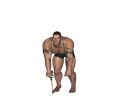 Zottman Curl - Resistance Tube Bent Over Single
Zottman Curl - Resistance Tube Bent Over Single
Benefits: This exercise does a good job of placing maximum tension on the biceps in the fully contracted position and also supinates the forearm.
Purpose: This exercise works the biceps muscles but focuses also on the brachioradialis (a muscle that crosses the elbow joint and assists in rotating the forearm).
Beginner Biceps Forearms Strength Resistance Tube Pull Gym
General Info: The biceps muscle is a straight muscle with 2 heads. The long head crosses both the elbow and shoulder joints and bends the elbow and raises the arm forward at the shoulder. The short head of the biceps crosses the elbow joint and, in conjunction with the brachioradialis, supinates the hand..
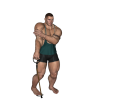 Zottman Curl - Resistance Tube Single
Zottman Curl - Resistance Tube Single
Benefits: This exercise does a good job of placing maximum tension on the biceps in the fully contracted position and also supinates the forearm.
Purpose: This exercise works the biceps muscles but focuses also on the brachioradialis (a muscle that crosses the elbow joint and assists in rotating the forearm).
Beginner Biceps Forearms Shoulders Strength Resistance Tube Pull Gym
General Info: The biceps is a straight muscle with two heads. The long head of the biceps crosses both the elbow and the shoulder joint. It bends the elbow and raises the arm forward at the shoulder. The short head crosses the elbow joint and, in conjunction with the brachioradialis, supinates the hand.
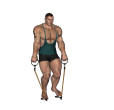 Zottman Curl - Resistance Tube Standing
Zottman Curl - Resistance Tube Standing
Benefits: This exercise does a good job of placing maximum tension on the biceps in the fully contracted position and also supinates the forearm.
Purpose: This exercise works the biceps muscles but focuses also on the brachioradialis (a muscle that crosses the elbow joint and assists in rotating the forearm).
Beginner Biceps Forearms Shoulders Strength Resistance Tube Pull Gym
General Info: The biceps is a straight muscle with two heads. The long head of the biceps crosses both the elbow and the shoulder joint. It bends the elbow and raises the arm forward at the shoulder. The short head crosses the elbow joint and, in conjunction with the brachioradialis, supinates the hand.
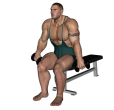 Zottman Curl - Seated Dumbbell
Zottman Curl - Seated Dumbbell
Benefits: This exercise works both heads of the biceps as well as muscles involved in rotating the forearm.
Purpose: This exercise strengthens the biceps.
Beginner Biceps Forearms Shoulders Traps Strength Dumbbell Flat Bench Pull Gym
General Info: The biceps muscle is a straight muscle with 2 heads. The long head crosses both the elbow and shoulder joints and bends the elbow and raises the arm forward at the shoulder. The short head of the biceps crosses the elbow joint and, in conjunction with the brachioradialis, supinates the hand.
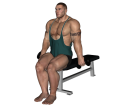 Zottman Curl - Seated Dumbbell Narrow Stance
Zottman Curl - Seated Dumbbell Narrow Stance
Benefits: This exercise does a good job of placing maximum tension on the biceps in the fully contracted position and also supinates the forearm.
Purpose: This exercise works the biceps muscles but focuses also on the brachioradialis (a muscle that crosses the elbow joint and assists in rotating the forearm).
Beginner Biceps Forearms Shoulders Traps Strength Dumbbell Flat Bench Pull Gym
General Info: The biceps muscle is a straight muscle with 2 heads. The long head crosses both the elbow and shoulder joints and bends the elbow and raises the arm forward at the shoulder. The short head of the biceps crosses the elbow joint and, in conjunction with the brachioradialis, supinates the hand.
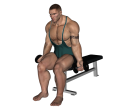 Zottman Curl - Seated Dumbbell Reverse
Zottman Curl - Seated Dumbbell Reverse
Benefits: This exercise does a good job of placing maximum tension on the biceps in the fully contracted position and also supinates the forearm.
Purpose: This exercise works the biceps muscles but focuses also on the brachioradialis (a muscle that crosses the elbow joint and assists in rotating the forearm).
Beginner Biceps Forearms Shoulders Traps Strength Dumbbell Flat Bench Pull Gym
General Info: The biceps muscle is a straight muscle with 2 heads. The long head crosses both the elbow and shoulder joints and bends the elbow and raises the arm forward at the shoulder. The short head of the biceps crosses the elbow joint and, in conjunction with the brachioradialis, supinates the hand.
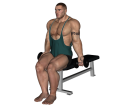 Zottman Curl - Seated Dumbbell Reverse Narrow
Zottman Curl - Seated Dumbbell Reverse Narrow
Benefits: This exercise works both heads of the biceps as well as muscles involved in rotating the forearm.
Purpose: This exercise strengthens the biceps.
Beginner Biceps Forearms Shoulders Traps Strength Dumbbell Flat Bench Pull Gym
General Info: The biceps muscle is a straight muscle with 2 heads. The long head crosses both the elbow and shoulder joints and bends the elbow and raises the arm forward at the shoulder. The short head of the biceps crosses the elbow joint and, in conjunction with the brachioradialis, supinates the hand..
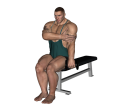 Zottman Curl - Seated Dumbbell Single Narrow
Zottman Curl - Seated Dumbbell Single Narrow
Benefits: This exercise does a good job of placing maximum tension on the biceps in the fully contracted position and also supinates the forearm.
Purpose: This exercise works the biceps muscles but focuses also on the brachioradialis (a muscle that crosses the elbow joint and assists in rotating the forearm).
Beginner Biceps Forearms Shoulders Strength Dumbbell Flat Bench Pull Gym
General Info: The biceps is a straight muscle with two heads. The long head of the biceps crosses both the elbow and the shoulder joint. It bends the elbow and raises the arm forward at the shoulder. The short head crosses the elbow joint and, in conjunction with the brachioradialis, supinates the hand.
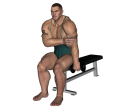 Zottman Curl - Seated Single Dumbbell
Zottman Curl - Seated Single Dumbbell
Benefits: This exercise does a good job of placing maximum tension on the biceps in the fully contracted position and also supinates the forearm.
Purpose: This exercise works the biceps muscles but focuses also on the brachioradialis (a muscle that crosses the elbow joint and assists in rotating the forearm).
Beginner Biceps Forearms Shoulders Strength Dumbbell Flat Bench Pull Gym
General Info: The biceps is a straight muscle with two heads. The long head of the biceps crosses both the elbow and the shoulder joint. It bends the elbow and raises the arm forward at the shoulder. The short head crosses the elbow joint and, in conjunction with the brachioradialis, supinates the hand.
 Zottman Curl - Seated Water Bottle
Zottman Curl - Seated Water Bottle
Benefits: This exercise isolates the biceps so that momentum does not come into play.
Purpose: This exercise strengthens the biceps.
Beginner Biceps Forearms Shoulders Traps Strength Water Bottle Chair Pull Home
General Info: The biceps muscle is a straight muscle with 2 heads. The long head crosses both the elbow and shoulder joints and bends the elbow and raises the arm forward at the shoulder. The short head of the biceps crosses the elbow joint and, in conjunction with the brachioradialis, supinates the hand.
 Zottman Curl - Seated Water Bottle Narrow Stance
Zottman Curl - Seated Water Bottle Narrow Stance
Benefits: This exercise isolates the biceps so that momentum does not come into play.
Purpose: This exercise strengthens the biceps.
Beginner Biceps Forearms Shoulders Traps Strength Water Bottle Chair Pull Home
General Info: The biceps muscle is a straight muscle with 2 heads. The long head crosses both the elbow and shoulder joints and bends the elbow and raises the arm forward at the shoulder. The short head of the biceps crosses the elbow joint and, in conjunction with the brachioradialis, supinates the hand.
 Zottman Curl - Seated Water Bottle Reverse
Zottman Curl - Seated Water Bottle Reverse
Benefits: This exercise isolates the biceps so that momentum does not come into play.
Purpose: This exercise strengthens the biceps.
Beginner Biceps Forearms Shoulders Traps Strength Water Bottle Chair Pull Home
General Info: The biceps muscle is a straight muscle with 2 heads. The long head crosses both the elbow and shoulder joints and bends the elbow and raises the arm forward at the shoulder. The short head of the biceps crosses the elbow joint and, in conjunction with the brachioradialis, supinates the hand.
 Zottman Curl - Seated Water Bottle Reverse Narrow
Zottman Curl - Seated Water Bottle Reverse Narrow
Benefits: This exercise isolates the biceps so that momentum does not come into play.
Purpose: This exercise strengthens the biceps.
Beginner Biceps Forearms Shoulders Traps Strength Water Bottle Chair Pull Home
General Info: The biceps muscle is a straight muscle with 2 heads. The long head crosses both the elbow and shoulder joints and bends the elbow and raises the arm forward at the shoulder. The short head of the biceps crosses the elbow joint and, in conjunction with the brachioradialis, supinates the hand.
 Zottman Curl - Seated Water Bottle Single Narrow
Zottman Curl - Seated Water Bottle Single Narrow
Benefits: This exercise works both heads of the biceps with a heavier weight than can typically be done with dumbbells.
Purpose: This exercise is used to target the biceps muscle to develop size, definition, strength, endurance and power.
Beginner Biceps Forearms Shoulders Strength Water Bottle Chair Pull Home
General Info: The biceps is a straight muscle with two heads. The long head of the biceps crosses both the elbow and the shoulder joint. It bends the elbow and raises the arm forward at the shoulder. The short head crosses the elbow joint and, in conjunction with the brachioradialis, supinates the hand.
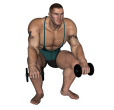 Zottman Curl - Squat Dumbbell
Zottman Curl - Squat Dumbbell
Benefits: This exercise isolates the biceps so that momentum does not come into play.
Purpose: This exercise strengthens the biceps.
Beginner Biceps Forearms Shoulders Traps Strength Dumbbell Pull Gym
General Info: The biceps muscle is a straight muscle with 2 heads. The long head crosses both the elbow and shoulder joints and bends the elbow and raises the arm forward at the shoulder. The short head of the biceps crosses the elbow joint and, in conjunction with the brachioradialis, supinates the hand.
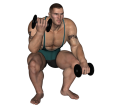 Zottman Curl - Squat Dumbbell Alternate
Zottman Curl - Squat Dumbbell Alternate
Benefits: This exercise isolates the biceps so that momentum does not come into play.
Purpose: This exercise strengthens the biceps.
Beginner Biceps Forearms Shoulders Traps Strength Dumbbell Pull Gym
General Info: The biceps muscle is a straight muscle with 2 heads. The long head crosses both the elbow and shoulder joints and bends the elbow and raises the arm forward at the shoulder. The short head of the biceps crosses the elbow joint and, in conjunction with the brachioradialis, supinates the hand.
 Zottman Curl - Squat Dumbbell Single
Zottman Curl - Squat Dumbbell Single
Benefits: This exercise isolates the biceps so that momentum does not come into play.
Purpose: This exercise strengthens the biceps.
Beginner Biceps Forearms Shoulders Traps Strength Dumbbell Pull Gym
General Info: The biceps muscle is a straight muscle with 2 heads. The long head crosses both the elbow and shoulder joints and bends the elbow and raises the arm forward at the shoulder. The short head of the biceps crosses the elbow joint and, in conjunction with the brachioradialis, supinates the hand.
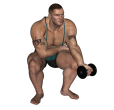 Zottman Curl - Squat Dumbbell Single Variation
Zottman Curl - Squat Dumbbell Single Variation
Benefits: This exercise isolates the biceps so that momentum does not come into play.
Purpose: This exercise strengthens the biceps.
Beginner Biceps Forearms Shoulders Traps Strength Dumbbell Pull Gym
General Info: The biceps muscle is a straight muscle with 2 heads. The long head crosses both the elbow and shoulder joints and bends the elbow and raises the arm forward at the shoulder. The short head of the biceps crosses the elbow joint and, in conjunction with the brachioradialis, supinates the hand.
 Zottman Curl - Squat Water Bottle
Zottman Curl - Squat Water Bottle
Benefits: This exercise isolates the biceps so that momentum does not come into play.
Purpose: This exercise strengthens the biceps.
Beginner Biceps Forearms Shoulders Traps Strength Water Bottle Pull Home
General Info: The biceps muscle is a straight muscle with 2 heads. The long head crosses both the elbow and shoulder joints and bends the elbow and raises the arm forward at the shoulder. The short head of the biceps crosses the elbow joint and, in conjunction with the brachioradialis, supinates the hand.
 Zottman Curl - Squat Water Bottle Alternate
Zottman Curl - Squat Water Bottle Alternate
Benefits: This exercise isolates the biceps so that momentum does not come into play.
Purpose: This exercise strengthens the biceps.
Beginner Biceps Forearms Shoulders Traps Strength Water Bottle Pull Home
General Info: The biceps muscle is a straight muscle with 2 heads. The long head crosses both the elbow and shoulder joints and bends the elbow and raises the arm forward at the shoulder. The short head of the biceps crosses the elbow joint and, in conjunction with the brachioradialis, supinates the hand.
 Zottman Curl - Squat Water Bottle Single
Zottman Curl - Squat Water Bottle Single
Benefits: This exercise isolates the biceps so that momentum does not come into play.
Purpose: This exercise strengthens the biceps.
Beginner Biceps Forearms Shoulders Traps Strength Water Bottle Pull Home
General Info: The biceps muscle is a straight muscle with 2 heads. The long head crosses both the elbow and shoulder joints and bends the elbow and raises the arm forward at the shoulder. The short head of the biceps crosses the elbow joint and, in conjunction with the brachioradialis, supinates the hand.
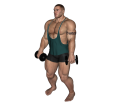 Zottman Curl - Standing Dumbbell
Zottman Curl - Standing Dumbbell
Benefits: This exercise does a good job of placing maximum tension on the biceps in the fully contracted position and also supinates the forearm.
Purpose: This exercise works the biceps muscles but focuses also on the brachioradialis (a muscle that crosses the elbow joint and assists in rotating the forearm).
Beginner Biceps Forearms Shoulders Strength Dumbbell Pull Gym
General Info: The biceps is a straight muscle with two heads. The long head of the biceps crosses both the elbow and the shoulder joint. It bends the elbow and raises the arm forward at the shoulder. The short head crosses the elbow joint and, in conjunction with the brachioradialis, supinates the hand.
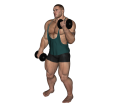 Zottman Curl - Standing Dumbbell Alternate
Zottman Curl - Standing Dumbbell Alternate
Benefits: This exercise does a good job of placing maximum tension on the biceps in the fully contracted position and also supinates the forearm.
Purpose: This exercise works the biceps muscles but focuses also on the brachioradialis (a muscle that crosses the elbow joint and assists in rotating the forearm).
Beginner Biceps Forearms Shoulders Strength Dumbbell Pull Gym
General Info: The biceps is a straight muscle with two heads. The long head of the biceps crosses both the elbow and the shoulder joint. It bends the elbow and raises the arm forward at the shoulder. The short head crosses the elbow joint and, in conjunction with the brachioradialis, supinates the hand.
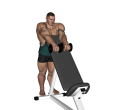 Zottman Curl - Standing Incline
Zottman Curl - Standing Incline
Benefits: This exercise works both heads of the biceps with a heavier weight than can typically be done with dumbbells.
Purpose: This exercise is used to target the biceps muscle to develop size, definition, strength, endurance and power.
Beginner Biceps Forearms Shoulders Strength Dumbbell Incline Bench Pull Gym
General Info: The biceps is a straight muscle with two heads. The long head of the biceps crosses both the elbow and the shoulder joint. It bends the elbow and raises the arm forward at the shoulder. The short head crosses the elbow joint and, in conjunction with the brachioradialis, supinates the hand.
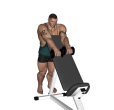 Zottman Curl - Standing Incline Alternate
Zottman Curl - Standing Incline Alternate
Benefits: This exercise does a good job of placing maximum tension on the biceps in the fully contracted position and also supinates the forearm.
Purpose: This exercise works the biceps muscles but focuses also on the brachioradialis (a muscle that crosses the elbow joint and assists in rotating the forearm).
Beginner Biceps Forearms Shoulders Strength Dumbbell Incline Bench Pull Gym
General Info: The biceps is a straight muscle with two heads. The long head of the biceps crosses both the elbow and the shoulder joint. It bends the elbow and raises the arm forward at the shoulder. The short head crosses the elbow joint and, in conjunction with the brachioradialis, supinates the hand.
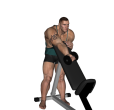 Zottman Curl - Standing Incline Single
Zottman Curl - Standing Incline Single
Benefits: This exercise does a good job of placing maximum tension on the biceps in the fully contracted position and also supinates the forearm.
Purpose: This exercise works the biceps muscles but focuses also on the brachioradialis (a muscle that crosses the elbow joint and assists in rotating the forearm).
Beginner Biceps Forearms Shoulders Strength Dumbbell Incline Bench Pull Gym
General Info: The biceps is a straight muscle with two heads. The long head of the biceps crosses both the elbow and the shoulder joint. It bends the elbow and raises the arm forward at the shoulder. The short head crosses the elbow joint and, in conjunction with the brachioradialis, supinates the hand.
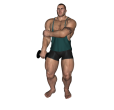 Zottman Curl - Standing Single Dumbbell
Zottman Curl - Standing Single Dumbbell
Benefits: This exercise does a good job of placing maximum tension on the biceps in the fully contracted position and also supinates the forearm.
Purpose: This exercise works the biceps muscles but focuses also on the brachioradialis (a muscle that crosses the elbow joint and assists in rotating the forearm).
Beginner Biceps Forearms Shoulders Strength Dumbbell Pull Gym
General Info: The biceps is a straight muscle with two heads. The long head of the biceps crosses both the elbow and the shoulder joint. It bends the elbow and raises the arm forward at the shoulder. The short head crosses the elbow joint and, in conjunction with the brachioradialis, supinates the hand.
 Zottman Curl - Standing Single Water Bottle
Zottman Curl - Standing Single Water Bottle
Benefits: This exercise works both heads of the biceps with a heavier weight than can typically be done with dumbbells.
Purpose: This exercise is used to target the biceps muscle to develop size, definition, strength, endurance and power.
Beginner Biceps Forearms Shoulders Strength Water Bottle Pull Home
General Info: The biceps is a straight muscle with two heads. The long head of the biceps crosses both the elbow and the shoulder joint. It bends the elbow and raises the arm forward at the shoulder. The short head crosses the elbow joint and, in conjunction with the brachioradialis, supinates the hand.
 Zottman Curl - Standing Water Bottle
Zottman Curl - Standing Water Bottle
Benefits: This exercise works both heads of the biceps with a heavier weight than can typically be done with dumbbells.
Purpose: This exercise is used to target the biceps muscle to develop size, definition, strength, endurance and power.
Beginner Biceps Forearms Shoulders Strength Water Bottle Pull Home
General Info: The biceps is a straight muscle with two heads. The long head of the biceps crosses both the elbow and the shoulder joint. It bends the elbow and raises the arm forward at the shoulder. The short head crosses the elbow joint and, in conjunction with the brachioradialis, supinates the hand.
 Zottman Curl - Standing Water Bottle Alternate
Zottman Curl - Standing Water Bottle Alternate
Benefits: This exercise works both heads of the biceps with a heavier weight than can typically be done with dumbbells.
Purpose: This exercise is used to target the biceps muscle to develop size, definition, strength, endurance and power.
Beginner Biceps Forearms Shoulders Strength Water Bottle Pull Home
General Info: The biceps is a straight muscle with two heads. The long head of the biceps crosses both the elbow and the shoulder joint. It bends the elbow and raises the arm forward at the shoulder. The short head crosses the elbow joint and, in conjunction with the brachioradialis, supinates the hand.
Could not find your favorite exercise in the list? Please start a discussion and post the name and the list of steps. We will try to add it as soon as we can.